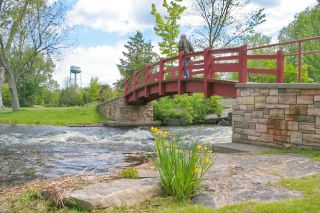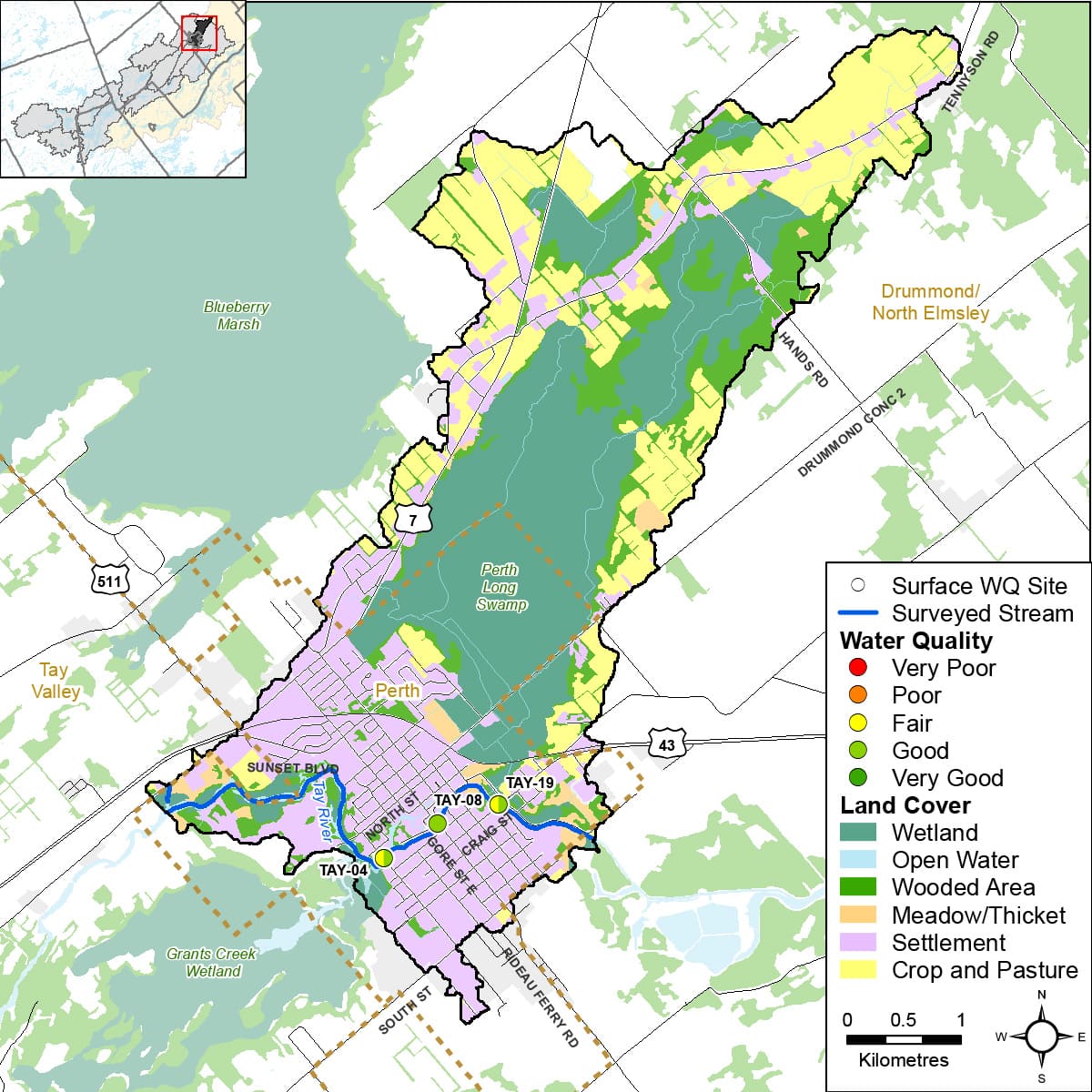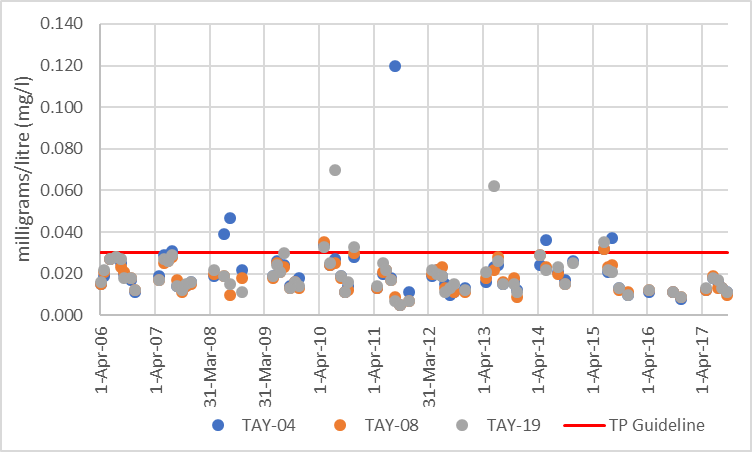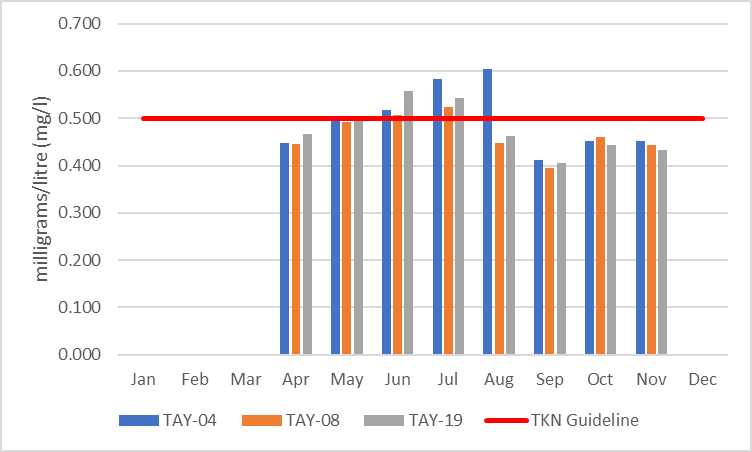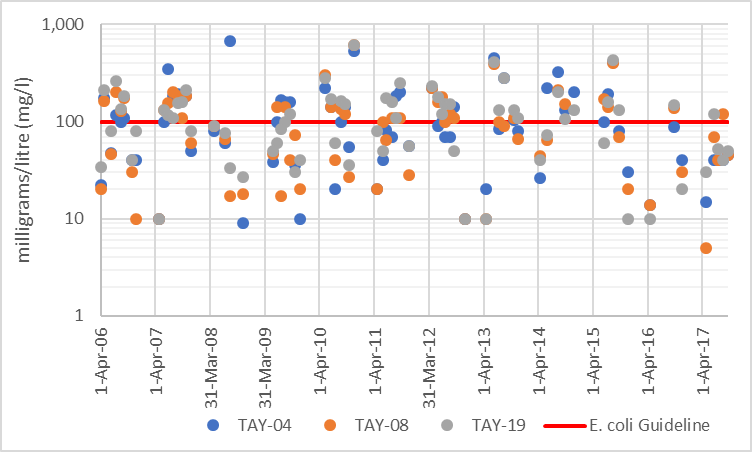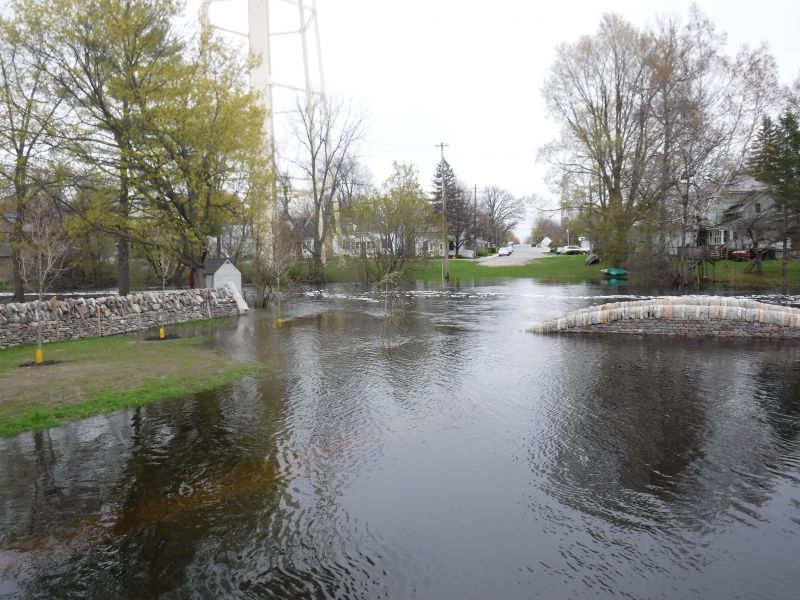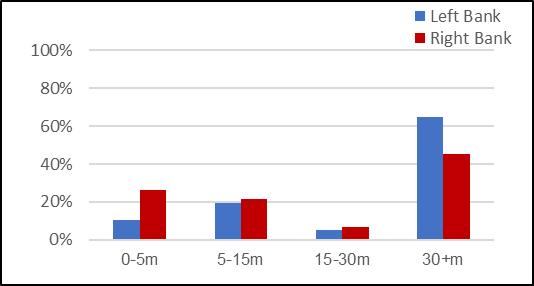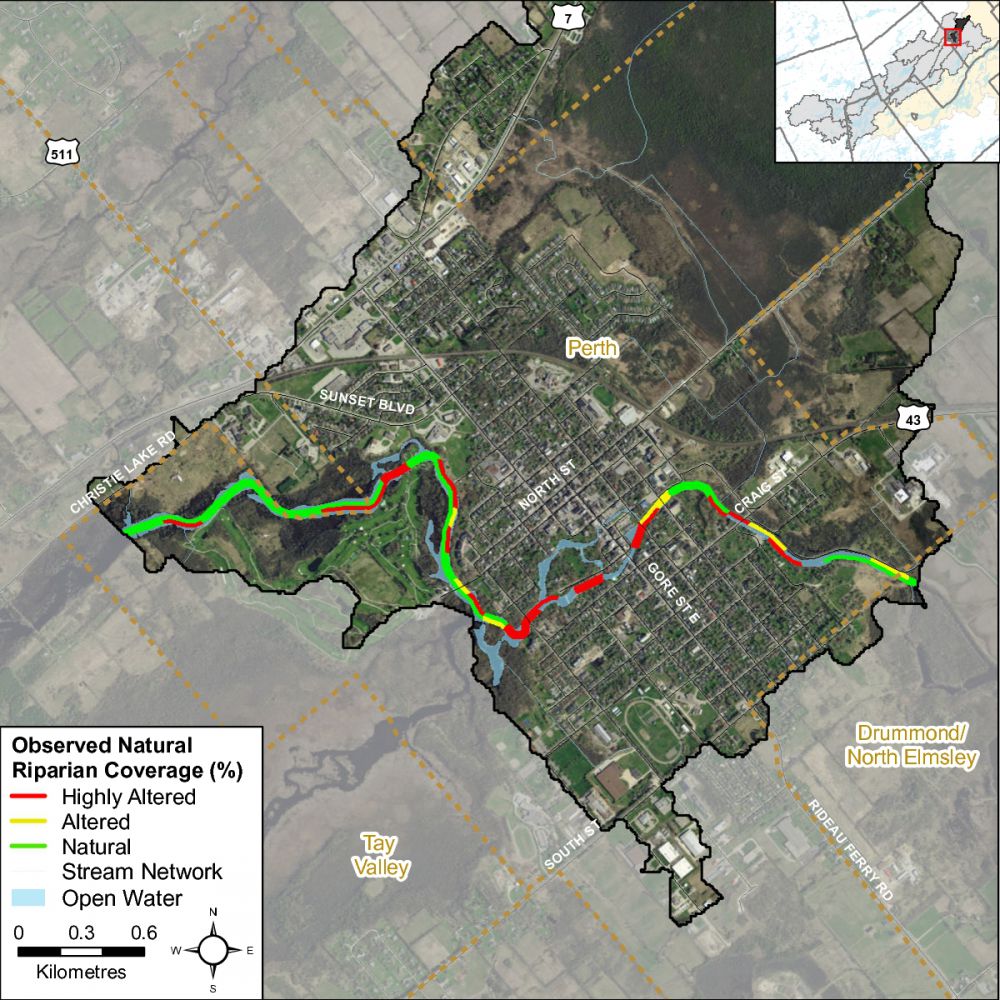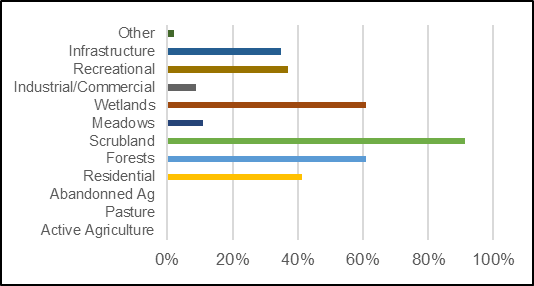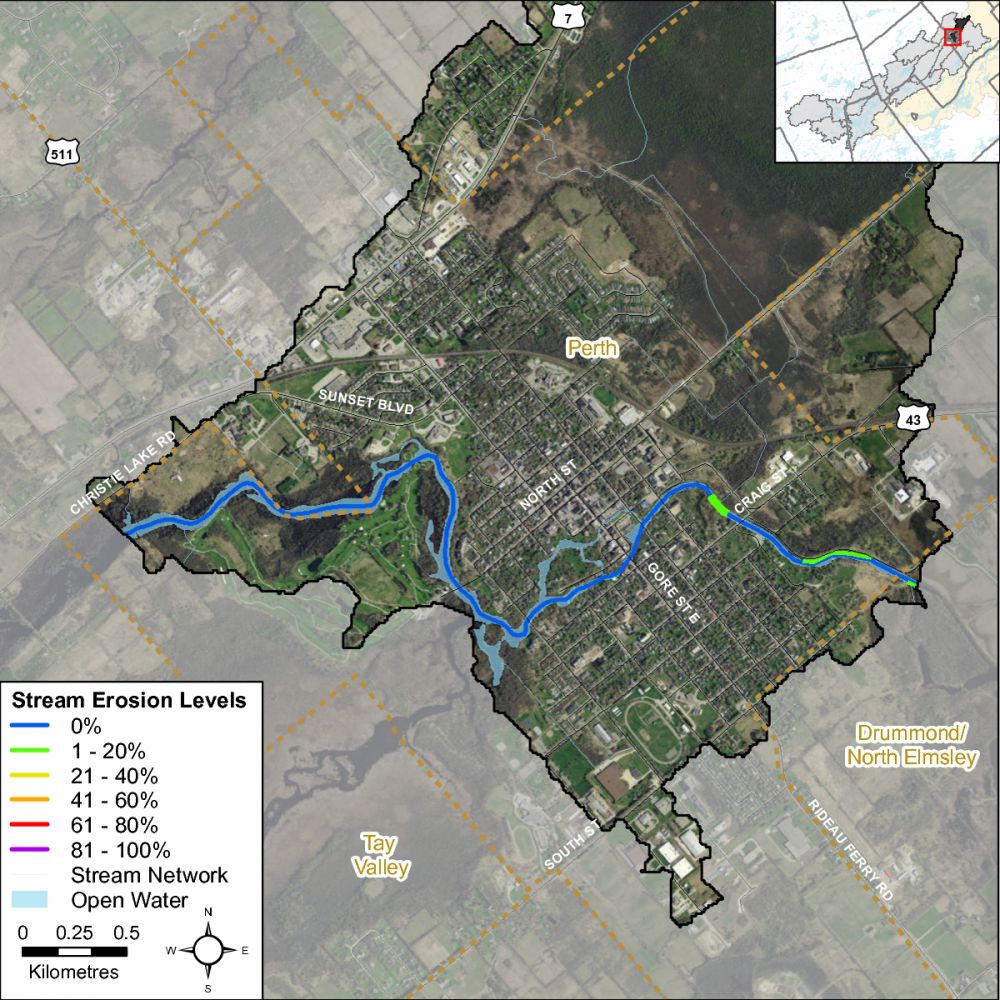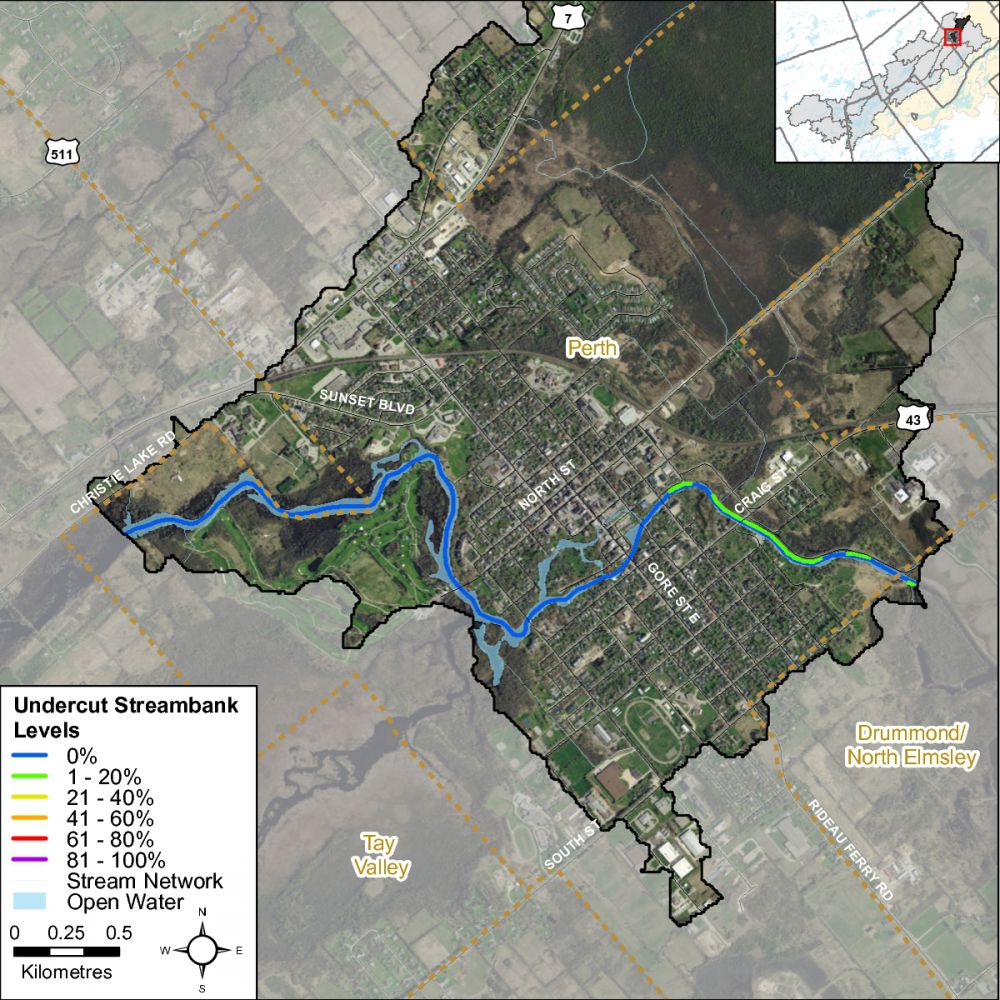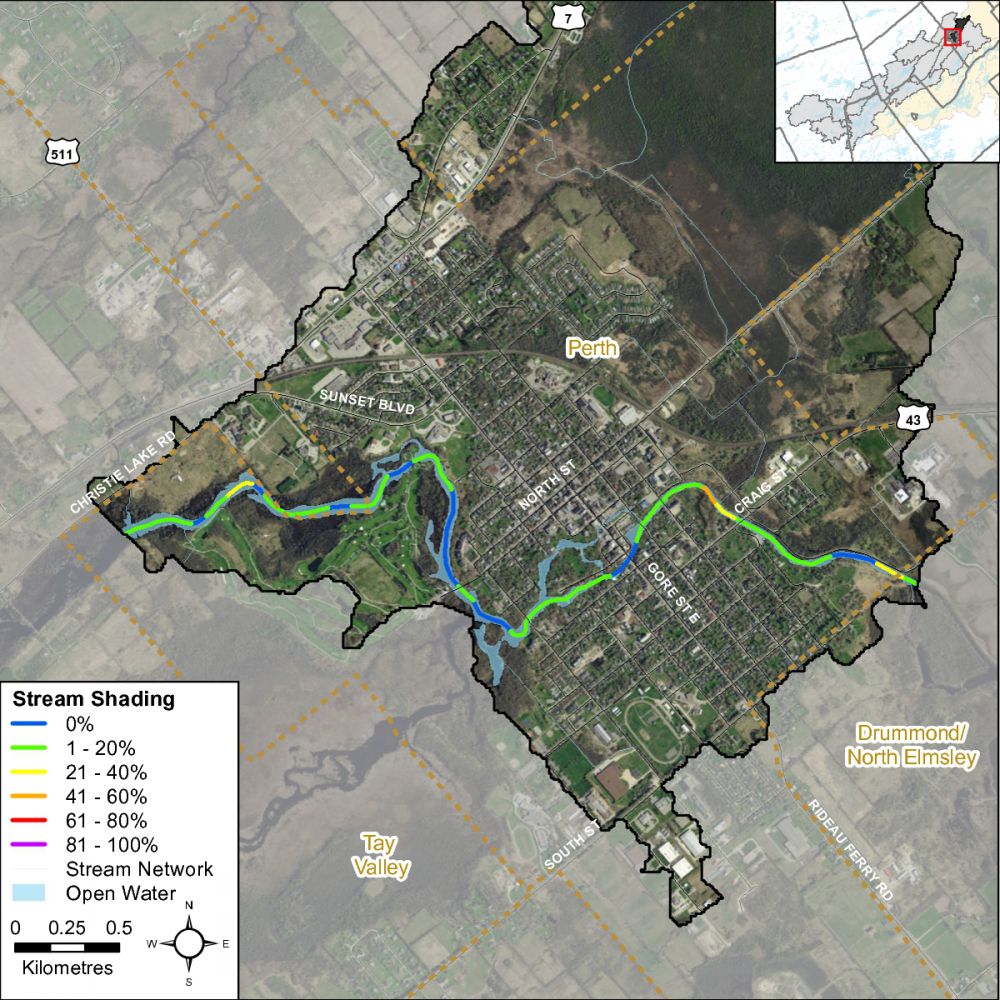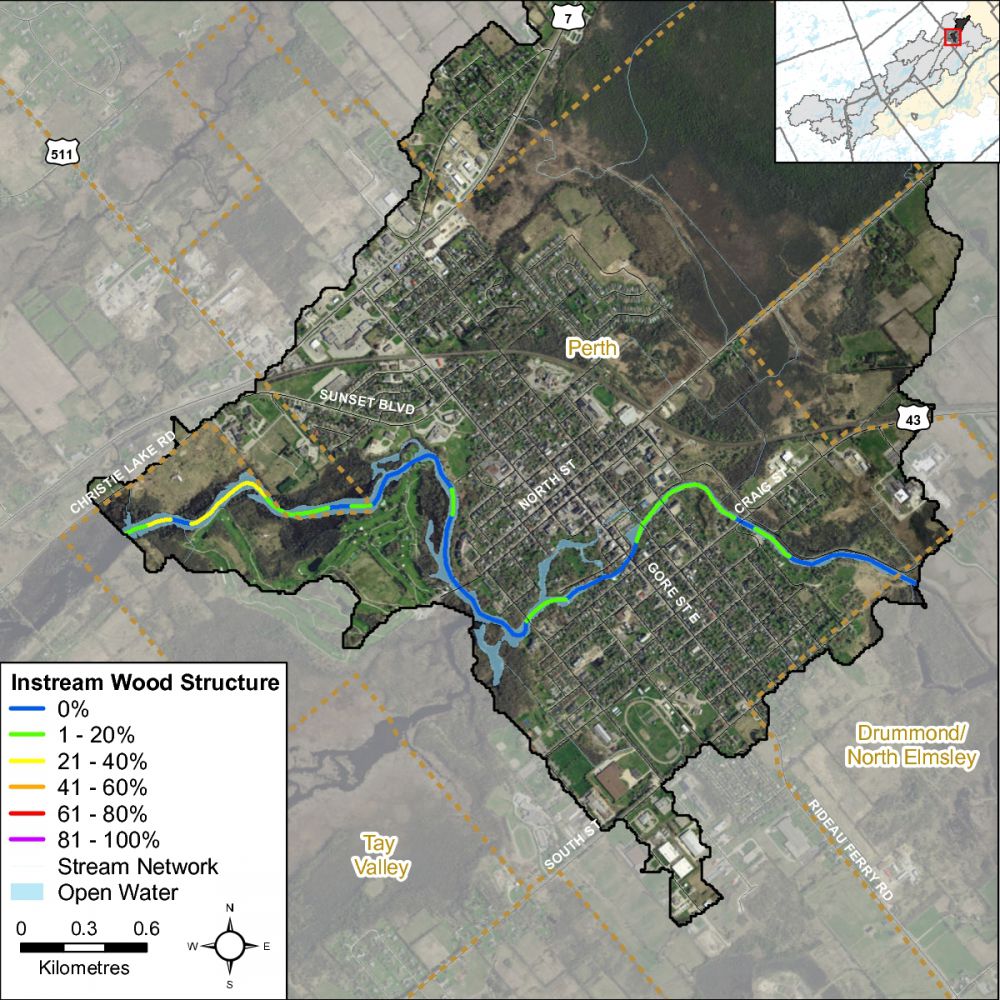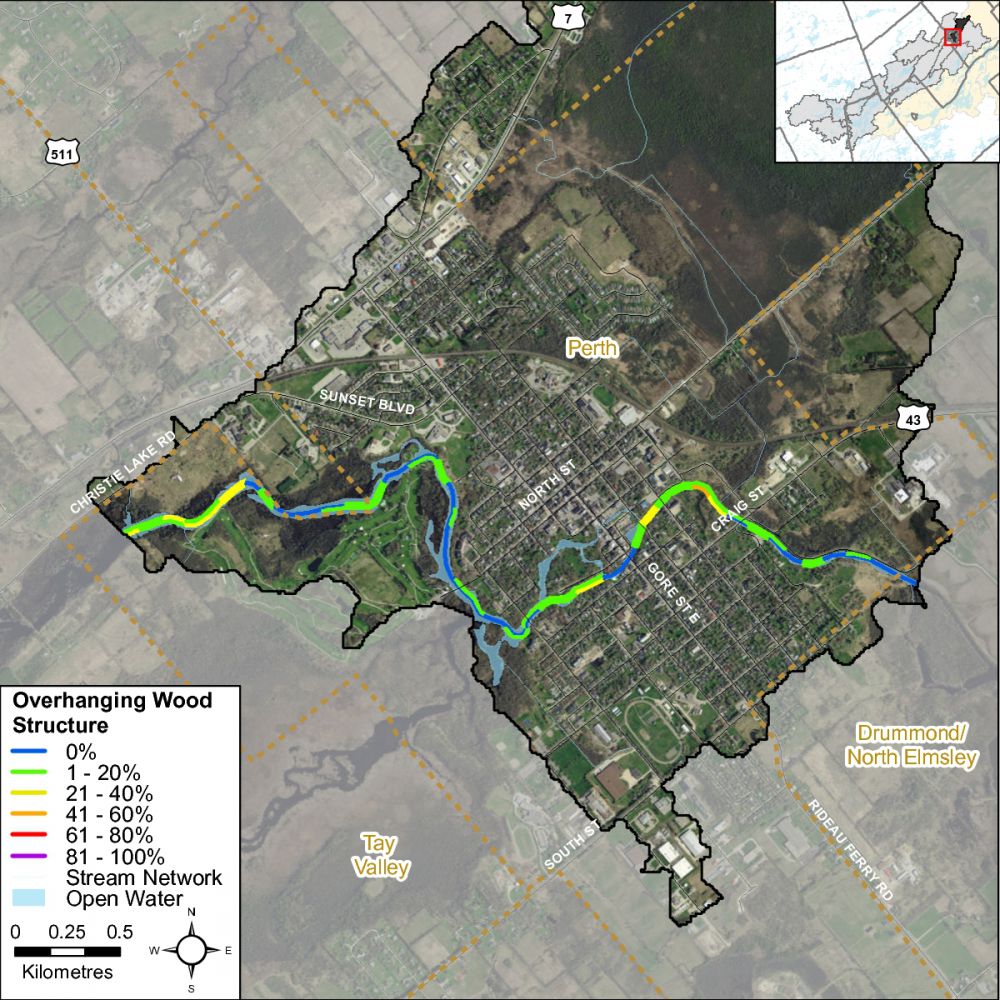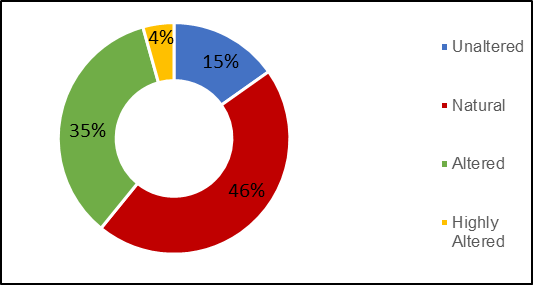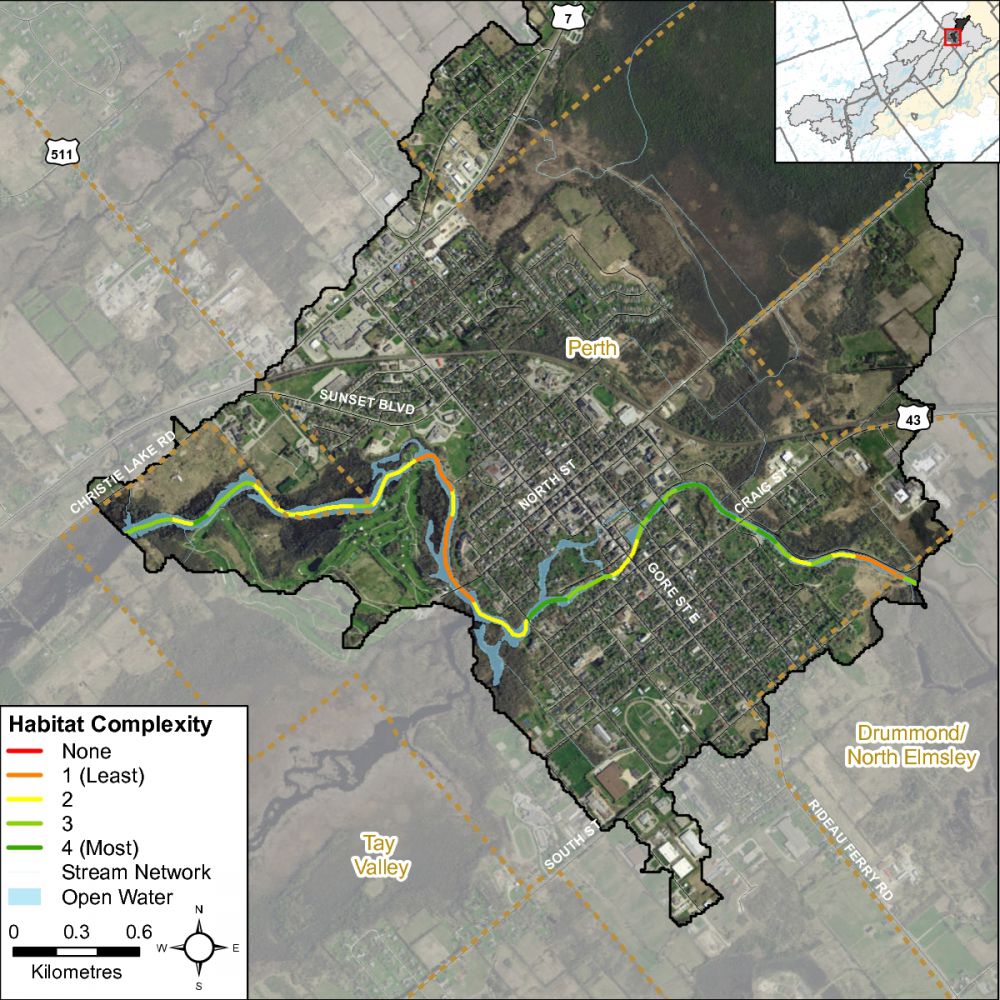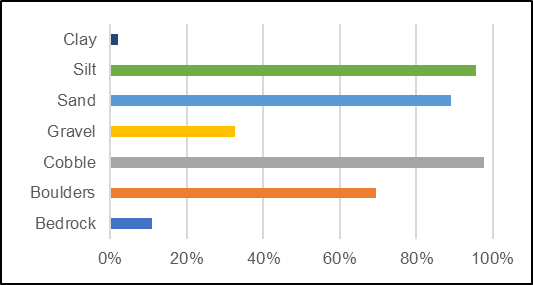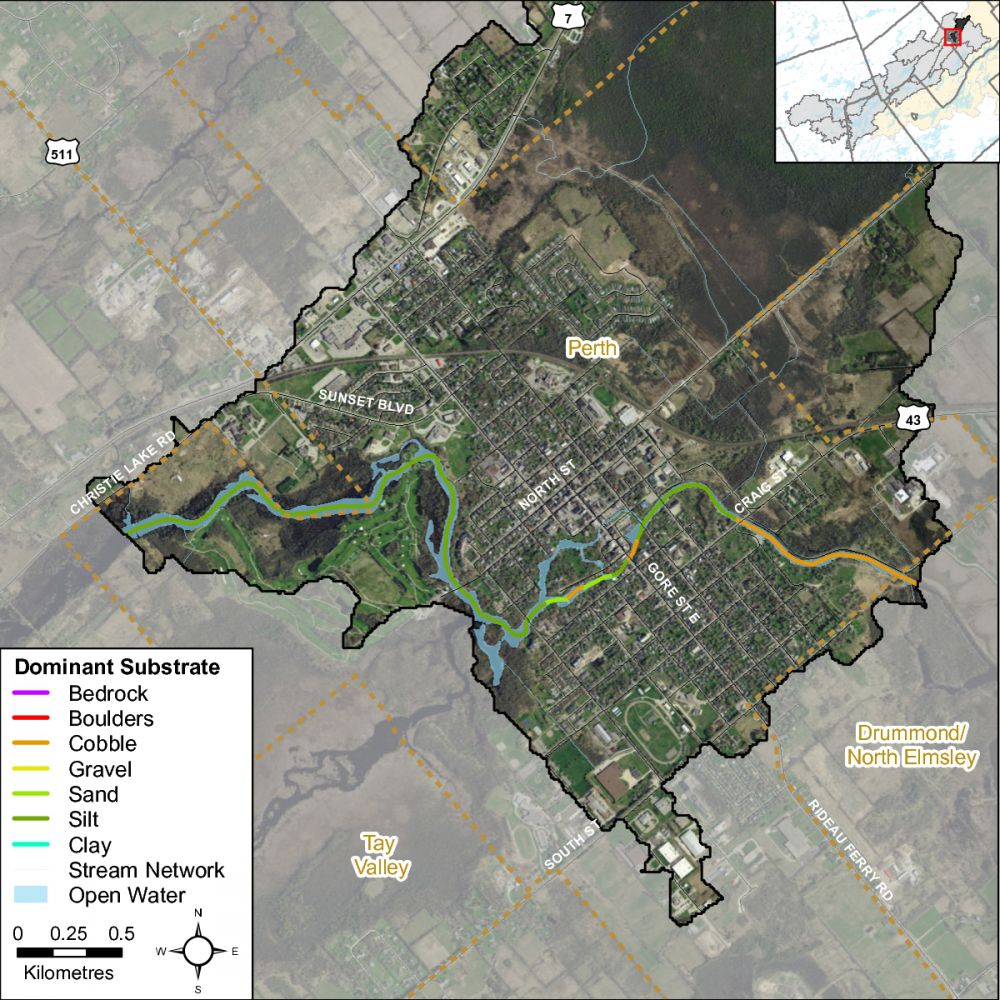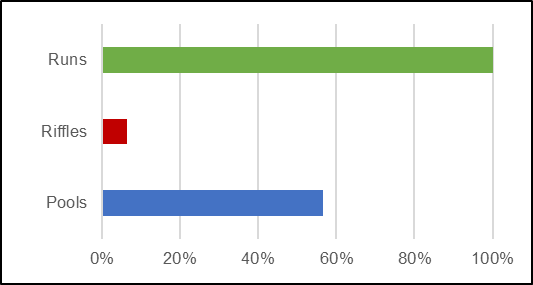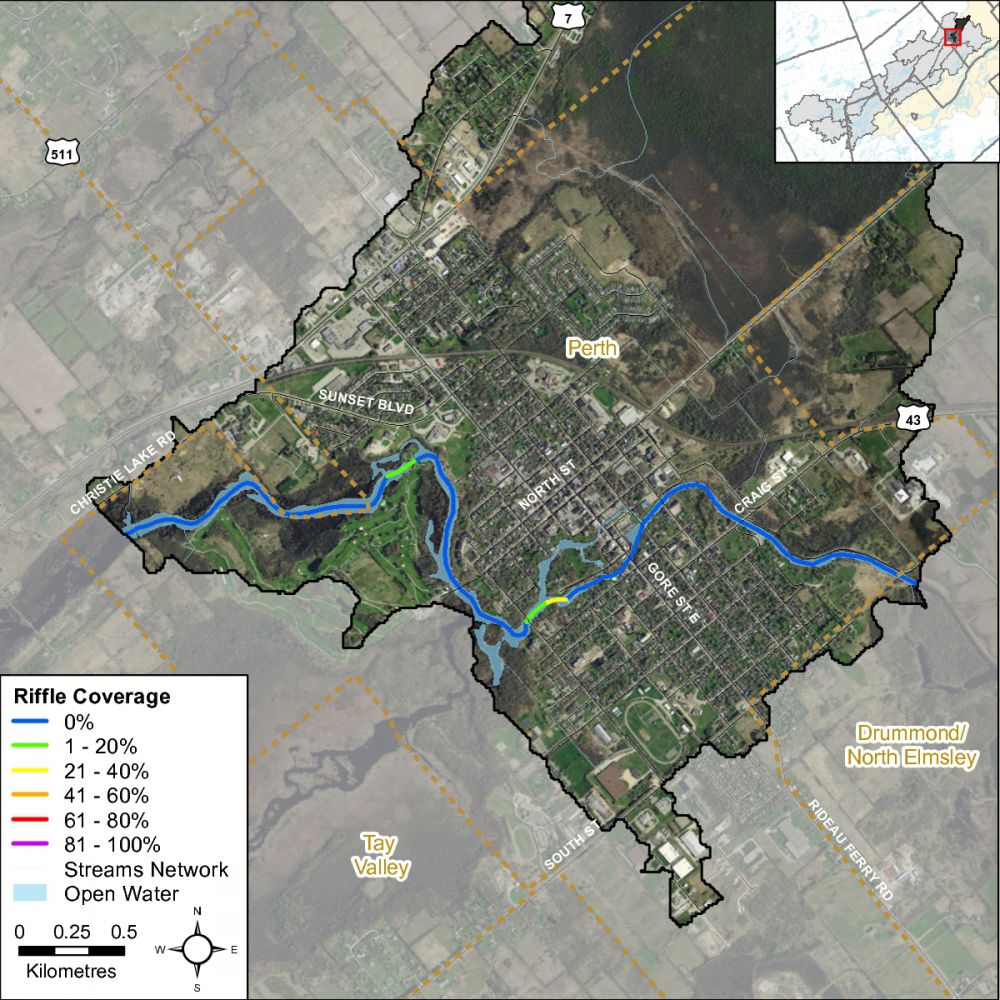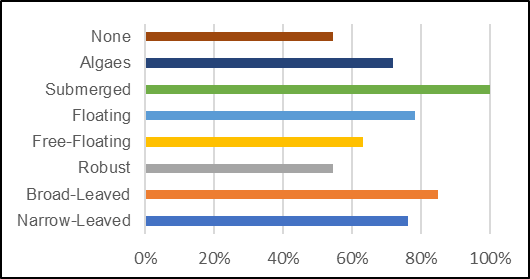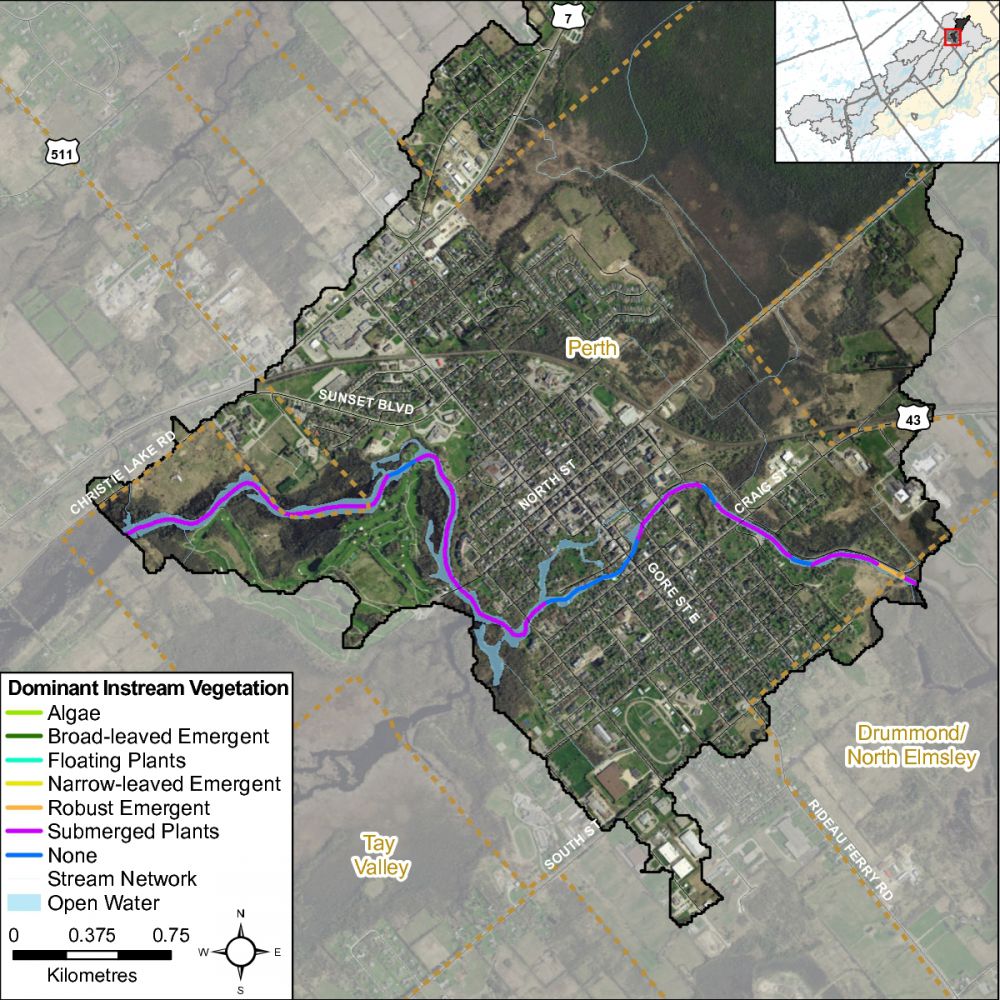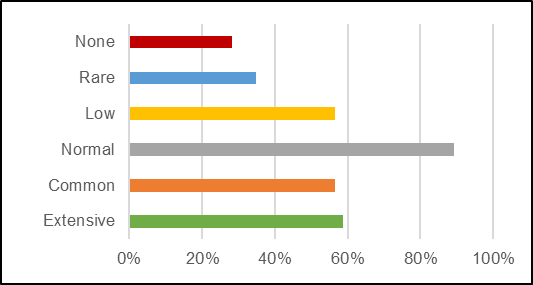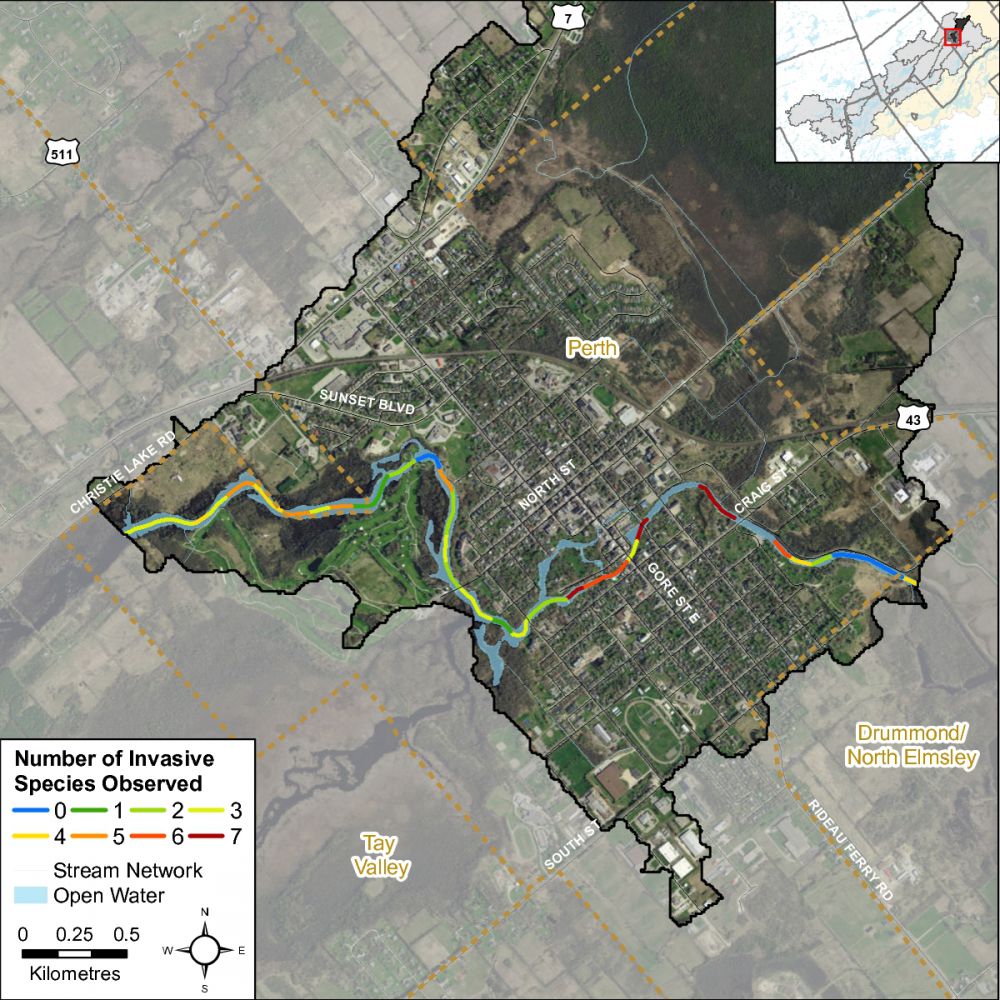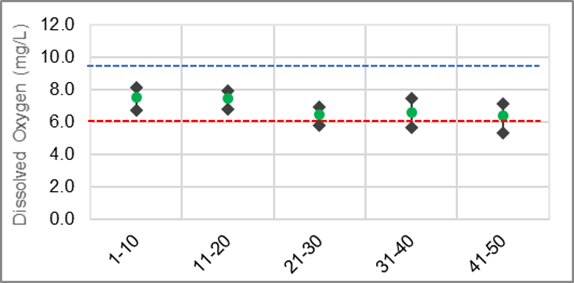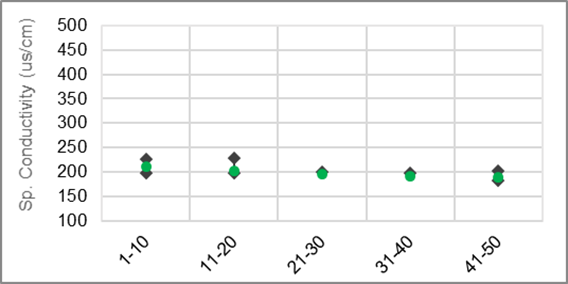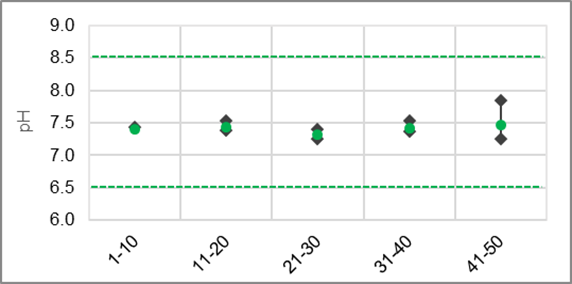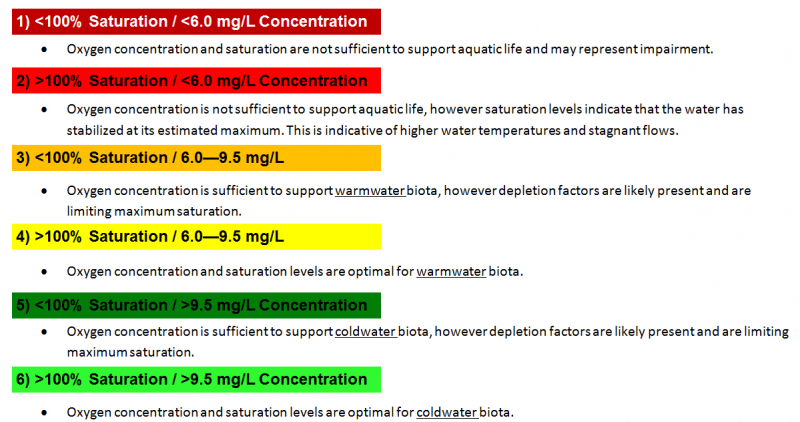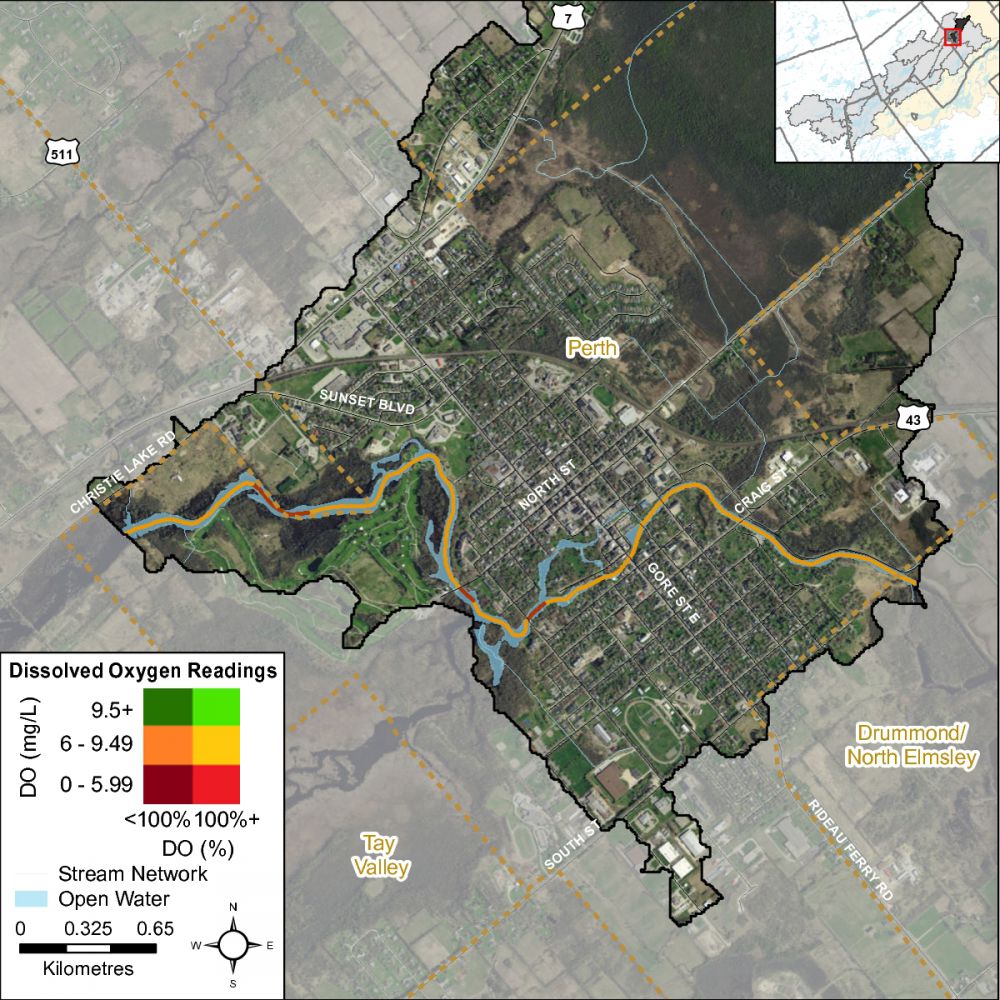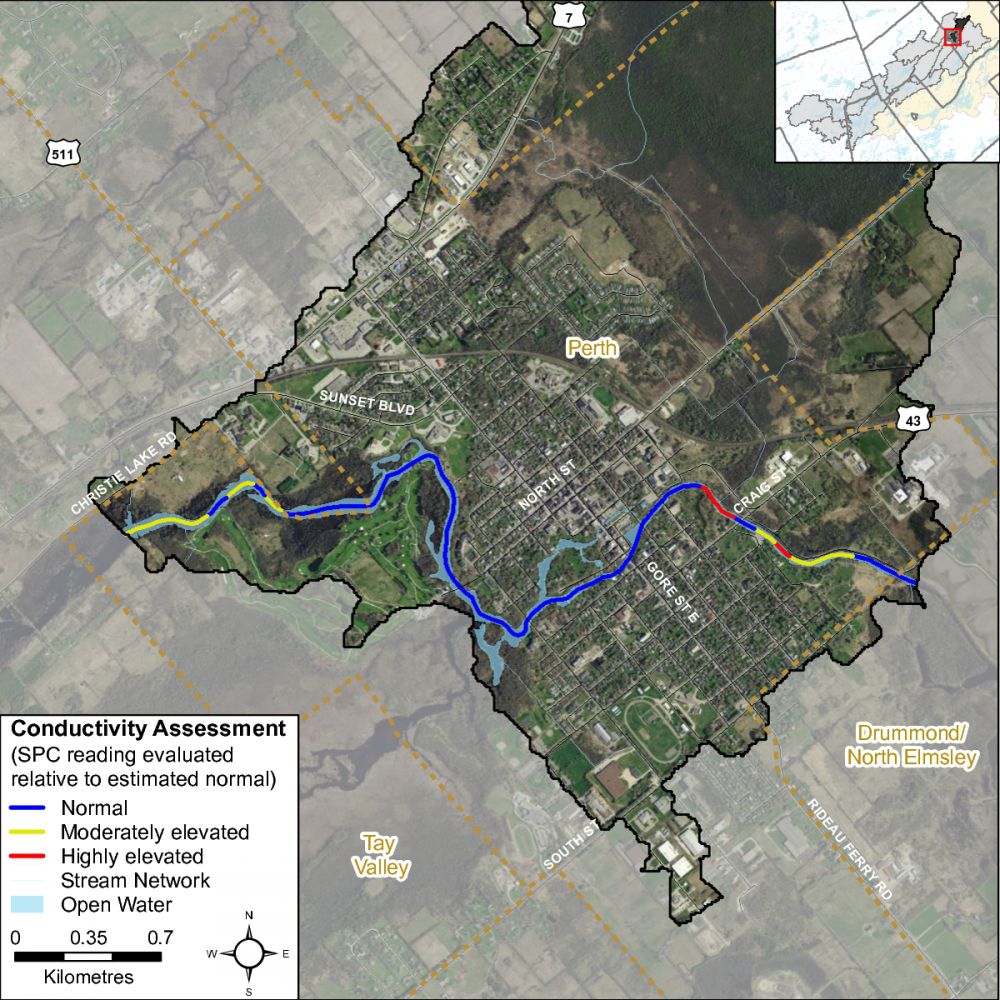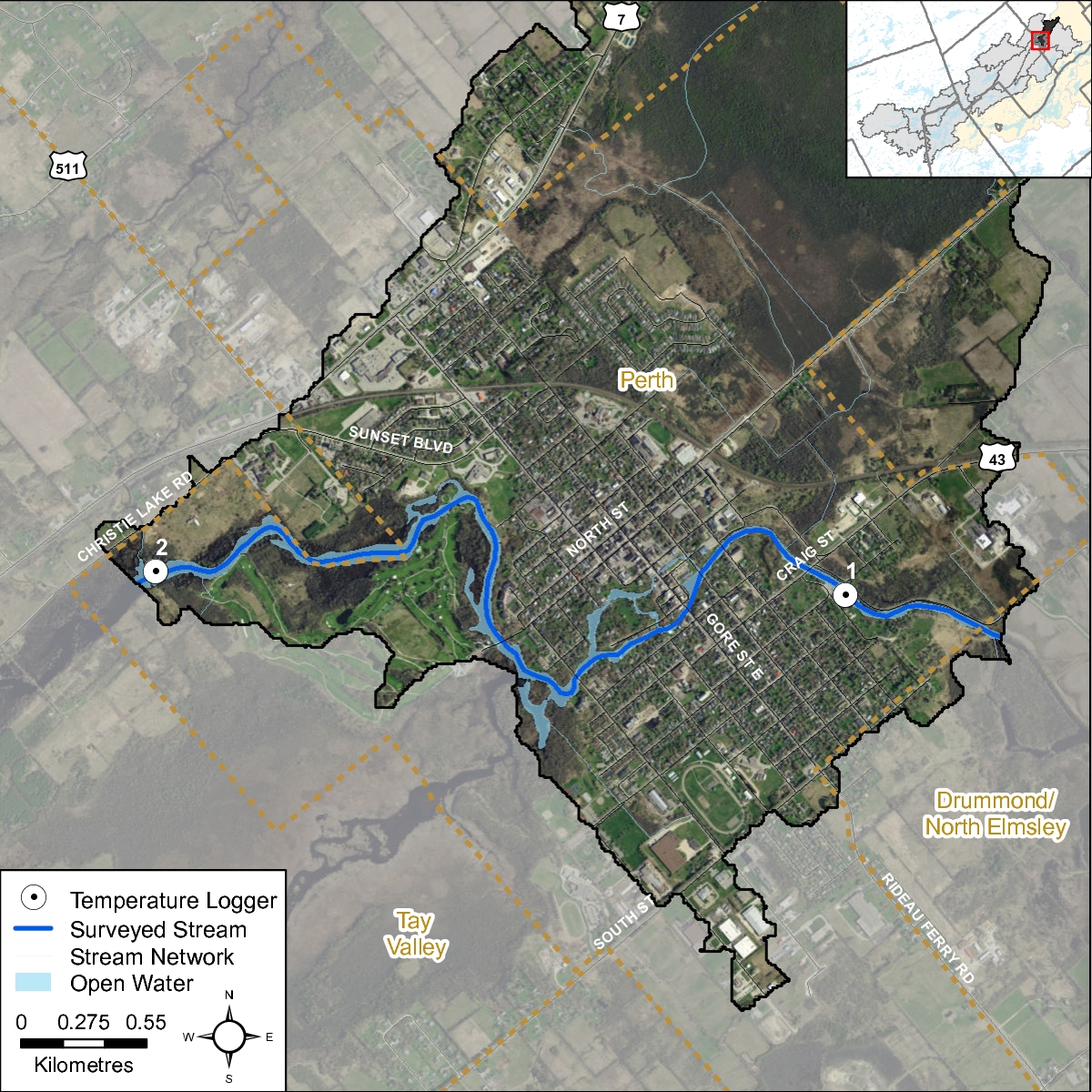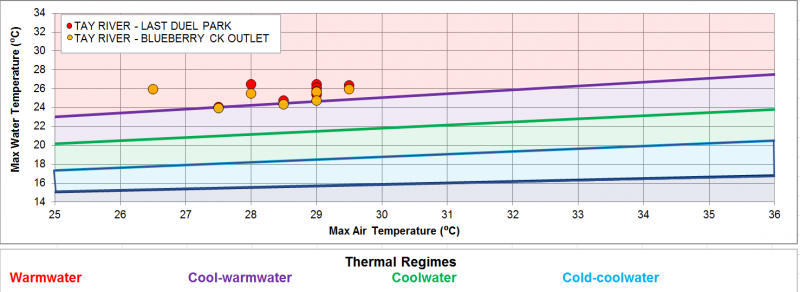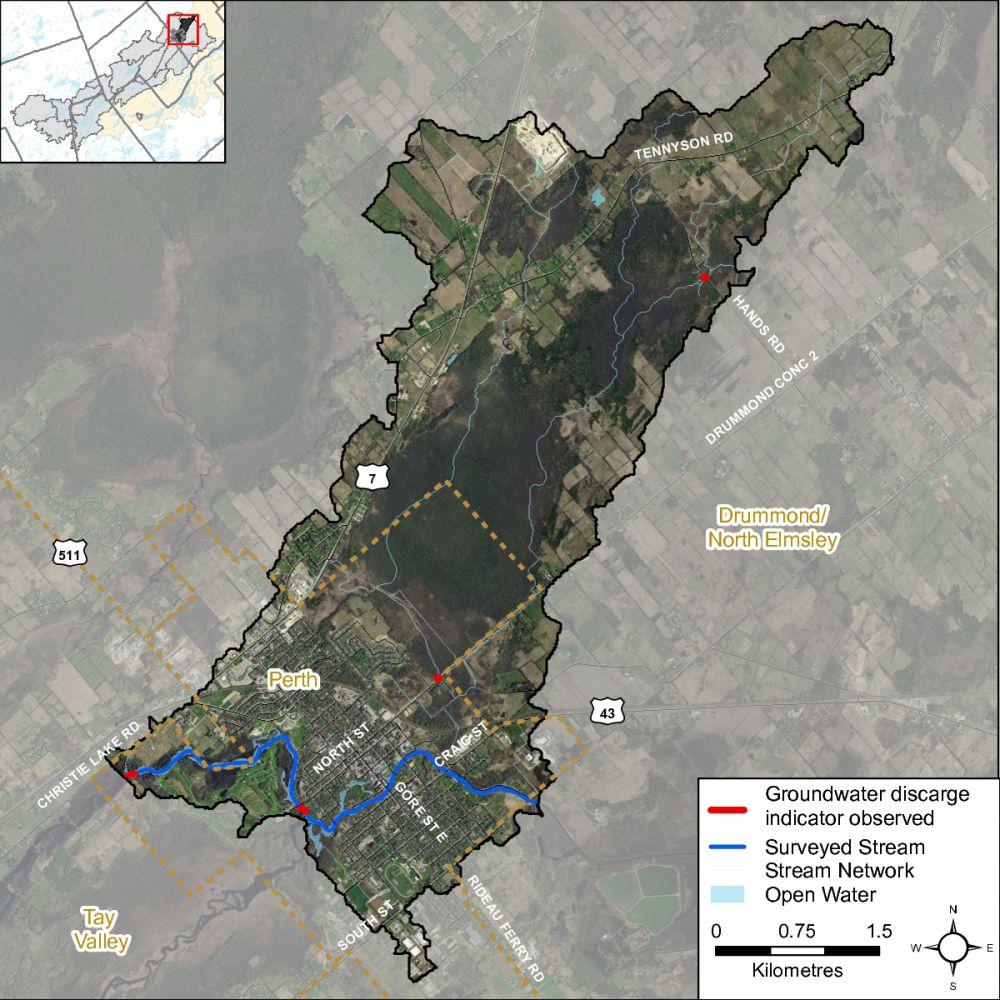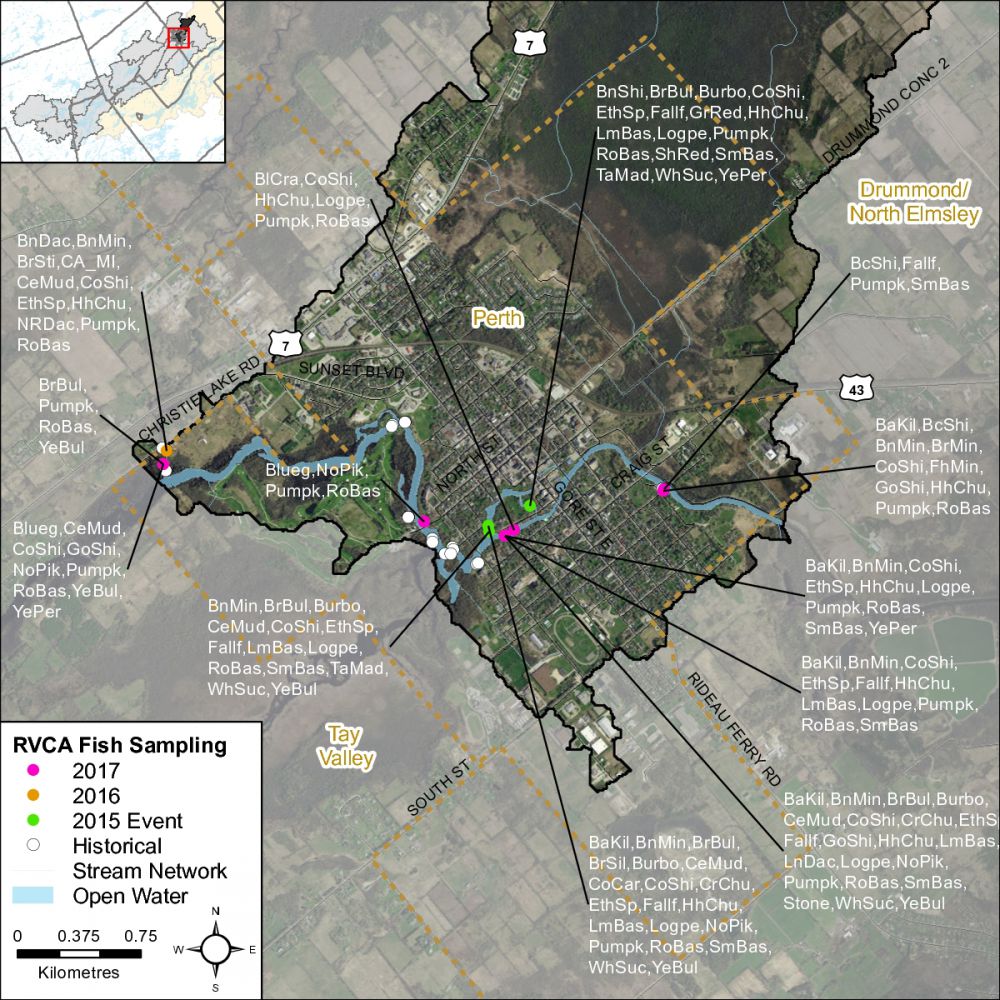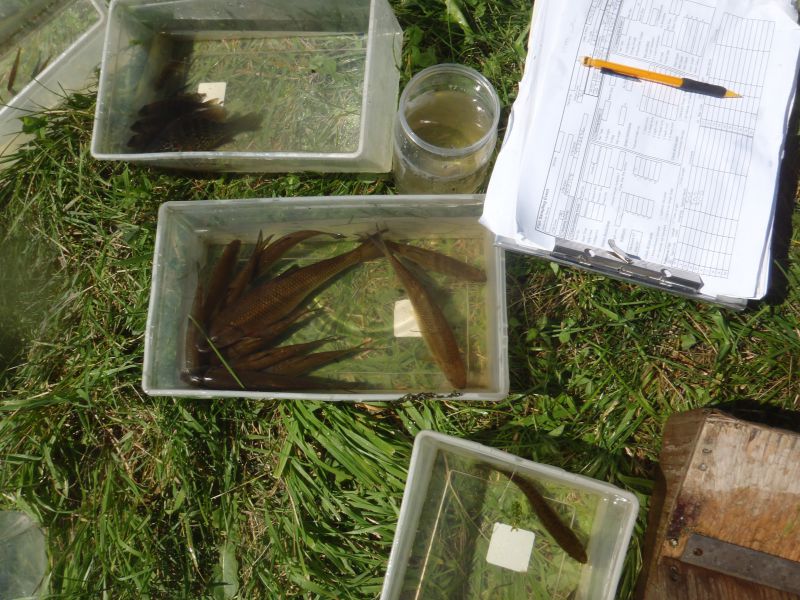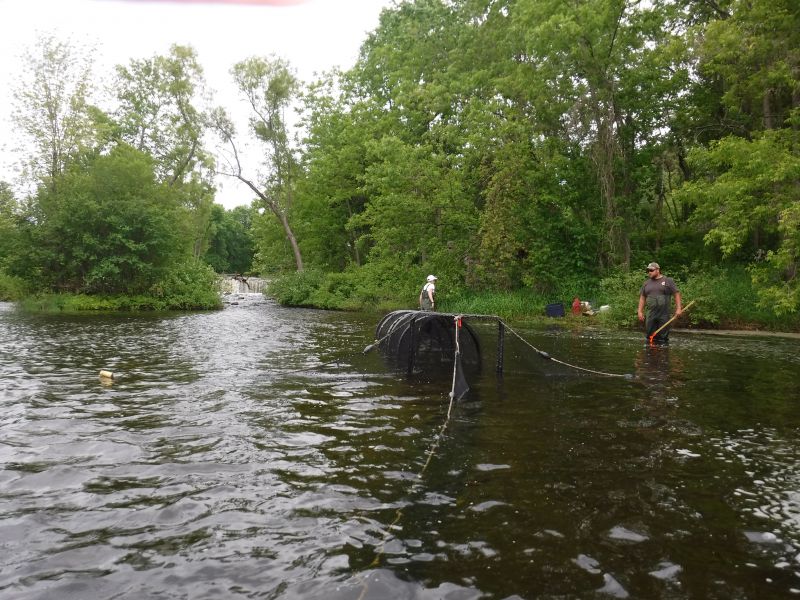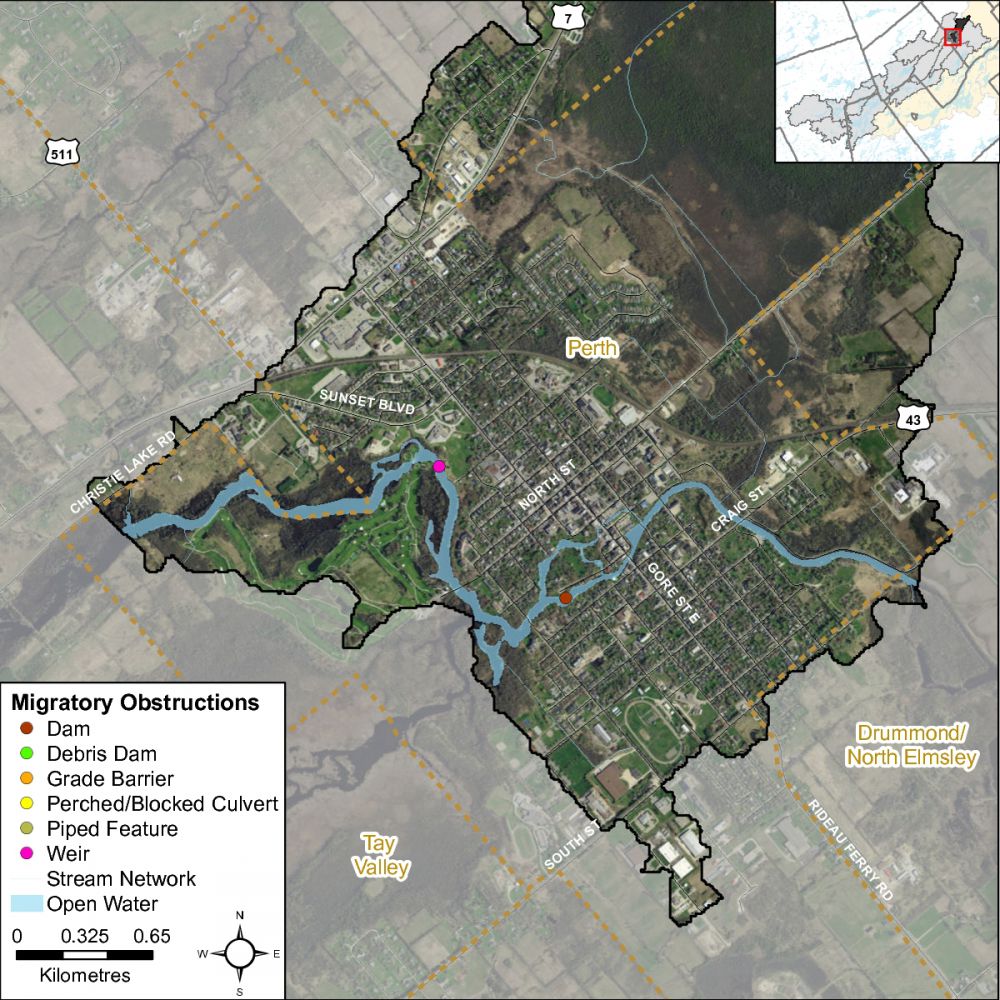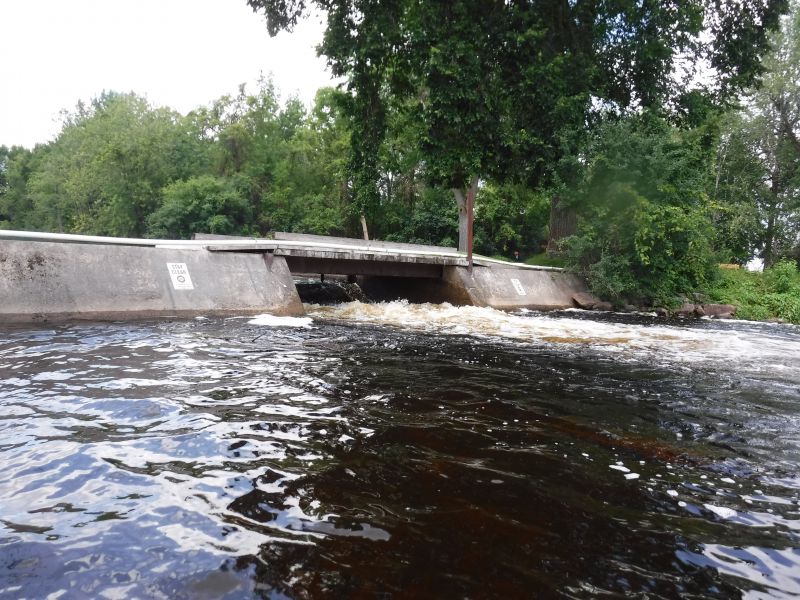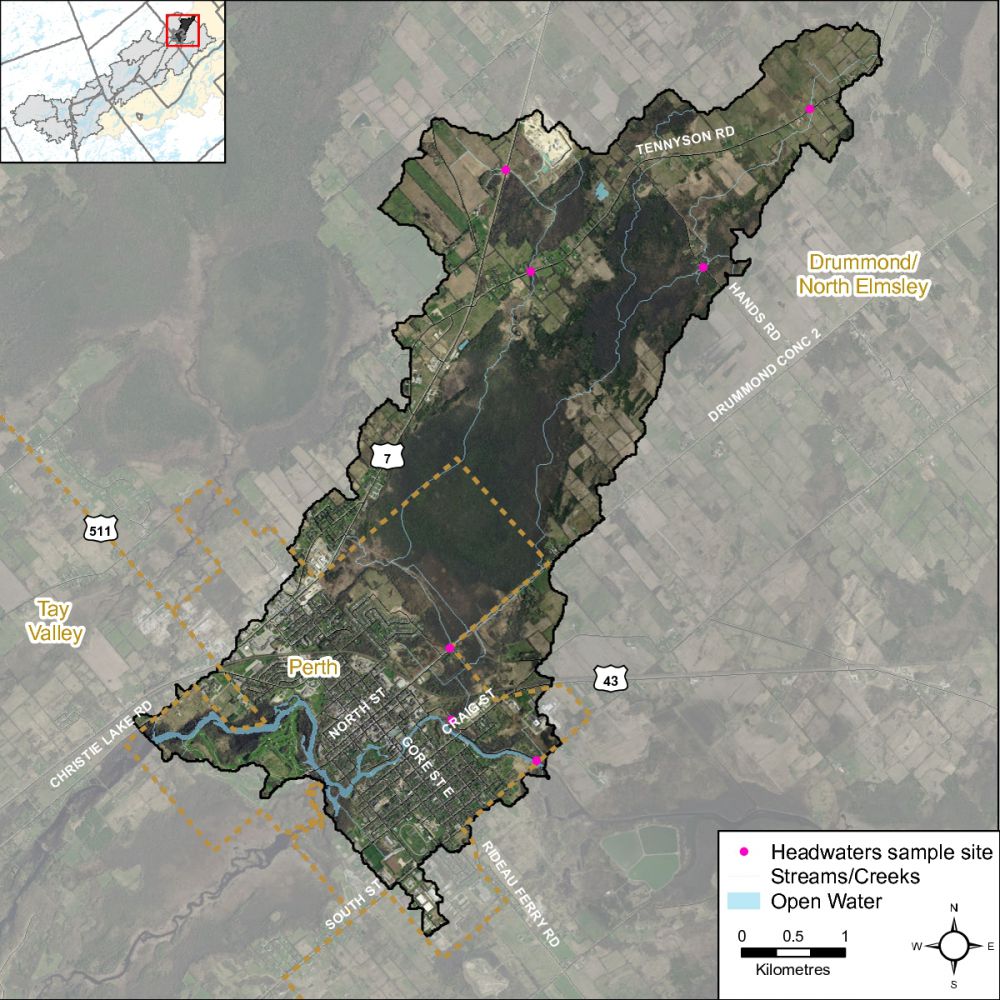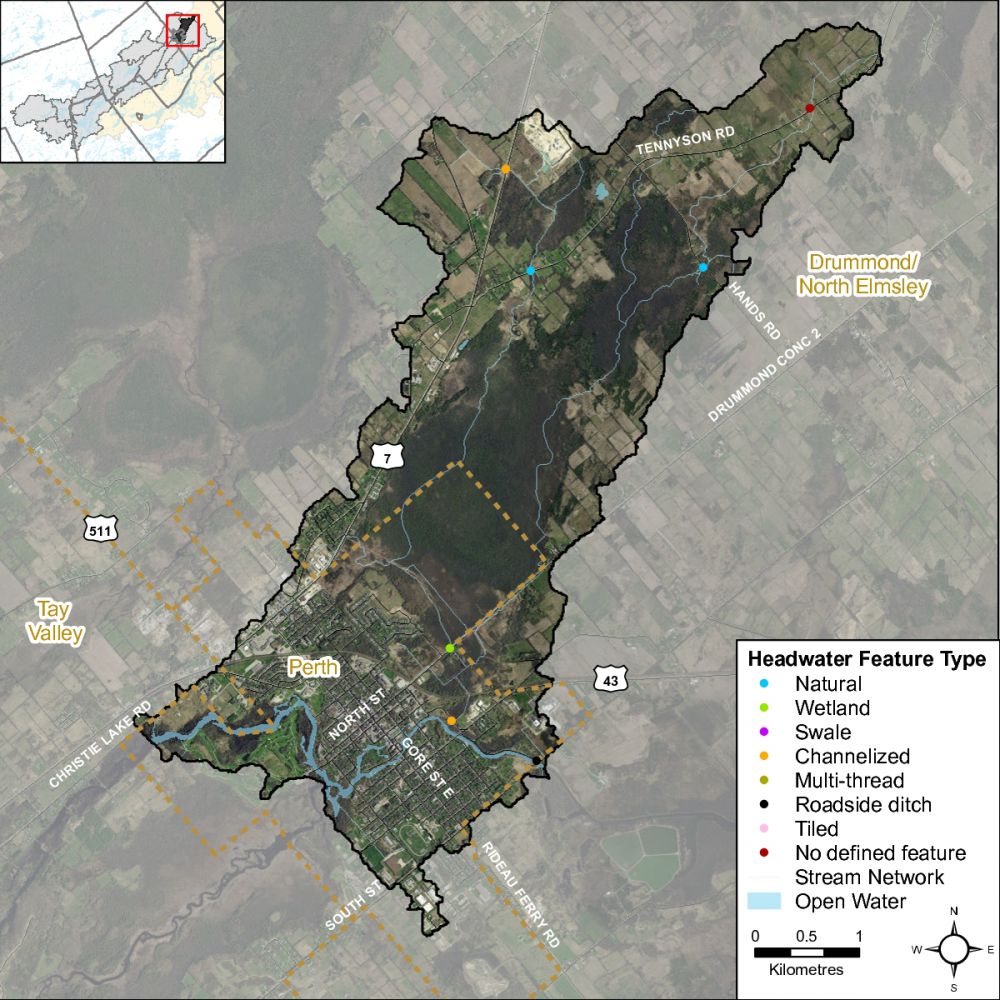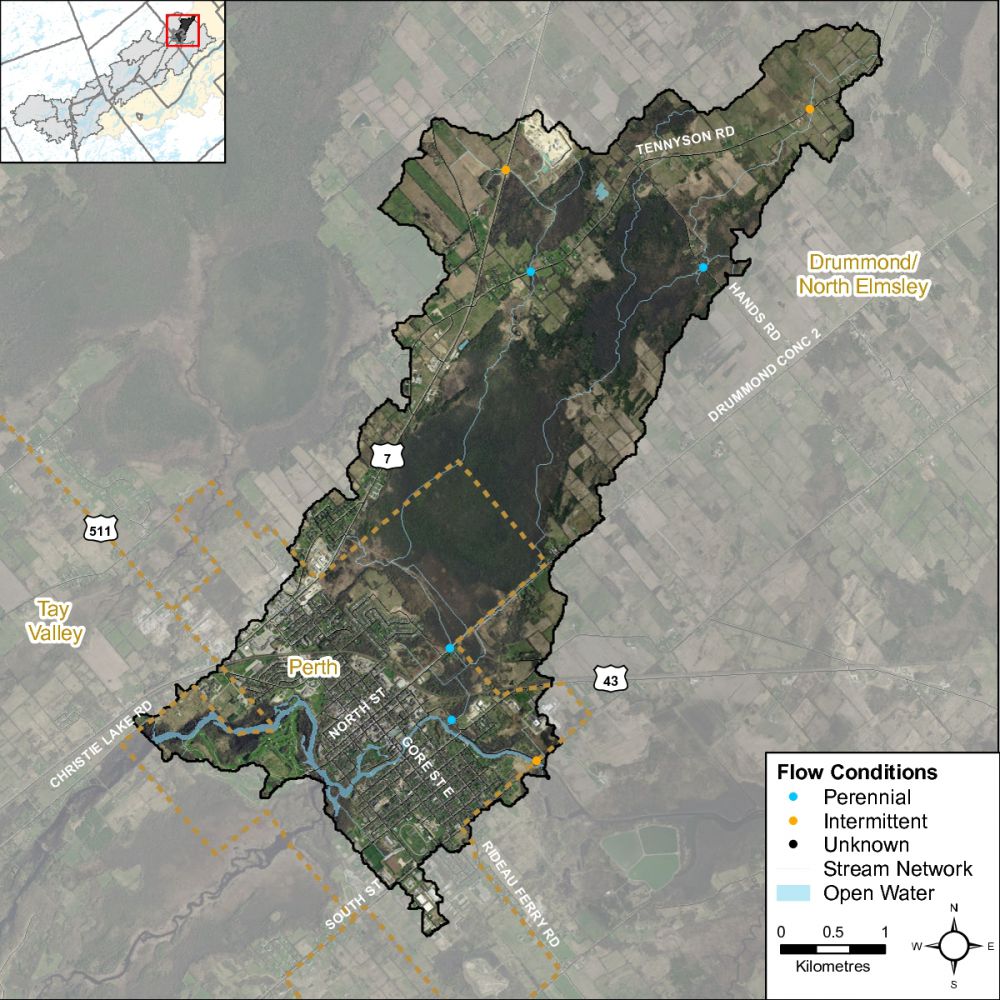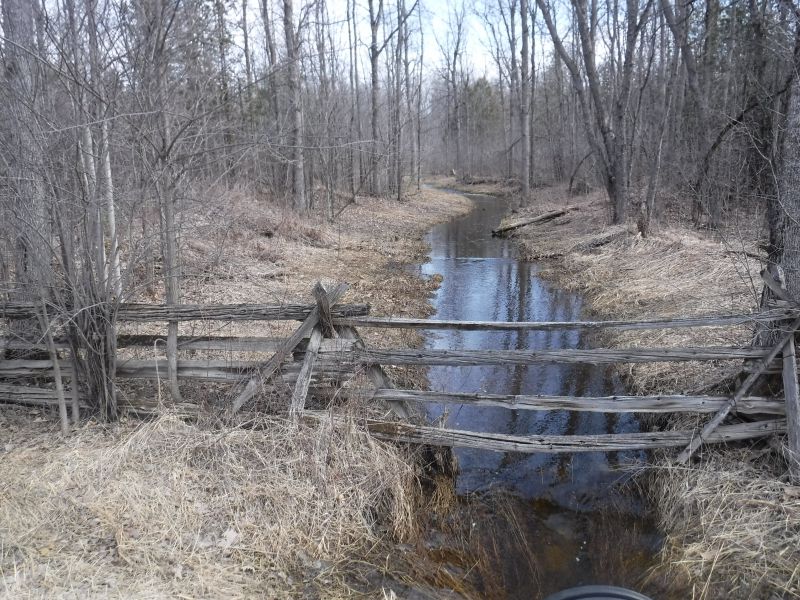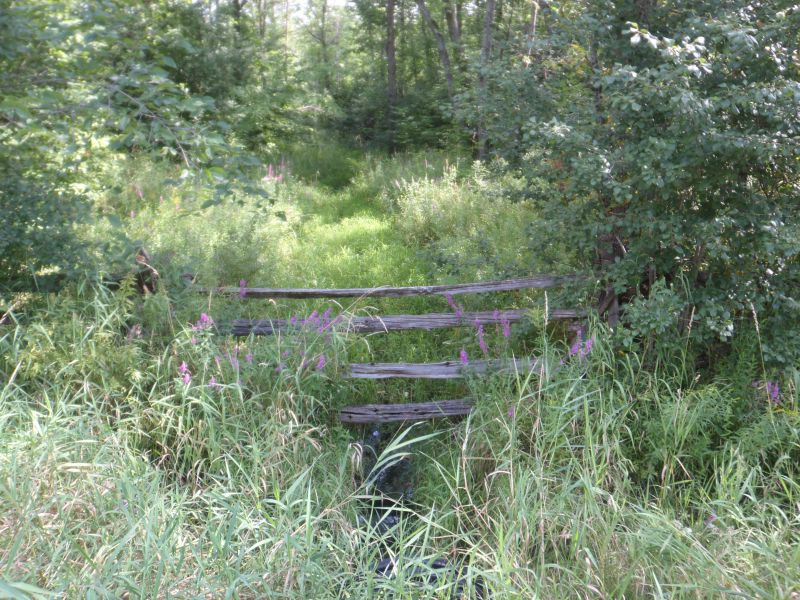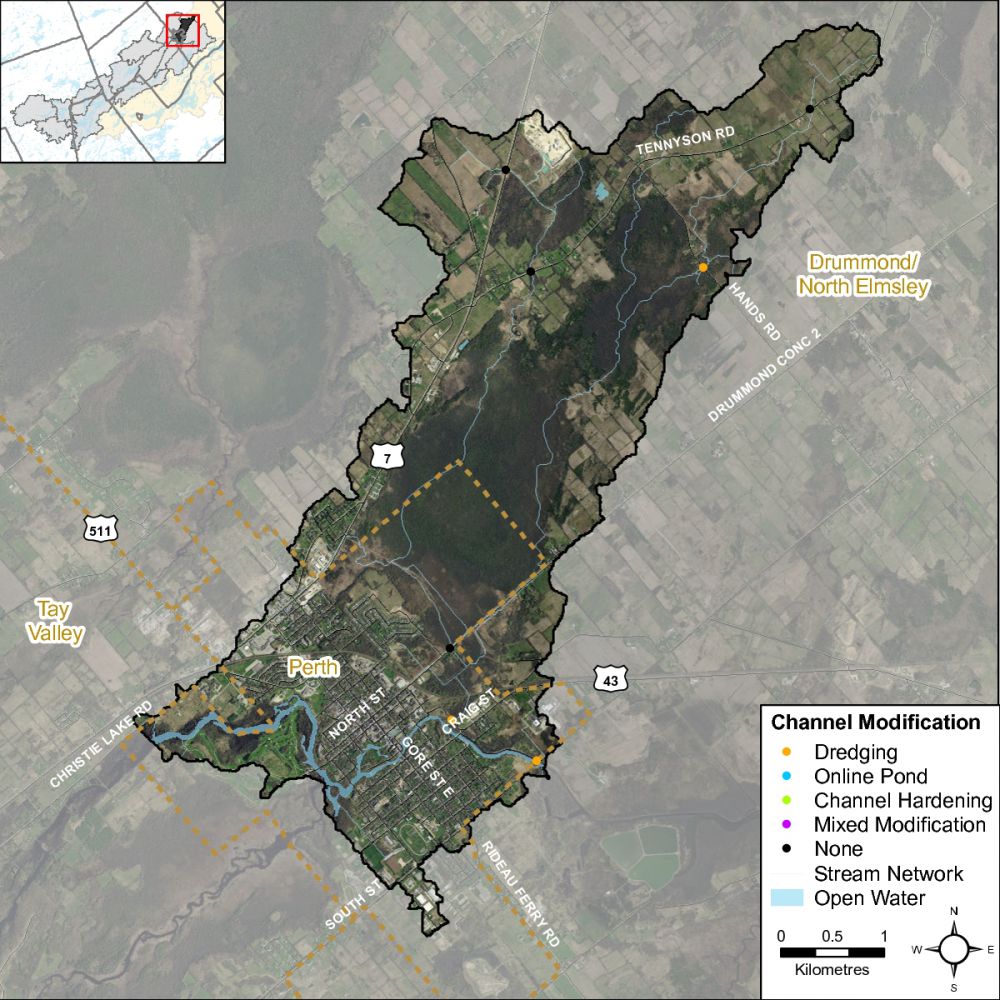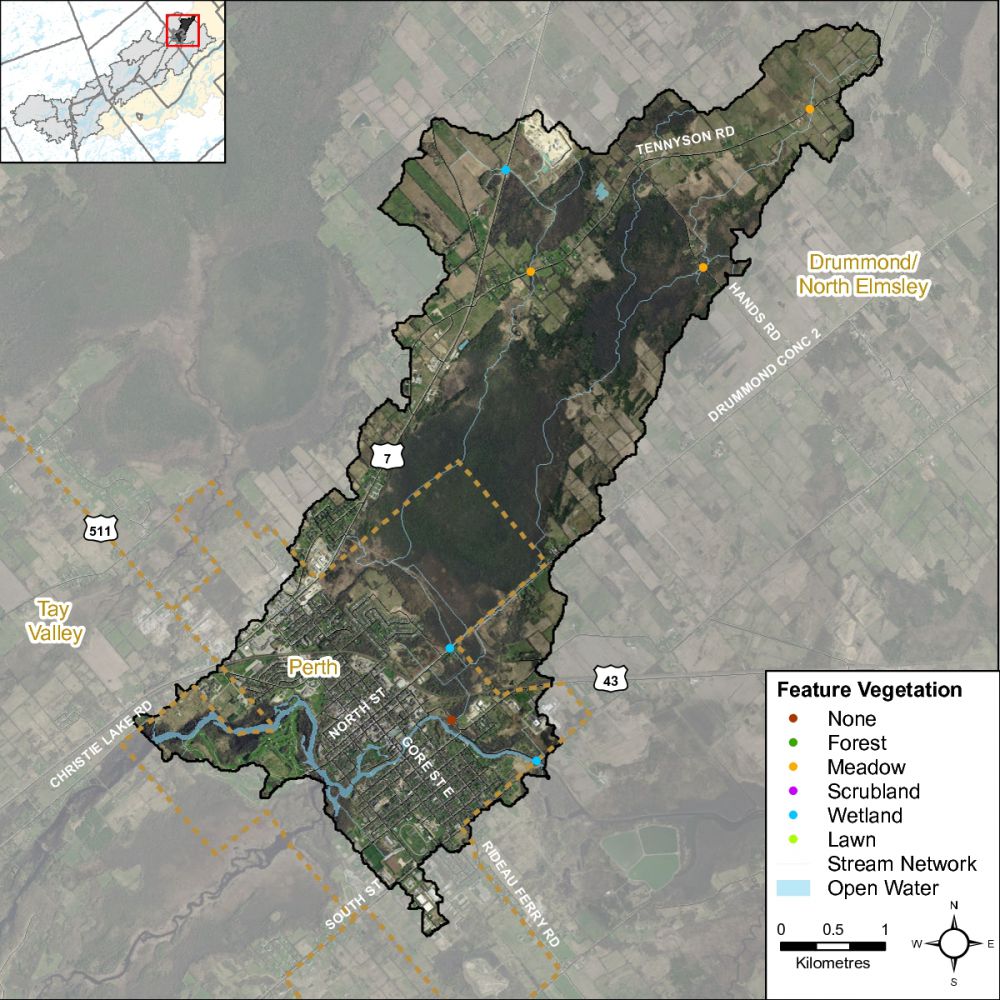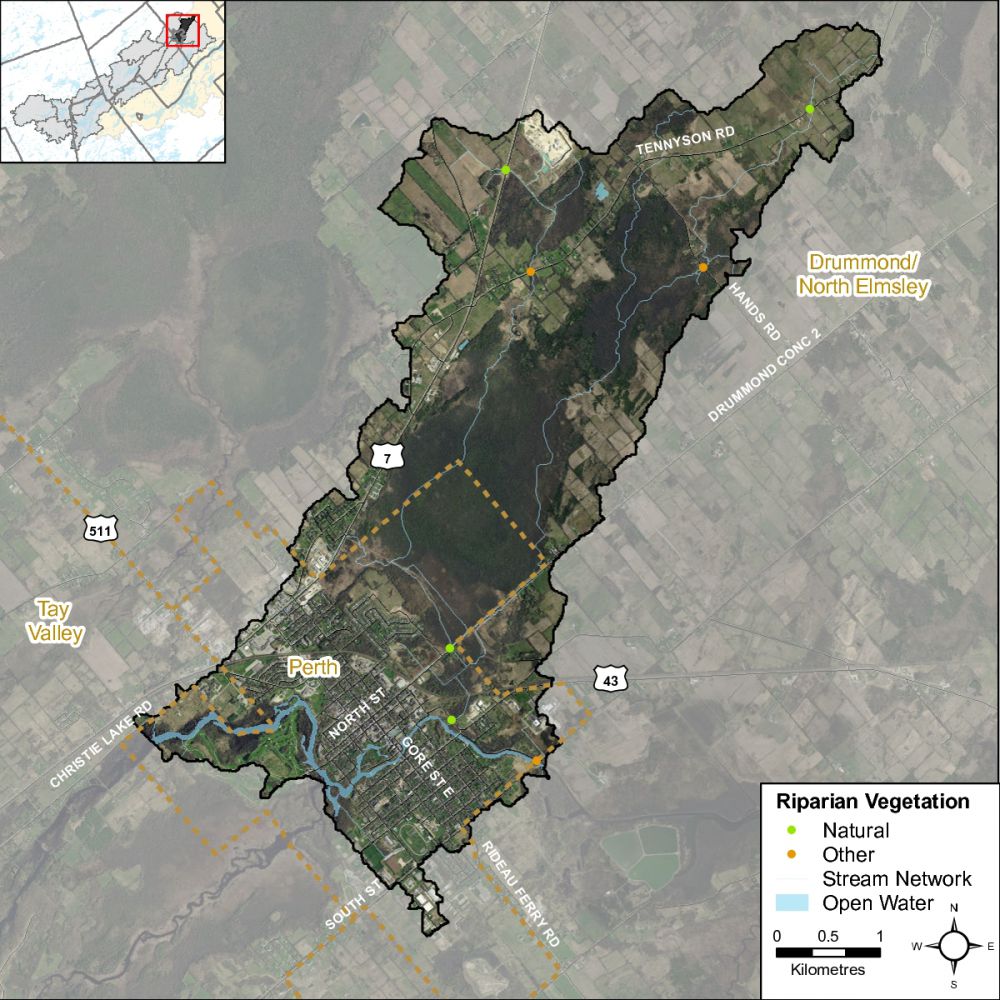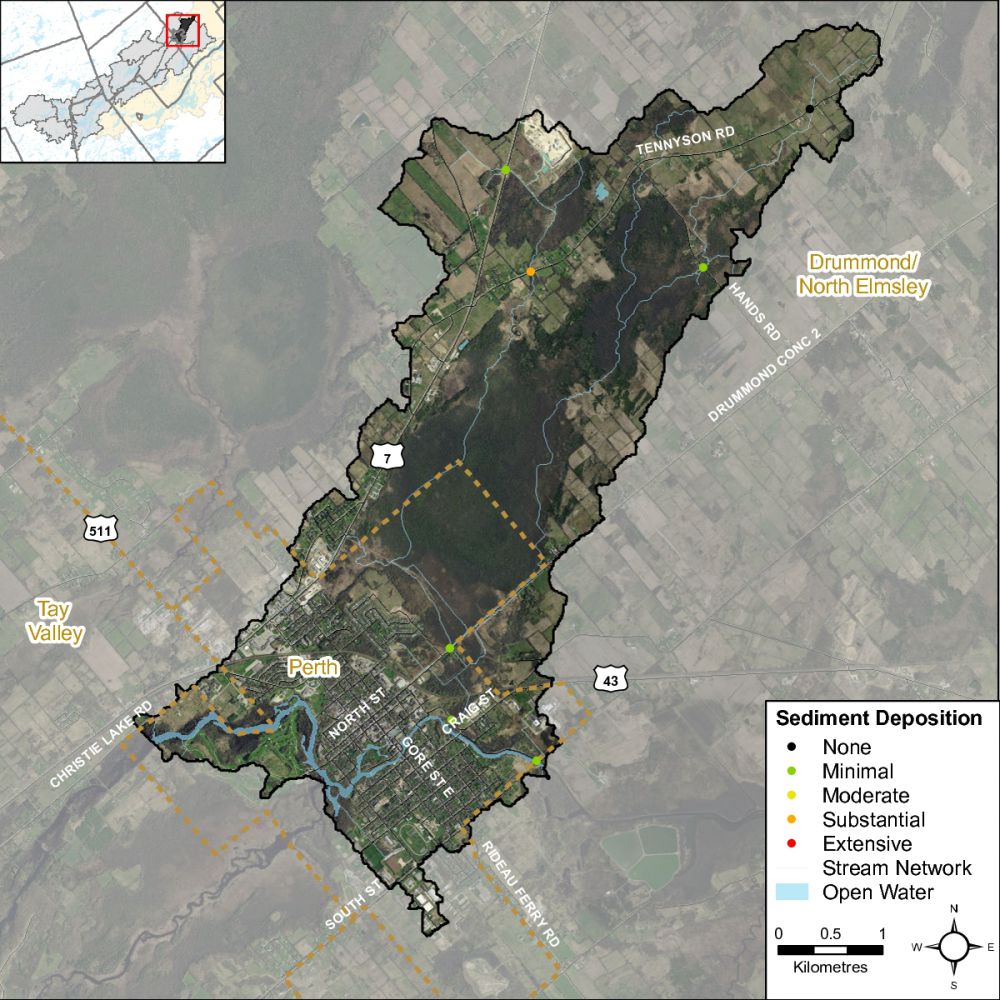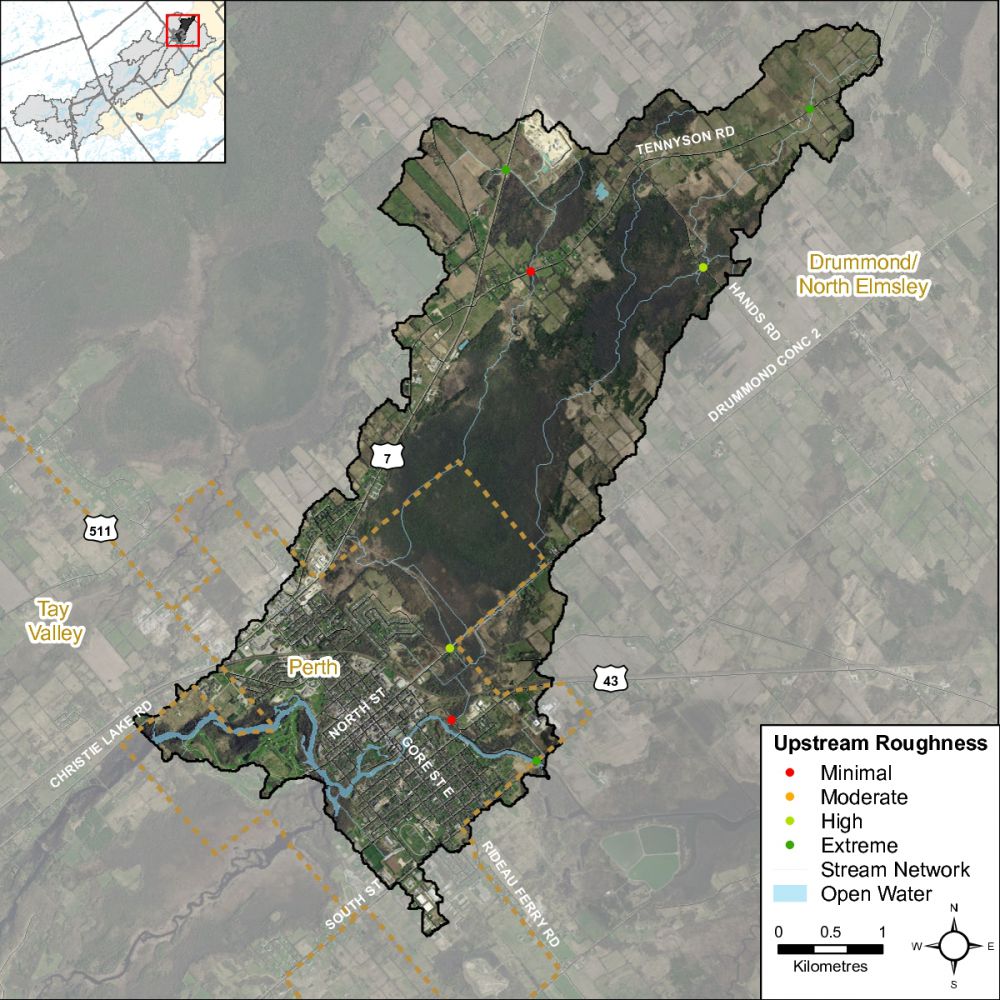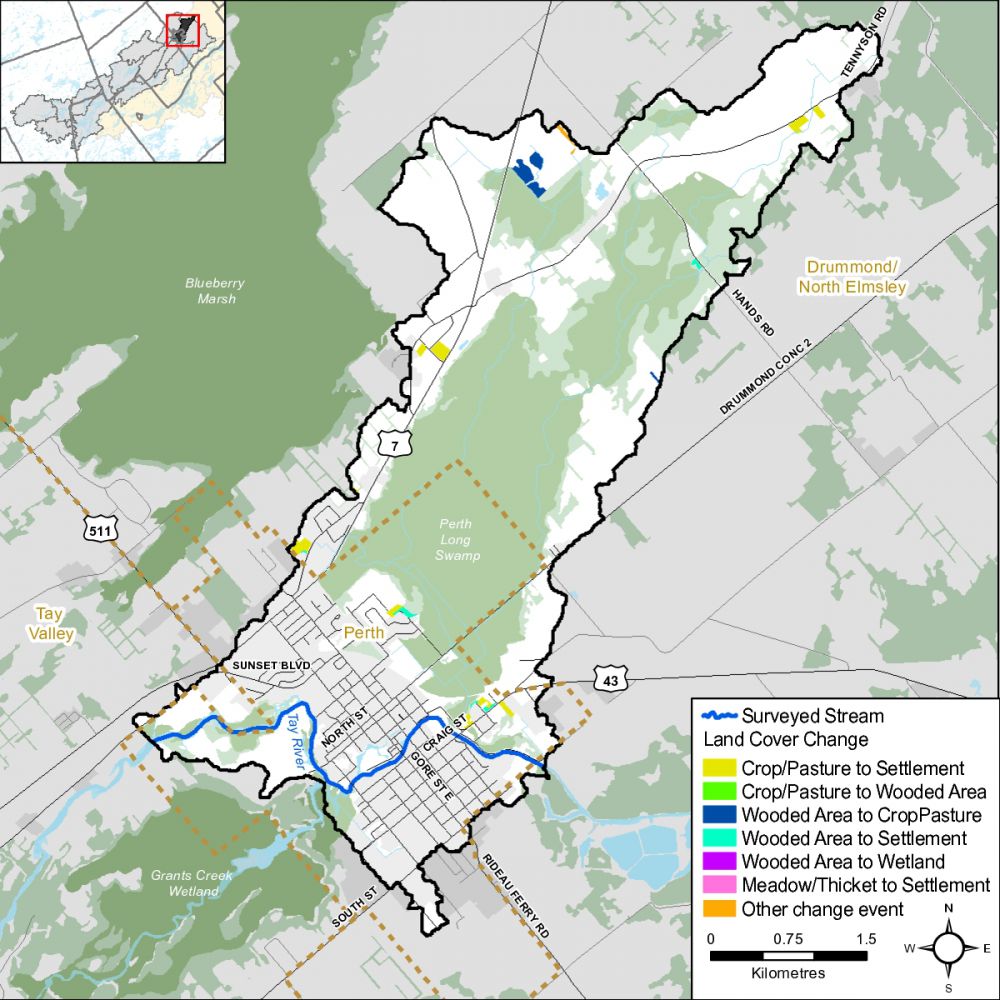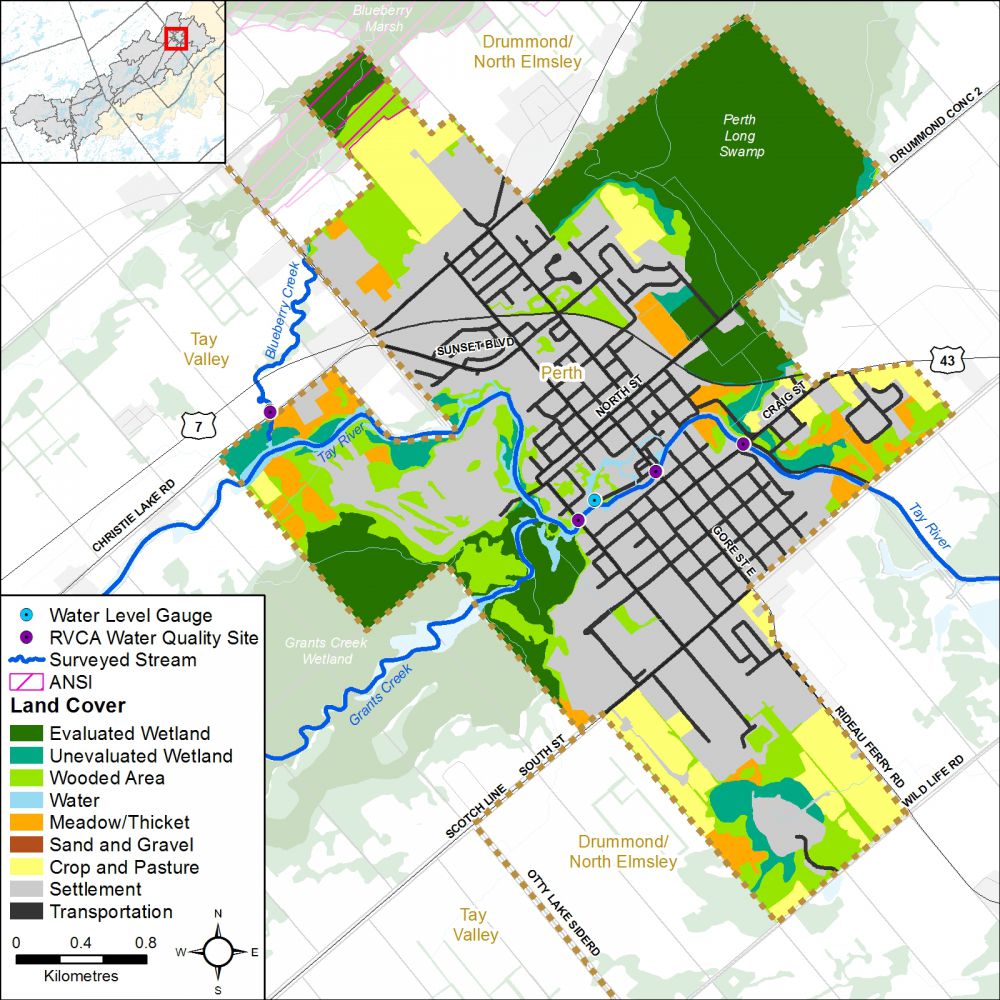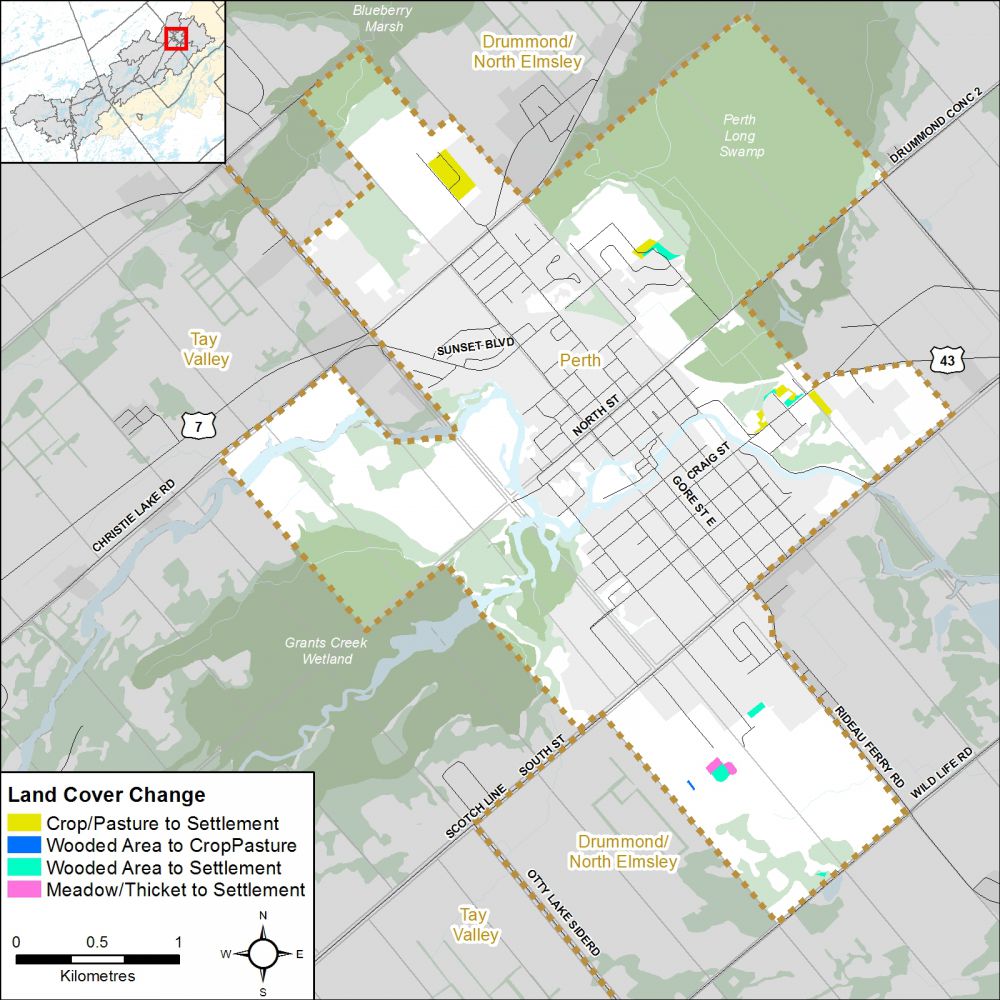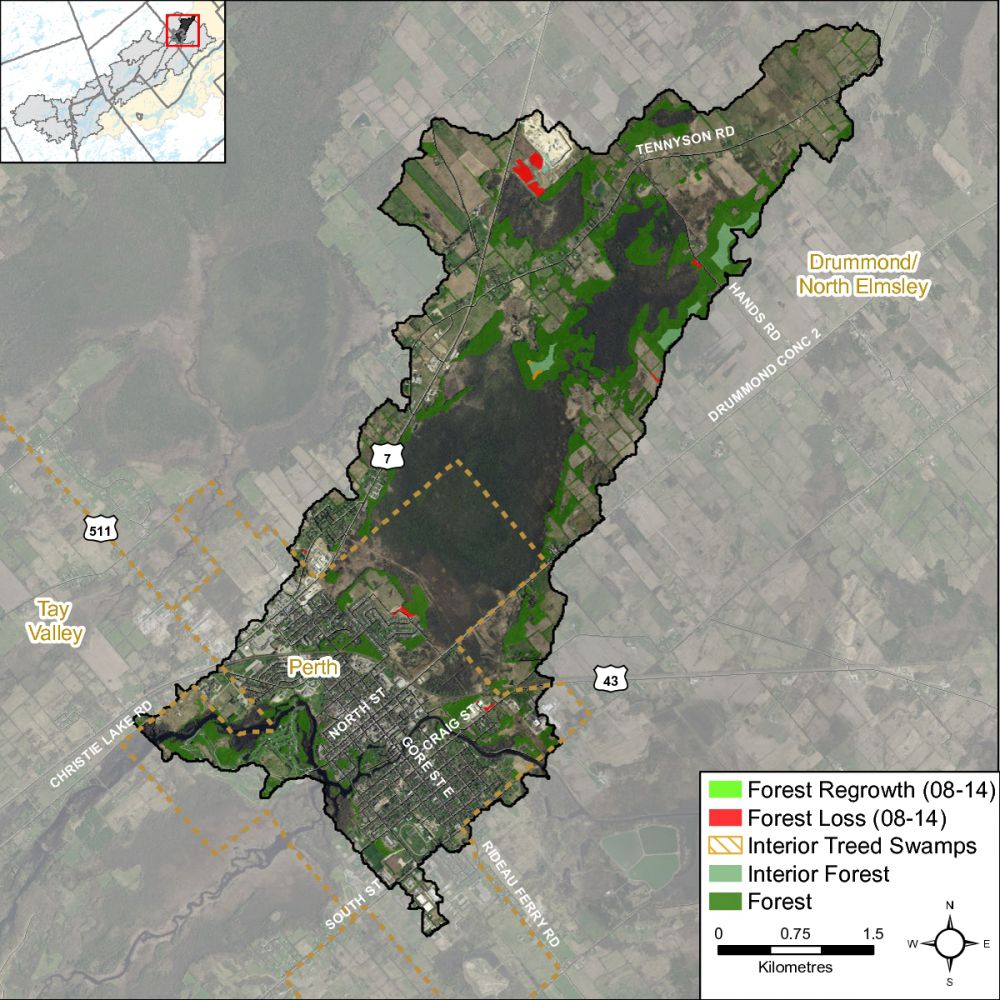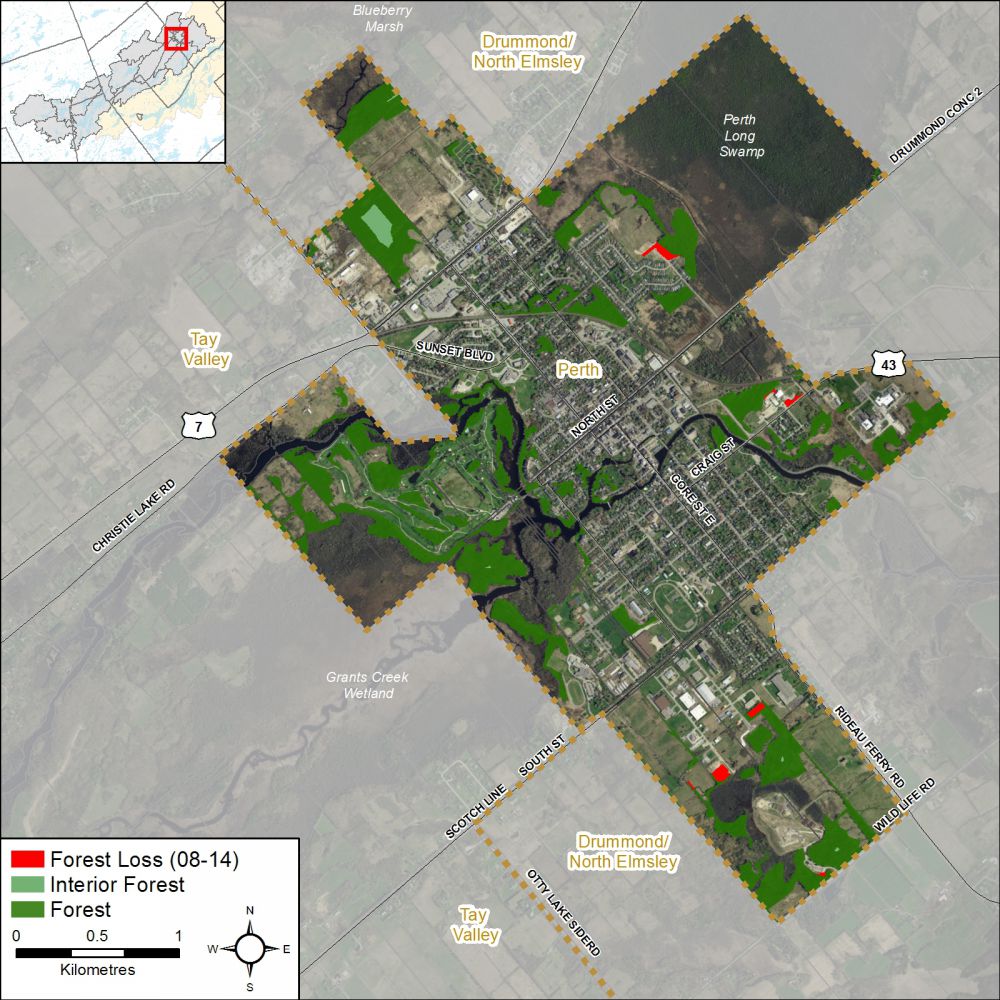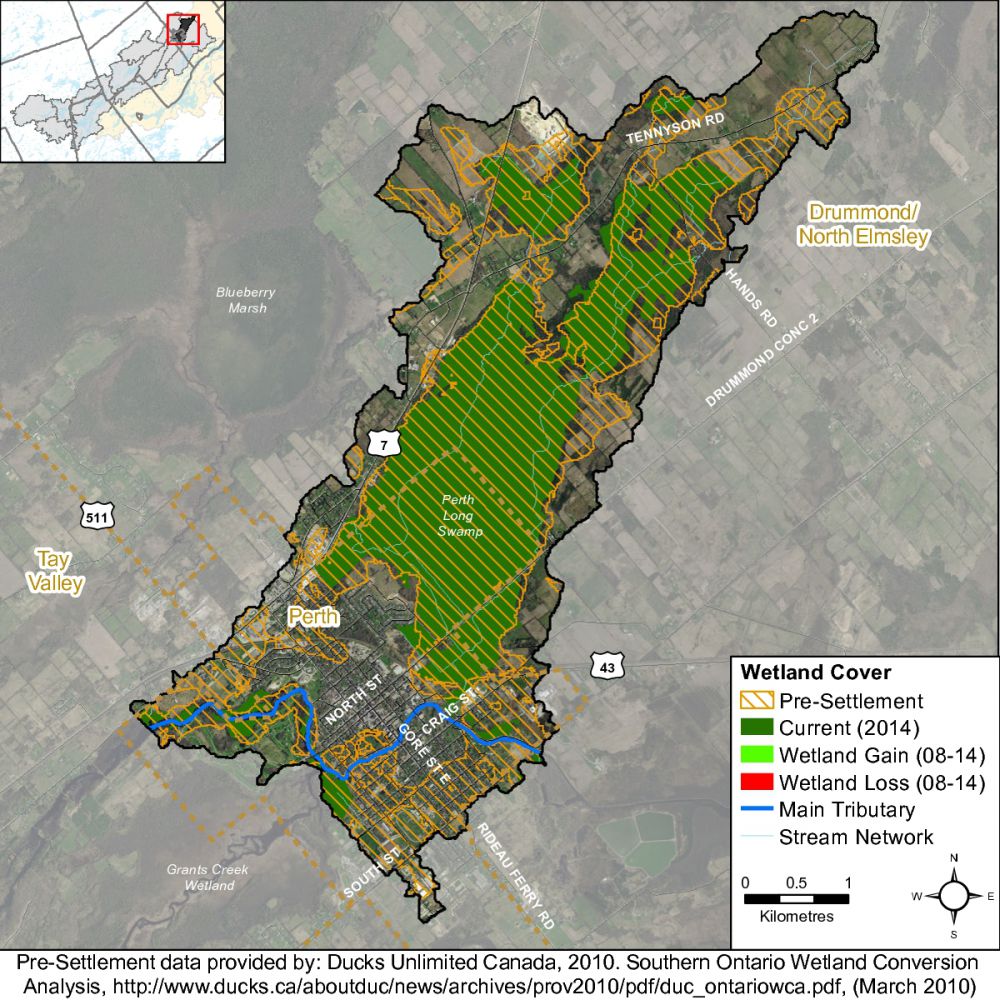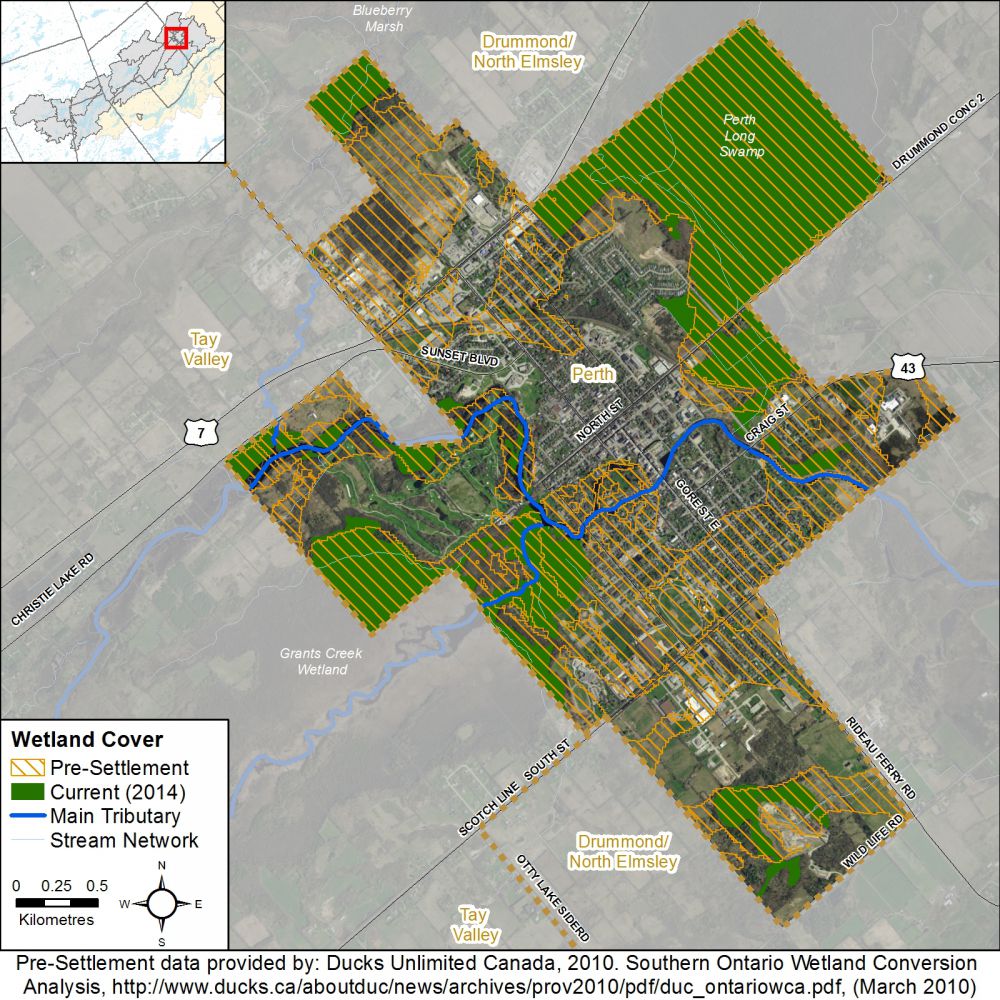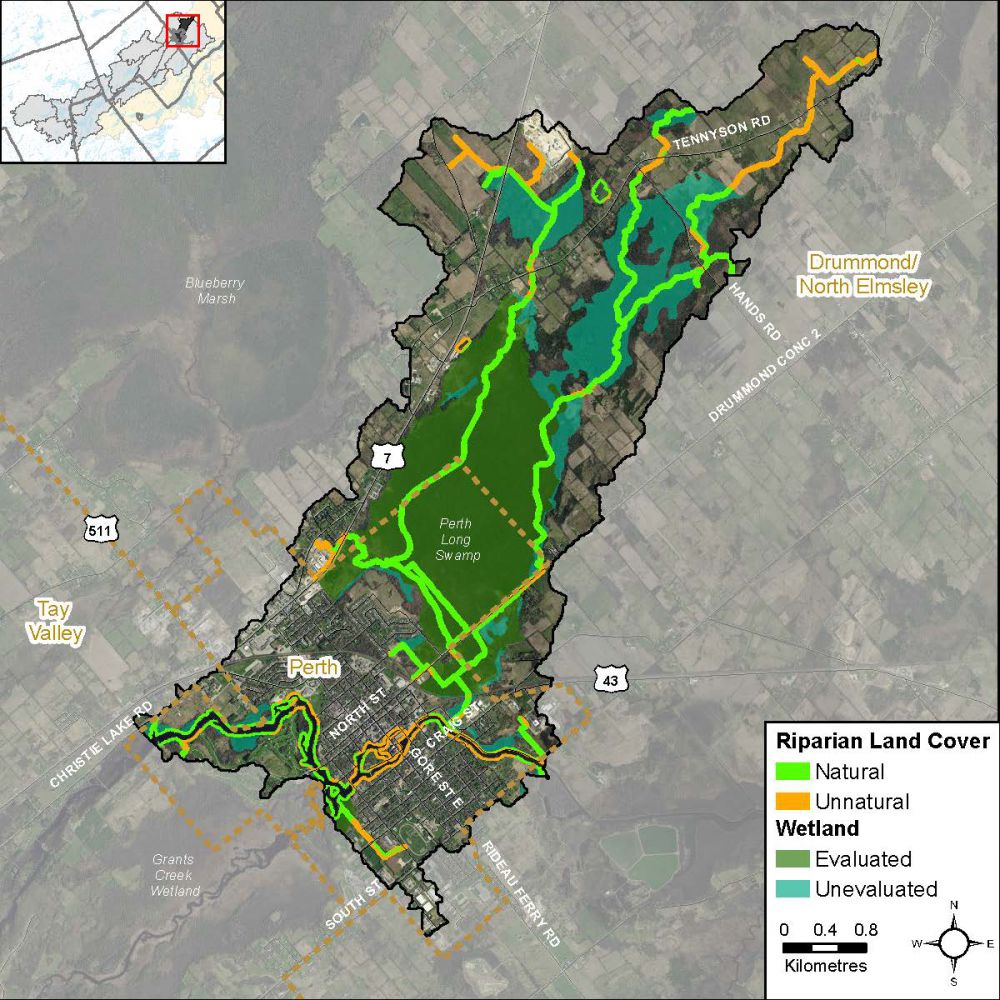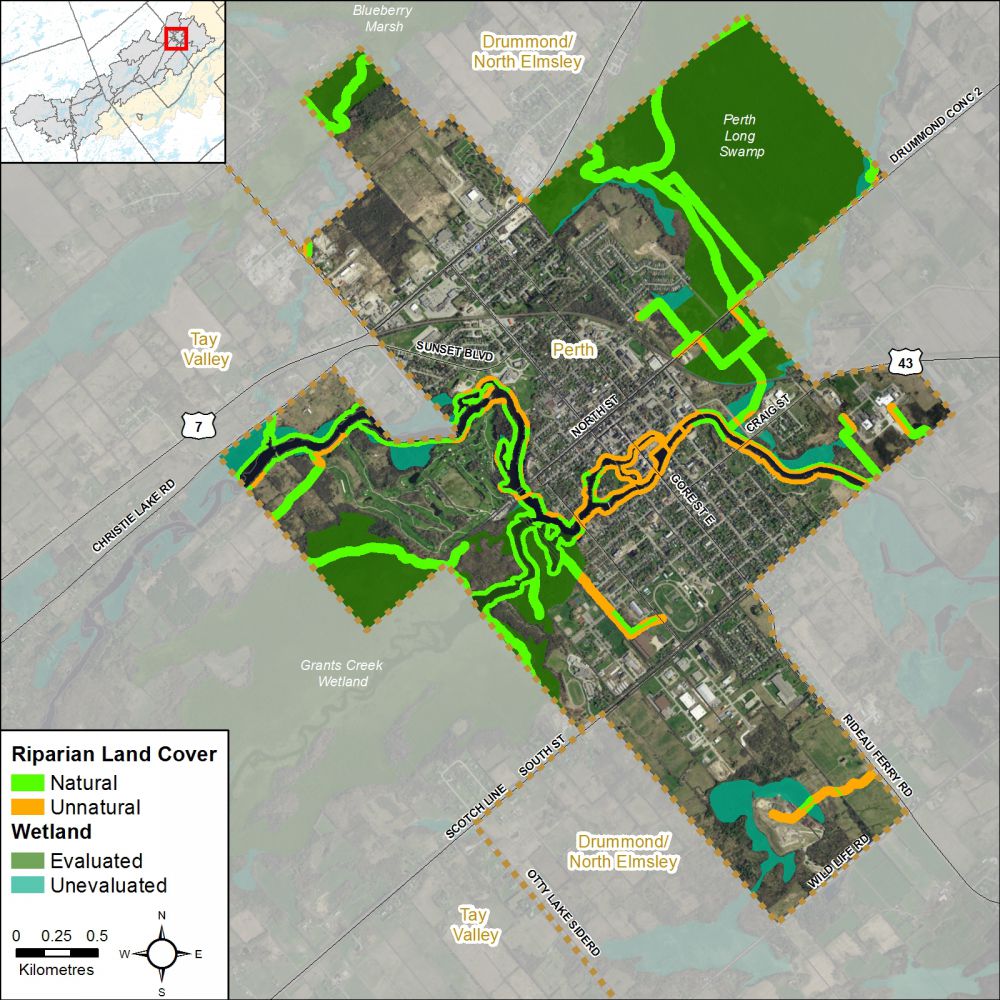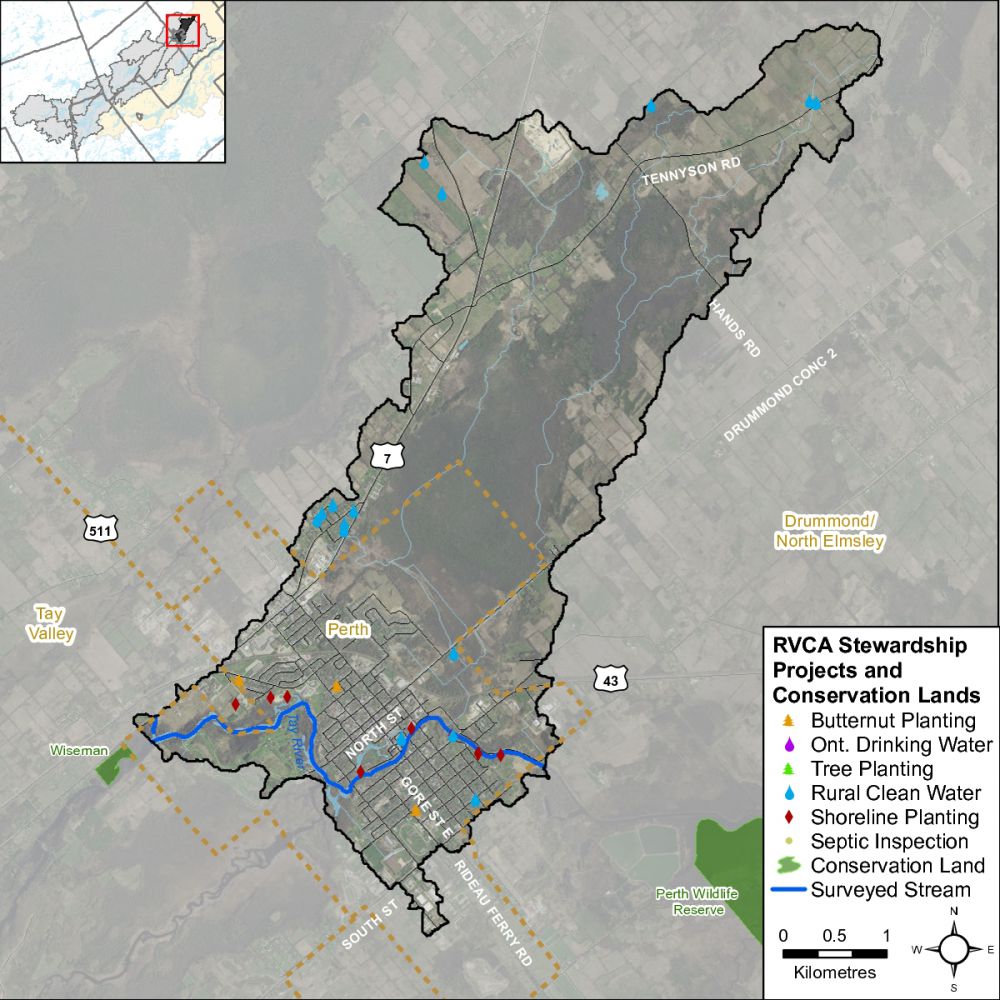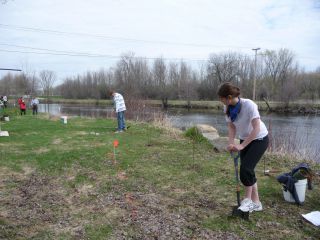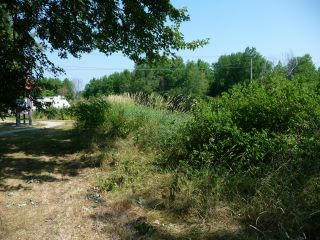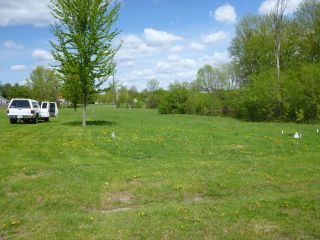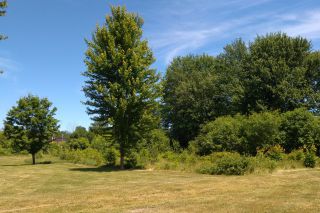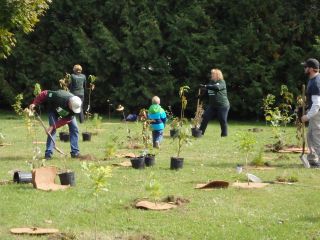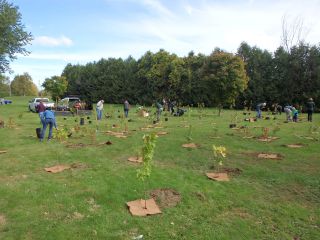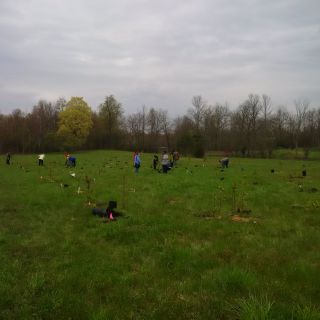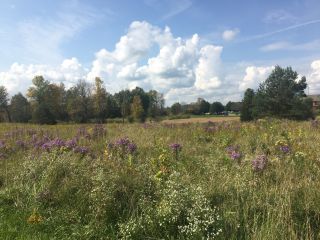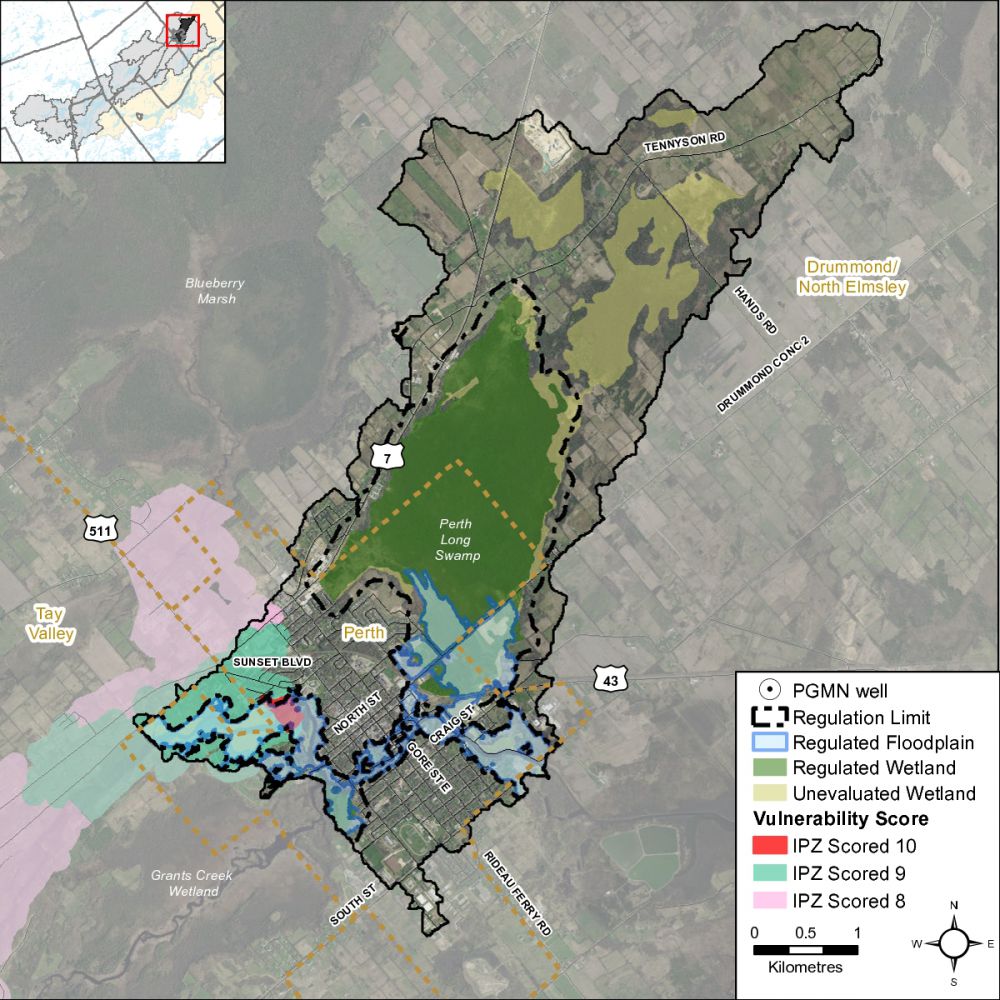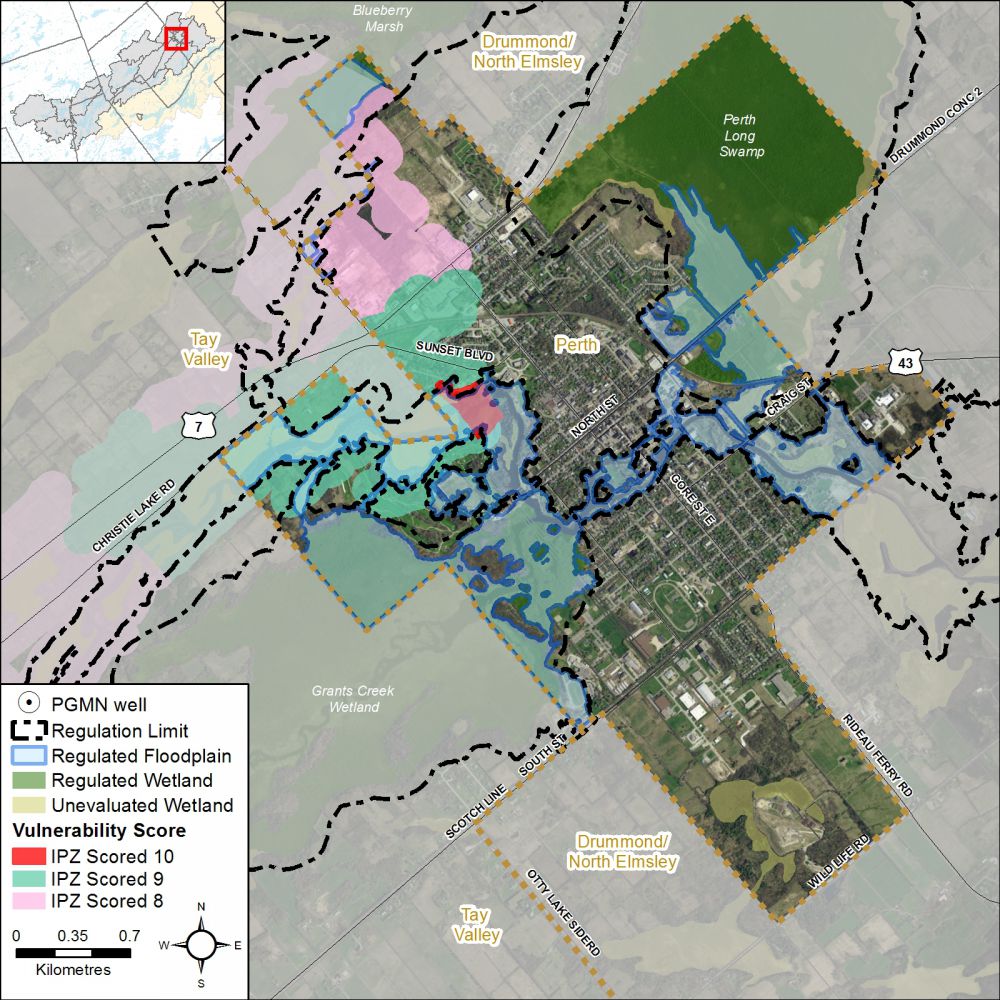Tay River Subwatershed Report 2017
PERTH CATCHMENT
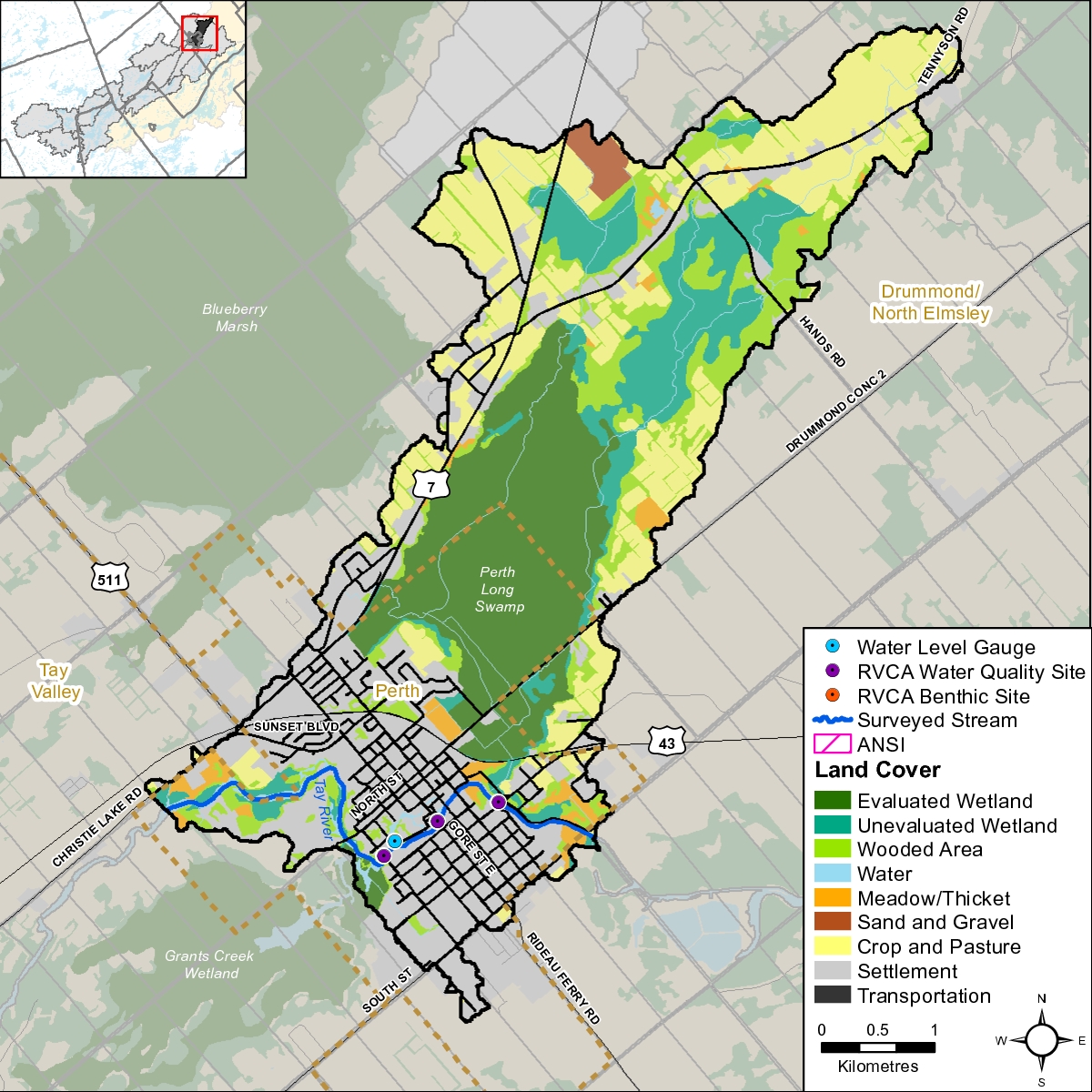 Figure 1
Figure 1 Land cover in the Perth catchment
The RVCA produces individual reports for 14 catchments in the Tay River subwatershed. Using data collected and analyzed by the RVCA through its watershed monitoring and land cover classification programs, surface water quality and in-stream conditions are reported for the Tay River, Tay Watershed lakes and Tay tributaries along with a summary of environmental conditions for the surrounding countryside every six years, which includes analysis of data collected through the programs along with local information provided by stakeholders up to 2017.
This information is used to better understand the effects of human activity on our water resources, allows us to better track environmental change over time and helps focus watershed management actions where they are needed the most to help sustain the ecosystem services (cultural, aesthetic and recreational values; provisioning of food, fuel and clean water; regulation of erosion/natural hazard protection and water purification; supporting nutrient/water cycling and habitat provision) provided by the catchment’s lands and forests and waters (Millennium Ecosystem Assessment 2005).
The following sections of this report are a compilation of that work for the Perth catchment.
For other Tay River catchments and the Tay River Subwatershed Report, please see Rideau Valley Conservation Authority Subwatershed Reports.
1.0 Perth Catchment: Facts
1.1 General/Physical Geography
Drainage Area
21.4 square kilometres; occupies 2.7 percent of the Tay River subwatershed; 0.5 percent of the Rideau Valley watershed.
Geology/Physiography
The Perth catchment resides predominantly within the physiographic region known as the Smith Falls Limestone Plain, which is a broad flat poorly drained region underlain by thin soils, dolostone and sandstone. A veneer of glacial drift (glacial till, sand etc.) overlies the bedrock and a number of geologic faults may run through this catchment.
Municipal Coverage
Drummond/North Elmsley Township: (13.2 km2; 62% of catchment)
Town of Perth (7.9 km2; 37% of catchment)
Tay Valley Township (0.2 km2; 1% of catchment)
Stream Length
All watercourses (including headwater streams): 35.1 km
1.2 Vulnerable Areas
Aquifer Vulnerability
Mississippi-Rideau Source Water Protection program has mapped only one very small part of this catchment as a Significant Groundwater Recharge Areas and all of the catchment as a Highly Vulnerable Aquifer (HVA). There are no Well-Head Protection Areas in the catchment.
Wetland Hydrology
A watershed model developed by the RVCA in 2009 was used to study the hydrologic function of wetlands in the Rideau Valley Watershed, including those found in the Perth catchment.
1.3 Conditions at a Glance
Aggregates
One aggregate license in the Perth catchment.
Fish Community/Thermal Regime
Warm and cool water recreational and baitfish fishery with 27 species observed in the Tay River during 2017.
Headwater Drainage Features
Multiple classifications of headwaters containing wetland, natural and undefined features along with historical modifications in the form of straightening (i.e., channelization).
Instream/Riparian Habitat
Tay River: Low to high habitat complexity was identified along the Tay River in the catchment. Regions with increased habitat complexity were observed in the upper and middle reaches of the system. Dissolved oxygen conditions along the system are fairly uniform for both warm and coolwater fish species.
Land Cover Change (2008 to 2014)
| Catchment | Woodland | Crop-Pasture | Settlement | Aggregate |
|---|
| Hectares |
-7 |
-4 |
+10 |
+1 |
Land Cover Change - Town of Perth (2008 to 2014)
| Town | Crop-Pasture | Woodland | Meadow-Thicket | Settlement |
|---|
| Hectares |
-6 |
-2 |
-1 |
+9 |
Land Cover Type - Perth Catchment (2014)
| Catchment | Wetland | Settlement | Crop-Pasture | Woodland | Transportation | Meadow-Thicket | Water | Aggregate |
|---|
| Percent |
32 |
22 |
22 |
12 |
7 |
2 |
1 |
1 |
Land Cover Type - Town of Perth (2014)
| Town | Settlement | Wetland | Woodland | Transportation | Crop-Pasture | Meadow-Thicket | Water |
|---|
| Percent |
37 |
27 |
12 |
9 |
9 |
4 |
2 |
Shoreline Cover Type (30 m. riparian area; 2014)
| Catchment-Wide | Percent | Tay River - Town | Percent | Streams* | Percent |
|---|
| Woodland |
50 |
Settlement |
36 |
Wetland |
62 |
| Wetland |
39 |
Woodland |
23 |
Crop-Pasture |
16 |
| Settlement |
4 |
Wetland |
19 |
Woodland |
8 |
| Crop-Pasture |
3 |
Transportation |
13 |
Settlement |
6 |
| MeadowThicket |
3 |
Meadow-Thicket |
7 |
Transportation |
5 |
| Transportation |
1 |
Crop-Pasture |
1 |
Meadow-Thicket |
2 |
| --- |
--- |
--- |
--- |
Aggregate |
1 |
*Excludes the Tay River
Significant Natural Features
Grants Creek Provincially Significant Wetland
Perth Long Swamp Provincially Significant Wetland
Species at Risk (Elemental Occurrence)
| Status | Species at Risk |
|---|
| Threatened |
Bobolink |
Eastern Meadowlark |
Water Quality (WQ) for the Protection of Aquatic Life (2006 to 2017)
| Tay River | @ Rogers Rd. | @ Gore St. | @ Craig St. |
|---|
| WQ Rating |
Fair to Good |
Good |
Fair to Good |
Water Wells
Approximately 350 operational, private water wells are to be found in the Perth catchment. Groundwater uses are mainly domestic but also include irrigation, industrial, livestock and commercial water supplies and monitoring wells.
Wetland Cover
Perth Catchment: Wetlands are reported to have covered 57 percent of the Perth catchment prior to European settlement, as compared to 32 percent (or 6.8 square kilometres) of the area in 2014. This represents a 44 percent (or 5.4 square kilometre) loss of historic wetland cover. Sixty-three percent of the remaining wetlands are regulated leaving 37 percent (or 2.5 square kilometers) unregulated.
Town of Perth: Wetlands are reported to have covered 61 percent of the Town of Perth prior to European settlement, as compared to 26 percent (or 3.2 square kilometres) of the area in 2014. This represents a 57 percent (or 4.2 square kilometre) loss of historic wetland cover. Eighty-six percent of the remaining wetlands are regulated leaving 14 percent (or 46 ha.) unregulated.
1.4 Catchment Care
Environmental Management
The Town of Perth has an established interest and commitment to environmental stewardship (including the application of innovative, water resources best management practices) as articulated in its Official Plan (2016 Consolidation) and Strategic Plan (2015). The basic premise for community sustainability is that environmental health is critical to human beings and to the wide diversity of plant and animal species with which we co-exist. The quality of our communities and standard of living depends on the air we breathe and the water that we drink, as well as the quality of the soil in the backyards where we play and in the fields and gardens from which our food is produced. In the coming years, human prosperity will depend on the health of the natural environment and the quality of human managed spaces.
The Town of Perth's vision for development embraces the concept of sustainable development through land use and infrastructure development decisions and operational practices that integrate human needs with the natural and built environment. Land use approvals and infrastructure redevelopment decisions will include sustainable design measures for transportation, infrastructure, waste management, energy systems and will strive for the efficient use of natural resources and preservation of historic, cultural and natural heritage features. The vision intends to be adaptive to innovative design and human activities that support sustainability.
The Town of Perth has completed a number of significant water resources projects to protect the surface water quality of the Tay River, in keeping with its vision for sustainable development and commitment to environmental stewardship, including:
- enhanced removal of total suspended solids during the treatment of drinking water at the Town's water treatment facility, which meets the provincial standard for water discharged to the Tay River (see Section 6.0 of this report)
- an intensive wet weather flow reduction program (e.g., sewer repairs/sealing; combined sewer elimination), which has reduced average inflows to the Town's wastewater lagoon system
- enhanced polishing of sewage waste from the Town's existing wastewater lagoon system using the SAGR system (see Section 6.0 of this report)
Development in, and adjacent to, the Perth Long Swamp and Grants Creek Provincially Significant Wetlands in the catchment are subject to Ontario Regulation 174-06 (entitled “Development, Interference with Wetlands and Alterations to Shorelines and Watercourses”) that protects the hydrologic function of the wetland and also protects landowners and their property from natural hazards (flooding, fluctuating water table, unstable soils) associated with them.
Ten active Permits To Take Water (PTTW) are located in the southwestern part of this catchment along with one other active PTTW in its northern part, all for municipal water supply, golf course irrigation, condo heat pumps, groundwater remediation, industrial use and aggregate operations.
Several Environmental Compliance Approvals and Environmental Activity and Sector Registries were sought in this catchment for municipal drinking water systems and sewage works along with construction dewatering.
Environmental Monitoring
Town of Perth actively monitors surface water released to the Tay River as part of the Town's commitment to applying best environmental management practices through the treatment of its drinking water and sanitary/storm sewer discharge.
Chemical surface (in-stream) water quality collection by the RVCA since 2003 (see Section 2.1 of this report).
Fish survey and stream characterization survey by the RVCA on the Tay River in 2017 included taking measurements and recording observations on instream habitat, bank stability, other attributes and preparing a temperature profile (see Section 3 of this report).
Seven drainage feature assessments were conducted by the RVCA in 2017 at road crossings in the catchment. The protocol measures zero, first and second order headwater drainage features and is a rapid assessment method characterizing the amount of water, sediment transport, and storage capacity within headwater drainage features (see Section 3.4 of this report).
Classification of Perth catchment land cover types derived by the RVCA from colour aerial photography that was acquired during the spring of 2008 and 2014 (see Section 4.1 of this report).
Stewardship
Twenty-seven stewardship projects were completed by landowners with assistance from the RVCA (see Section 5 of this report).
2.0 Perth Catchment: Water Quality Conditions
Surface water quality conditions in the Perth catchment are monitored by the Rideau Valley Conservation Authority (RVCA) Baseline Water Quality Monitoring Program. The baseline water quality program focuses on streams; data is collected for 22 parameters including nutrients (total phosphorus and total Kjeldahl nitrogen), E. coli, metals (like aluminum and copper) and additional chemical/physical parameters (such as alkalinity, chlorides, pH and total suspended solids). Figure 2 shows the locations of monitoring sites in the catchment.
Figure 2 Water quality monitoring sites on the Tay River in the Perth catchment
2.1 Tay River: Water Quality Rating
Three locations are monitored for water quality within the urban portion of the Town of Perth (Figure 2). The RVCA's water quality rating ranges from "Fair" to "Good" (Table 1) along the Tay River in the catchment, as determined by the Canadian Council of Ministers of the Environment (CCME) Water Quality Index.
A "Fair" rating indicates that water quality is usually protected but is occasionally threatened or impaired; conditions sometimes depart from natural or desirable levels. "Good" indicates that only a minor degree of threat or impairment is observed and conditions rarely depart from natural or desirable levels. Each parameter is evaluated against established guidelines to determine water quality conditions. Those parameters that frequently exceed guidelines are presented below.
Data has been analyzed over the 2006-2017 period for general trends and conditions. Table 1 shows the overall rating for the monitored surface water quality sites within the catchment and Table 2 outlines the Water Quality Index (WQI) scores and their corresponding ratings. The scores at these sites are largely influenced by few high nutrient concentrations and bacterial counts. For more information on the CCME WQI, please see the Tay River Subwatershed Report.
Table 1 Water Quality Index ratings for the Tay River in the Town of Perth
Table 2 Water Quality Index ratings and corresponding index scores (RVCA terminology, original WQI category names in brackets)
2.1.1 Tay River: Nutrients
Total phosphorus (TP) is used as a primary indicator of excessive nutrient loading and may contribute to abundant aquatic vegetation growth and depleted dissolved oxygen levels. The Provincial Water Quality Objective (PWQO) is used as the TP Guideline and states that in streams concentrations greater than 0.030 mg/l indicate an excessive amount of TP.
Total Kjeldahl nitrogen (TKN) is used as secondary indicators of nutrient loading. RVCA uses a guideline of 0.500 mg/l to assess TKN[1] .
Tables 3 and 4 summarize average nutrient concentrations at monitored sites within the Perth catchment and show the proportion of results that meet the guidelines.
Table 3 Summary of total phosphorus results for the Perth Catchment (2006-2017).
Table 4 Summary of total Kjeldahl nitrogen results for the Perth Catchment catchment (2006-2017).
Monitoring Site TAY-04
Site TAY-04 is the most upstream site within the Town of Perth. The majority (88 percent) of samples at this site were below the TP guideline from 2006-2017 (Figures 3 and 4). The average TP concentration in the at this site was 0.021 mg/l (Table 3), the monthly average concentrations appear higher in the spring and early summer and decline into the fall (Figure 3). In August the average concentrations exceeded the guideline (Figure 3), however this seems to be due to the influence of a single elevated sample in August 2011 (Figure 4) and does not reflect typical concentrations. Overall a decrease was observed in TP concentrations over the 2006-2017 period2.
TKN concentrations show that the bulk of results (65 percent) were also below the guideline (Figure 6, Table 4). The average concentration over the 2006-2017 period was 0.499 mg/l (Table 4); monthly averages increased from April to August, with lower concentrations observed in the fall months (Figure 5). There was no significant trend found in TKN results at this site.
Monitoring Site TAY-08
Site TAY-08 is downstream of TAY-04 and within the urban portion of Perth. TP results were low, the average concentrations was 0.018 and 97 percent of samples were below the guideline (Table 3, Figure 4). Monthly TP concentrations followed a similar pattern to upstream site TAY-04, with the highest concentrations observed from May-July, average TP concentrations did not exceed the guideline in any of the monitored months (Figure 3). A declining trend in TP concentrations was also observed in the data from this site.
The majority of TKN results were below the guideline (Figure 5 and 6), 69 percent of samples were below 0.500 mg/l (TKN Guideline) with an average concentration of 0.462 mg/l (Table 4). Average monthly concentrations were comparable and also followed a similar pattern to TAY-04 (Figure 5). No significant trend was observed in the 2006-2017 TKN dataset.
Monitoring Site TAY-19
Site TAY-19 is the most downstream site within the Town of Perth, TP concentrations are comparable to both upstream sites (TAY-04 and TAY-08) previously discussed (Figure 3). Ninety-two percent of samples at this site were below the TP guideline from 2006-2017 (Figures 3 and 4), and the average TP concentration in the at this site was 0.020 mg/l (Table 3). The monthly average concentrations were also the highest from May to July and no average monthly concentration exceeded the guideline (Figure 3). A decrease was observed in TP concentrations over the 2006-2017 period.
TKN concentrations show that the bulk of results (65 percent) were also below the guideline (Figure 6, Table 4). The average concentration over the 2006-2017 period was 0.476 mg/l (Table 4). Average monthly concentrations (Figure 5) show a similar pattern to upstream sites (TAY-04 and TAY-08) with generally comparable concentrations. No trend in TKN concentrations was observed at this site.
Figure 3 Average monthly total phosphorous concentrations in the Town of Perth catchment, 2006-2017
Figure 4 Distribution of total phosphorous concentrations in the Town of Perth catchment, 2006-2017
Figure 5 Average monthly total Kjeldahl nitrogen concentrations in the Town of Perth catchment, 2006-2017
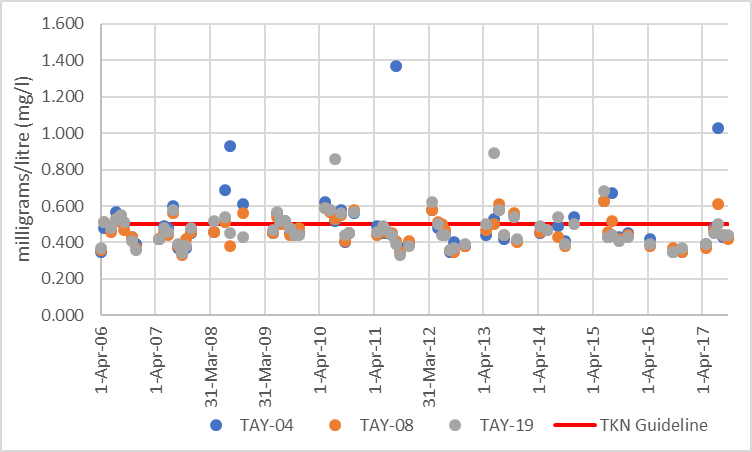 Figure 6
Figure 6 Distribution of total Kjeldahl nitrogen concentrations in the Town of Perth catchment, 2006-2017
Summary of Tay River Nutrients
The data collected in this catchment provides evidence that nutrient enrichment is not a significant concern in this reach of the Tay River. Overall, the consistency in TP and TKN concentrations from TAY-04 to TAY-19 support that there is little nutrient enrichment as the Tay River flows through the Town of Perth. A declining trend in TP concentrations was also noted at all sites. This provides support that cumulative changes throughout the catchment has reduced nutrient concentrations. This should be taken as a positive sign as high nutrient concentrations can help stimulate the growth of algae blooms and other aquatic vegetation in a waterbody and deplete oxygen levels as the vegetation dies off. It is important to continue using best management practices that help prevent nutrient pollution in the Tay River; measures such as maintaining/upgrading municipal infrastructure (sanitary/stormwater sewers and water works), enhancing shoreline buffers, minimizing/discontinuing the use of fertilizers and restricting livestock access in upstream agricultural areas of the catchment.
2.1.2 Tay River E. coli
Escherichia coli (E. coli) is used as an indicator of bacterial pollution from human or animal waste; in elevated concentrations it can pose a risk to human health. The PWQO of 100 colony forming units/100 milliliters (CFU/100 ml) is used. E. coli counts greater than this guideline indicate that bacterial contamination may be a problem within a waterbody.
Table 5 summarizes the geometric mean[3] for the monitored sites within the Town of Perth catchment and shows the proportion of samples that meet the E. coli guideline of 100 CFU/100 ml. The results of the geometric mean with respect to the guideline, are shown in Figures 7 and 8 respectively.
Table 5 Summary of
E. coli results for the Tay River-Town of Perth Catchment, 2006-2017.
Monitoring Site TAY-04
E. coli counts at site TAY-04 indicate that counts regularly exceed the guideline of 100 CFU/100ml. Fifty percent of samples were below the guideline (Figures 7-8) and the count at the geometric mean was only 80 CFU/100ml (Table 5). Monthly E. coli counts showed that the geometric mean was highest during the warmer months and counts exceeded the guideline in June, August and September. Warm water temperatures are more favourable for bacterial growth. (Figure 7). No trend was noted in E. coli counts over the 2006-2017 period.
Monitoring Site TAY-08
Elevated E. coli counts at site downstream site TAY-08 were also common. Fifty-one percent of samples were below the guideline (Figure 8) from 2006-2017 and the count at the geometric mean was 72 CFU/100ml (Table 5). The highest counts were recorded in June and August (Figure 7). As with site TAY-09 there was no significant trend in E. coli data over the 2006-2017 period.
Monitoring Site TAY-19
E. coli counts at site TAY-19 was comparable to those upstream (TAY-04 and TAY-08). Forty-six percent of samples were below the guideline, with count of 86 CFU/100ml at the geometric mean (Table 5, Figure 8). Monthly E. coli counts were above the guideline from June-September (Figure 7). As with upstream sites, no trend was noted in E. coli counts over the 2006-2017 period.
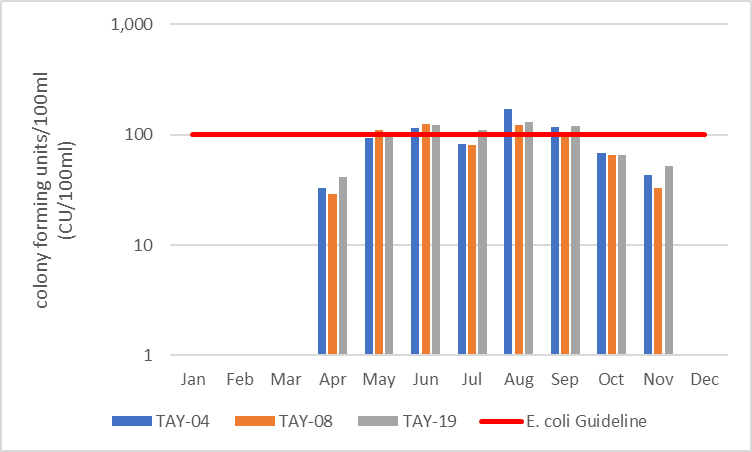 Figure 7
Figure 7 Geometric mean of E. coli results in the Town of Perth catchment, 2006-2017
Figure 8 Distribution of E. coli counts in the Town of Perth catchment, 2006-2017.
Summary of Tay River Bacterial Contamination
Given the frequency of samples that exceed the guidelines and counts approaching the guideline at all three sites, there is evidence that at times bacterial pollution is a concern within this reach of the Tay River. The data is comparable between all three sites thus does not provide sufficient information to; pinpoint possible sources of pollution; Minimizing runoff from infrastructure and roadways should be a priority in this catchment, such as ongoing efforts to improve storm water management within developed areas. Best management practices such as maintaining/enhancing municipal infrastructure, enhancing shoreline buffers, limiting livestock access and minimizing runoff in both agricultural and developed areas can help to protect this reach of the Tay River into the future.
1 No Ontario guideline for TKN is presently available; however, waters not influenced by excessive organic inputs typically range from 0.100 to 0.500 mg/l, Environment Canada (1979) Water Quality Sourcebook, A Guide to Water Quality Parameters, Inland Waters Directorate, Water Quality Branch, Ottawa, Canada.
2 Trends in the data were assessed using the Mann-Kendall trend test and Sens slope statistic.
3 Type of mean or average, which indicates the central tendency or typical value of a set of numbers by using the product of their values (as opposed to the arithmetic mean which uses their sum). It is often used to summarize a variable that varies over several orders of magnitude, such as E. coli counts.
3.0 Perth Catchment: Riparian Conditions
The RVCA Stream Characterization Program surveyed 4.6 kilometres (46 sections) of the Tay River in July 2017 within the Perth catchment.
In 2017 the Tay River subwatershed experienced high water levels along the Tay River and its tributaries. After moving from two years of drought conditions in 2015 and 2016 heavy rains throughout the year made 2017 the wettest year in recorded history. Precipitation was close to normal in the Tay River watershed in January, 2017. Most of the rest of the year, however, the area got much more than normal. For the year the total precipitation was over 130% of normal. The spring snowmelt peak flow was an above average 57 cubic metres per second (cms) in Perth on April 6. Flows receded there until more than 100 mm of rain fell over the first week of May causing a peak flow on May 7 of 71 cms, a flow not previously reached in the 24 years of records. Flows increased once again at the end of October as a result of another heavy rainfall totaling 124 mm over nine days that caused a considerable delay in construction of the rocky ramp replacement for the Haggart Island Dam.
Flooding along the Tay River in Stewart Park during the spring of 2017
3.1 Perth Catchment Overbank Zone
3.1.1 Riparian Land Cover Buffer Evaluation
The quality of the riparian area increases with the width, complexity and linear extent of its vegetation along a stream or creek. A complex riparian community consists of diverse plant species native to the site, with multiple age-classes providing vertical structural diversity along a watercourse.
Here is a list of watershed benefits from a healthy riparian buffer zone:
- Reduces the amount of pollutants that reach the stream from surface runoff
- Helps reduce and mitigates erosion
- Provides a microclimate that is cooler during the summer months providing cooler water for aquatic organisms
- Provides large wood structure from fallen trees and limbs that form instream cover, create pools, stabilize the streambed, and provide habitat for aquatic organisms in lower order streams
- Provides habitat for terrestrial insects that drop in the stream and become food for fish and travel corridors for other terrestrial animals
- Dissipates energy during flood events
- Often provides the only refuge areas for fish during out-of-bank flows (behind trees, stumps, and logs)
Figure 9 demonstrates the buffer conditions of the left and right banks separately. The Tay River had a buffer of greater than 30 meters along 65 percent of the left bank and 46 percent of the right bank.
Figure 9 Riparian Buffer Evaluation along the Tay River in the Perth catchment
3.1.2 Riparian Buffer Alterations
Alterations within the riparian buffer were assessed within three distinct shoreline zones (0-5m, 5-15m, 15-30m), and evaluated based on the dominant vegetative community and/or land cover type (Figure 10). The riparian buffer zone along the Tay River was found to be dominated by forest, scrubland, wetlands and meadow conditions. There were several areas that had altered riparian zone conditions along the Tay River. These areas included shoreline modifications in the form of armour stone, wooden retaining walls, gabion baskets, concrete and rip rap. Modifications also included a number of road crossings and areas with reduced natural vegetated buffer conditions. Opportunities for shoreline buffer enhancements along the Tay River in the Town of Perth catchment should be explored and implemented where possible.
Figure 10 Riparian buffer alterations along Tay River in the Perth catchment
3.1.3 Adjacent Land Use
The RVCA’s Stream Characterization Program identifies nine different land uses along the Tay River in the Town of Perth (Figure 11). Surrounding land use is considered from the beginning to end of the survey section (100m) and up to 100m on each side of the river. Land use outside of this area is not considered for the surveys but is nonetheless part of the subwatershed and will influence the creek. Scrubland habitat was dominant at 91 percent; forest and wetlands were found along 61 percent of the surveyed sections and 11 percent meadow habitat was present along the Tay River. The remaining land use consisted of residential, recreational, industrial/commercial and infrastructure in the form of road crossings.
Figure 11 Land Use along the Tay River in the Perth catchment
3.2 Perth Catchment Shoreline Zone
3.2.1 Instream Erosion
Stream erosion is the process by which water erodes and transports sediments, resulting in dynamic flows and diverse habitat conditions. Excessive erosion can result in drastic environmental changes, as habitat conditions, water quality and aquatic life are all negatively affected. Bank stability was assessed as the overall extent of each section with “unstable” shoreline conditions. These conditions are defined by the presence of significant exposed soils/roots, minimal bank vegetation, severe undercutting, slumping or scour and potential failed erosion measures. The majority of the Tay River had no erosion observed along the majority of surveyed sections with a few small sections having low levels of erosion (Figure 12).
Figure 12 Erosion levels along the Tay River in the Perth catchment
3.2.2 Undercut Stream Banks
Stream bank undercuts can provide excellent cover habitat for aquatic life, however excessive levels can be an indication of unstable shoreline conditions. Bank undercut was assessed as the overall extent of each surveyed section with overhanging bank cover present. Figure 13 shows that the Tay River had no observed undercut banks along the majority of the system, however there were several sections in the lower reach with low levels of undercut banks.
Figure 13 Undercut stream banks along the Tay River in the Perth catchment
3.2.3 Stream Shading
Grasses, shrubs and trees all contribute towards shading a stream. Shade is important in moderating stream temperature, contributing to food supply and helping with nutrient reduction within a stream. Stream cover is assessed as the total coverage area in each section that is shaded by overhanging trees/grasses and tree canopy, at greater than 1m above the water surface. Figure 14 shows low levels of stream shading along the Tay River. Stream shading conditions were fairly uniform along the Tay River ranging from no overhead canopy cover to low levels. There were two areas along the Tay River that reached moderate levels of stream shading.
Figure 14 Stream shading along the Tay River in the Perth catchment
3.2.4 Instream Wood Structure
Forested shorelines provide essential complex habitat through the perpetual process of shoreline trees falling into the water. This continuous recruitment of trees creates a wood-based physical structure in the littoral zone that is common on natural systems. Insects, fish, amphibians, birds, and other animals have also evolved with this abundance of near shore wood and it is essential to their life cycles. With increased development along many waterways and forested lakeshores having been altered as a result wood-based physical structure in many waterbodies has been reduced. It is important to restore this essential habitat to aquatic ecosystems.
Shoreline Protection
- Protects shorelines by providing a barrier from wind and wave erosion
- Reduces sedimentation of the water caused by shoreline slumping due to bank erosion
- Allows detritus to collect and settle on the lake or creek bed providing the substrate structure required for native aquatic vegetation to establish and outcompete invasive species
Food Source
- Wood complexes are an important food source for invertebrates
- Small fish feed on the abundance of invertebrates that are found around these structures
- Larger fish, waterfowl and shorebirds all benefit from the abundance of invertebrates and small fish feeding around woody structures in the littoral zone
Cover
- Cover from predators is essential for many fish and animals to successfully complete their life cycle
- The nooks and crannies of wood complexes offer critters safety from predators while at the same time concentrating prey to make predators more efficient
- Wood provides the structure on which many species must lay or attach their eggs, therefore these complexes provide quality spawning and nesting habitat
Diversity
- Wood complexes in the littoral zone provide unique edge habitat along the shoreline
- Edge habitats contain more species diversity and higher concentrations of species than the adjoining habitats themselves will have
Figure 15 shows that the majority of the Tay River had low levels of instream wood structure along the system. There were several stream survey sections in the upper reach which were characterized as having moderate levels of instream wood structure in the form of branches and trees along the system.
Figure 15 Instream wood structure along the Tay River in the Perth catchment
3.2.5 Overhanging Wood Structure
Trees and branches that are less than one meter from the surface of the water are defined as overhanging. Overhanging wood structure provides a food source, nutrients and shade which helps to moderate instream water temperatures. Figure 16 shows the system is variable with no overhanging branches and trees to areas that have high levels of overhanging wood structure along the Tay River.
Figure 16 Overhanging wood structure along the Tay River in the Perth catchment
3.2.6 Anthropogenic Alterations
Stream alterations are classified based on specific functional criteria associated with the flow conditions, the riparian buffer and potential human influences. Figure 17 shows fifteen percent of the Tay River remains “unaltered” with no anthropogenic alterations. Forty six percent of the Tay River was classified as natural with minor anthropogenic changes. Thirty five percent of survey sections were classified as being altered and four percent was classified as highly altered. These areas consisted of sections with shoreline modifications and road crossings.
Figure 17 Anthropogenic alterations along the Tay River in the Perth catchment
3.3 Perth Catchment Instream Aquatic Habitat
3.3.1 Habitat Complexity
Habitat complexity is a measure of the overall diversity of habitat types and features within a stream. Streams with high habitat complexity support a greater variety of species niches, and therefore contribute to greater diversity. Factors such as substrate, flow conditions (pools, riffles) and cover material (vegetation, wood structure, etc.) all provide crucial habitat to aquatic life. Habitat complexity is assessed based on the presence of boulder, cobble and gravel substrates, as well as the presence of instream wood structure.
Low to high habitat complexity was identified for the Tay River in the Town of Perth catchment (Figure 18). Regions with increased habitat complexity were observed in the upper and middle reaches of the system within the catchment.
Figure 18 Habitat complexity along the Tay River in the Perth catchment
3.3.3 Instream Substrate
Diverse substrate is important for fish and benthic invertebrate habitat because some species have specific substrate requirements and for example will only reproduce on certain types of substrate. The absence of diverse substrate types may limit the overall diversity of species within a stream. Substrate conditions were highly diverse along the Tay River with all substrate types being recorded at various locations along the system (Figure 19). Figure 20 shows the dominant substrate type observed for each section surveyed along the Tay River.
Figure 19 Instream substrate along the Tay River in the Perth catchment
Figure 20 shows the dominant substrate type along the Tay River in the Perth catchment
3.3.4 Instream Morphology
Pools and riffles are important habitat features for aquatic life. Riffles are fast flowing areas characterized by agitation and overturn of the water surface. Riffles thereby play a crucial role in contributing to dissolved oxygen conditions and directly support spawning for some fish species. They are also areas that support high benthic invertebrate populations which are an important food source for many aquatic species. Pools are characterized by minimal flows, with relatively deep water and winter/summer refuge habitat for aquatic species. Runs are moderately shallow, with unagitated surfaces of water and areas where the thalweg (deepest part of the channel) is in the center of the channel. Figure 21 shows that the Tay River is somewhat uniform; 100 percent of sections recorded runs, 57 percent pools and 7 percent riffles. Figure 22 shows where the limited riffle habitat areas were observed along the Tay River.
Figure 21 Instream morphology along the Tay River in the Perth catchment
Figure 22 Instream riffle habitat along the Tay River in the Perth catchment
3.3.5 Vegetation Type
Instream vegetation provides a variety of functions and is a critical component of the aquatic ecosystem. Aquatic plants promote stream health by:
- Providing direct riparian/instream habitat
- Stabilizing flows reducing shoreline erosion
- Contributing to dissolved oxygen through photosynthesis
- Maintaining temperature conditions through shading
For example emergent plants along the shoreline can provide shoreline protection from wave action and important rearing habitat for species of waterfowl. Submerged plants provide habitat for fish to find shelter from predator fish while they feed. Floating plants such as water lilies shade the water and can keep temperatures cool while reducing algae growth. Submerged plants were dominant in this reach of the Tay River and were observed at 100 percent of surveyed sections. Broad leaved emergents were observed in 85 percent of sections, 78 percent floating plants, 76 percent narrow leaved emergents, 72 percent of sections contained algae, 63 percent free floating, while robust emergents were present in 54 percent of the survey sections. Figure 23 depicts the plant community structure for the Tay River. Figure 24 shows the dominant vegetation type observed for each section surveyed along the Tay River in the Perth catchment.
Figure 23 Vegetation type along the Tay River in the Perth catchment
Figure 24 Dominant vegetation type along the Tay River in the Perth catchment
3.3.6 Instream Vegetation Abundance
Instream vegetation is an important factor for a healthy stream ecosystem. Vegetation helps to remove contaminants from the water, contributes oxygen to the stream, and provides habitat for fish and wildlife. Too much vegetation can also be detrimental. Figure 25 demonstrates that the Tay River had normal to common levels of vegetation recorded at 89 and 57 percent of stream surveys. Extensive levels of vegetation were observed in 59 percent of the surveyed sections, while twenty eight percent of sections had no vegetation in areas that were dominated by bedrock substrate conditions.
Figure 25 Instream vegetation abundance along the Tay River in the Perth catchment
3.3.7 Invasive Species
Invasive species can have major implications on streams and species diversity. Invasive species are one of the largest threats to ecosystems throughout Ontario and can out compete native species, having negative effects on local wildlife, fish and plant populations. Eighty nine percent of the sections surveyed along the Tay River in the Perth catchment had invasive species. The invasive species observed were common/glossy buckthorn, banded mystery snail, bull thistle, curly leafed pondweed, dog strangling vine, Eurasian milfoil, European frogbit, Himalayan balsam, honey suckle, Manitoba maple, wild parsnip and purple loosestrife. Invasive species abundance (i.e. the number of observed invasive species per section) was assessed to determine the potential range/vector of many of these species (Figure 26).
\
Figure 26 Invasive species abundance along the Tay River in the Perth catchment
3.3.8 Water Chemistry
During the stream characterization survey, a YSI probe is used to collect water chemistry information. Dissolved oxygen (DO), specific conductivity (SPC) and pH are measured at the start and end of each section.
3.3.8.1 Dissolved Oxygen
Dissolved oxygen is a measure of the amount of oxygen dissolved in water. The Canadian Environmental Quality Guidelines of the Canadian Council of Ministers of the Environment (CCME) suggest that for the protection of aquatic life the lowest acceptable dissolved oxygen concentration should be 6 mg/L for warmwater biota and 9.5 mg/L for coldwater biota (CCME, 1999). Figure 27 shows that the dissolved oxygen in Tay River supports warmwater and coolwater biota along the system. The average dissolved oxygen level observed within the Perth catchment was 7.0mg/L which meets the recommended level for warm and cool water biota.
Figure 27 Dissolved oxygen ranges along the Tay River in the Perth catchment
3.3.8.2 Conductivity
Conductivity in streams is primarily influenced by the geology of the surrounding environment, but can vary drastically as a function of surface water runoff. Currently there are no CCME guideline standards for stream conductivity; however readings which are outside the normal range observed within the system are often an indication of unmitigated discharge and/or stormwater input. The average conductivity observed within the Tay River was 198.3 µs/cm. Figure 28 shows the conductivity readings for the Tay River in the Perth catchment.
Figure 28 Specific conductivity ranges along the Tay River in the Perth catchment
3.3.8.3 pH
Based on the PWQO for pH, a range of 6.5 to 8.5 should be maintained for the protection of aquatic life. Average pH values along the Tay River were 7.4 thereby meeting the provincial standard (Figure 29).
Figure 29 pH ranges along the Tay River in the Perth catchment
3.3.8.4 Oxygen Saturation (%)
Oxygen saturation is measured as the ratio of dissolved oxygen relative to the maximum amount of oxygen that will dissolve based on the temperature and atmospheric pressure. Well oxygenated water will stabilize at or above 100% saturation, however the presence of decaying matter/pollutants can drastically reduce these levels. Oxygen input through photosynthesis has the potential to increase saturation above 100% to a maximum of 500%, depending on the productivity level of the environment. In order to represent the relationship between concentration and saturation, the measured values have been summarized into 6 classes:
Dissolved oxygen conditions for the Tay River were fairly uniform along the system for both warm and coolwater species (Figure 30).
Figure 30 A bivariate assessment of dissolved oxygen concentration (mg/L) and saturation (%) along the Tay River in the Perth catchment
3.3.8.5 Specific Conductivity Assessment
Specific conductivity (SPC) is a standardized measure of electrical conductance, collected at or corrected to a water temperature of 25⁰C. SPC is directly related to the concentration of ions in water, and is commonly influenced by the presence of dissolved salts, alkalis, chlorides, sulfides and carbonate compounds. The higher the concentration of these compounds, the higher the conductivity. Common sources of elevated conductivity include storm water, agricultural inputs and commercial/industrial effluents.
In order to summarize the conditions observed, SPC levels were evaluated as either normal, moderately elevated or highly elevated. These categories correspond directly to the degree of variation (i.e. standard deviation) at each site relative to the average across the system.
Normal levels were maintained in the middle reaches of the Tay River, however there were elevated areas in the upper and lower reaches (Figure 31). Two sections had high conductivity levels observed in the lower reach and several sections had moderate levels observed also in the lower reach.
Figure 31 Relative specific conductivity levels along the Tay River in the Perth catchment
3.3.9 Thermal Regime
Many factors can influence fluctuations in stream temperature, including springs, tributaries, precipitation runoff, discharge pipes and stream shading from riparian vegetation. Water temperature is used along with the maximum air temperature (using the Stoneman and Jones method) to classify a watercourse as either warm water, cool water or cold water. Figure 32 shows where the thermal sampling sites were located on the Tay River in the Perth catchment. Analysis of the data collected indicates that the Tay River is classified as a warm water system (Figure 33).
Figure 32 Temperature logger locations along the Tay River in the Perth catchment
Figure 33 Temperature logger data for the sites along the Tay River in the Perth catchment
Each point on the graph represents a temperature that meets the following criteria:
- Sampling dates between July 1st and September 7th
- Sampling date is preceded by two consecutive days above 24.5 °C, with no rain
- Water temperatures are collected at 4pm
- Air temperature is recorded as the max temperature for that day
3.3.10 Groundwater
Groundwater discharge areas can influence stream temperature, contribute nutrients, and provide important stream habitat for fish and other biota. During stream surveys, indicators of groundwater discharge are noted when observed. Indicators include: springs/seeps, watercress, iron staining, significant temperature change and rainbow mineral film. Figure 34 shows areas where one or more of the above groundwater indicators were observed during stream surveys and headwater assessments.
Figure 34 Groundwater indicators observed in the Perth catchment
3.3.11 Fish Community
The Perth catchment is classified as a mixed community of warm and cool water recreational and baitfish fishery with 27 species observed (Figure 35).
Figure 35 Fish community sampling observations in the Perth catchment
Table 6 contains a list of fish species observed in the Perth catcmment.
Table 6 Fish species observed in the Perth catchment
RVCA staff measuring and weighing fish while sampling on the Tay River in the Perth catchment
A fyke net set along the Tay River in the Perth catchment in July of 2017
3.3.12 Migratory Obstructions
It is important to know locations of migratory obstructions because these can prevent fish from accessing important spawning and rearing habitat. Migratory obstructions can be natural or manmade, and they can be permanent or seasonal. Figure 36 shows that the Perth catchment had one weir and one man made dam on the Tay River at the time of the survey in 2017.
Figure 36 Migratory obstructions in the Perth catchment
A weir located on the Tay River in the Perth catchment
3.4 Headwater Drainage Feature Assessment
3.4.1 Headwaters Sampling Locations
The RVCA Stream Characterization program assessed Headwater Drainage Features for the Tay River catchment in 2017. This protocol measures zero, first and second order headwater drainage features (HDF). It is a rapid assessment method characterizing the amount of water, sediment transport, and storage capacity within headwater drainage features (HDF). RVCA is working with other Conservation Authorities and the Ministry of Natural Resources and Forestry to implement the protocol with the goal of providing standard datasets to support science development and monitoring of headwater drainage features. An HDF is a depression in the land that conveys surface flow. Additionally, this module provides a means of characterizing the connectivity, form and unique features associated with each HDF (OSAP Protocol, 2013). In 2017 the program sampled 7 sites at road crossings in the Perth catchment area (Figure 37).
Figure 37 Locations of the headwater sampling sites in the Perth catchment
3.4.2 Headwater Feature Type
The headwater sampling protocol assesses the feature type in order to understand the function of each feature. The evaluation includes the following classifications: defined natural channel, channelized or constrained, multi-thread, no defined feature, tiled, wetland, swale, roadside ditch and pond outlet. By assessing the values associated with the headwater drainage features in the catchment area we can understand the ecosystem services that they provide to the watershed in the form of hydrology, sediment transport, and aquatic and terrestrial functions. The headwater drainage features in the Perth catchment are highly variable. Figure 38 shows the feature type of the primary feature at the sampling locations.
Figure 38 Headwater feature types in the Perth catchment
3.4.3 Headwater Feature Flow
The observed flow condition within headwater drainage features can be highly variable depending on timing relative to the spring freshet, recent rainfall, soil moisture, etc. Flow conditions are assessed in the spring and in the summer to determine if features are perennial and flow year round, if they are intermittent and dry up during the summer months or if they are ephemeral systems that do not flow regularly and generally respond to specific rainstorm events or snowmelt. Flow conditions in headwater systems can change from year to year depending on local precipitation patterns. Figure 39 shows the observed flow condition at the sampling locations in the Perth catchment.
Figure 39 Headwater feature flow conditions in the Perth catchment
A spring photo of the headwater sample site in the Perth catchment located on Hands Road
A summer photo of the headwater sample site in the Perth catchment located on Hands Road
3.4.4 Feature Channel Modifications
Channel modifications were assessed at each headwater drainage feature sampling location. Modifications include channelization, dredging, hardening and realignments. The Perth catchment area had four features with no channel modifications observed and three features as having been historically dredged or channelized. Figure 40 shows the channel modifications observed at the sampling locations for the Perth catchment.
Figure 40 Headwater feature channel modifications in the Perth catchment
3.4.5 Headwater Feature Vegetation
Headwater feature vegetation evaluates the type of vegetation that is found within the drainage feature. The type of vegetated within the channel influences the aquatic and terrestrial ecosystem values that the feature provides. For some types of headwater features the vegetation within the feature plays a very important role in flow and sediment movement and provides wildlife habitat. The following classifications are evaluated no vegetation, lawn, wetland, meadow, scrubland and forest. Figure 41 depicts the dominant vegetation observed at the sampled headwater sites in the Perth catchment.
Figure 41 Headwater feature vegetation types in the Perth catchment
3.4.6 Headwater Feature Riparian Vegetation
Headwater riparian vegetation evaluates the type of vegetation that is found along the adjacent lands of a headwater drainage feature. The type of vegetation within the riparian corridor influences the aquatic and terrestrial ecosystem values that the feature provides to the watershed. Figure 42 depicts the type of riparian vegetation observed at the sampled headwater sites in the Perth catchment.
Figure 42 Headwater feature riparian vegetation types in the Perth catchment
3.4.7 Headwater Feature Sediment Deposition
Assessing the amount of recent sediment deposited in a channel provides an index of the degree to which the feature could be transporting sediment to downstream reaches (OSAP, 2013). Evidence of excessive sediment deposition might indicate the requirement to follow up with more detailed targeted assessments upstream of the site location to identify potential best management practices to be implemented. Sediment deposition ranged from none to substantial for the headwater sites sampled in the Perth catchment area. Figure 43 depicts the degree of sediment deposition observed at the sampled headwater sites in the Perth catchment. Sediment deposition conditions ranged from no sediment deposition to substantial.
Figure 43 Headwater feature sediment deposition in the Perth catchment
3.4.8 Headwater Feature Upstream Roughness
Feature roughness will provide a measure of the amount of materials within the bankfull channel that could slow down the velocity of water flowing within the headwater feature (OSAP, 2013). Materials on the channel bottom that provide roughness include vegetation, woody Structure and boulders/cobble substrates. Roughness can provide benefits in mitigating downstream erosion on the headwater drainage feature and the receiving watercourse by reducing velocities. Roughness also provides important habitat conditions for aquatic organisms. Figure 44 shows the feature roughness conditions at the sampling locations in the Perth catchment were highly variable ranging from minimal to extreme.
Figure 44 Headwater feature roughness in the Perth catchment
4.0 Perth Catchment: Land Cover
Land cover and any change in coverage that has occurred over a six-year period is summarised for the Perth catchment using spatially continuous vector data representing the catchment during the spring of 2008 and 2014. This dataset was developed by the RVCA through heads-up digitization of 20 cm DRAPE ortho-imagery at a 1:4000 scale and details the surrounding landscape using 10 land cover classes.
4.1 Perth Catchment Land Cover/Change
As shown in Table 7 and in Figure 1 (found in the Introduction section of this report), the dominant land cover type across the Perth catchment in 2014 is wetland followed by crop and pastureland and settlement.
Table 7 Land cover in the Perth catchment (2008 vs. 2014)
* Does not include treed swamps ** Includes treed swamps
From 2008 to 2014, there was an overall change of 16 hectares (from one land cover class to another). Most of the change in the Perth catchment is a result of the conversion of crop and pastureland to settlement and woodland to crop and pastureland (Figure 45).
Figure 45 Land cover change in the Perth catchment (2014)
Table 8 provides a detailed breakdown of all land cover change that has taken place in the Perth catchment between 2008 and 2014.
Table 8 Land cover change in the Perth catchment (2008 to 2014)
4.1.1 Town of Perth Land Cover/Change
As shown in Figure 46 and in Table 9, the dominant land cover type of all lands within the municipal boundary of the Town of Perth in 2014 is settlement followed by wetland (Grants Creek/Perth Long Swamp PSW's).
Figure 46 Land cover in the Town of Perth (2014)
Table 9 Land cover in the Town of Perth (2008 vs. 2014)
* *Does not include treed swamps ** Includes treed swamps
From 2008 to 2014, there was an overall change of nine hectares from one land cover class to another, which can be attributed to the conversion of crop and pasture, woodland and meadow-thicket to new development (e.g., commercial and residential). Figure 47 shows the areas within the Town of Perth where land cover has changed over the six years.
Figure 47 Land cover change in the Town of Perth (2008 vs. 2014)
Table 10 provides a detailed breakdown of land cover change that has occurred in the Town of Perth between 2008 and 2014.
Table 10 Land cover change in the Town of Perth (2008 vs. 2014)
4.2 Woodland Cover
In the Environment Canada Guideline (Third Edition) entitled “How Much Habitat Is Enough?” the opening narrative under the Forest Habitat Guidelines section states that prior to European settlement, forest was the predominant habitat in the Mixedwood Plains ecozone. The remnants of this once vast forest now exist in a fragmented state in many areas (including the Rideau Valley watershed) with woodland patches of various sizes distributed across the settled landscape along with higher levels of forest cover associated with features such as the Frontenac Axis (within the on-Shield areas of the Rideau Lakes and Tay River subwatersheds). The forest legacy, in terms of the many types of wildlife species found, overall species richness, ecological functions provided and ecosystem complexity is still evident in the patches and regional forest matrices (found in the Tay Rideau subwatershed and elsewhere in the Rideau Valley watershed). These ecological features are in addition to other influences which forests have on water quality and stream hydrology including reducing soil erosion, producing oxygen, storing carbon along with many other ecological services that are essential not only for wildlife but for human well-being.
The Guideline also notes that forests provide a great many habitat niches that are in turn occupied by a great diversity of plant and animal species. They provide food, water and shelter for these species - whether they are breeding and resident locally or using forest cover to help them move across the landscape. This diversity of species includes many that are considered to be species at risk. Furthermore, from a wildlife perspective, there is increasing evidence that the total forest cover in a given area is a major predictor of the persistence and size of bird populations, and it is possible or perhaps likely that this pattern extends to other flora and fauna groups. The overall effect of a decrease in forest cover on birds in fragmented landscapes is that certain species disappear and many of the remaining ones become rare, or fail to reproduce, while species adapted to more open and successional habitats, as well as those that are more tolerant to human-induced disturbances in general, are able to persist and in some cases thrive. Species with specialised-habitat requirements are most likely to be adversely affected. The overall pattern of distribution of forest cover, the shape, area and juxtaposition of remaining forest patches and the quality of forest cover also play major roles in determining how valuable forests will be to wildlife and people alike.
The current science generally supports minimum forest habitat requirements between 30 and 50 percent, with some limited evidence that the upper limit may be even higher, depending on the organism/species phenomenon under investigation or land-use/resource management planning regime being considered/used.
Perth Catchment Woodland Cover
As shown in Figure 48, 14 percent of the Perth catchment contains 268 hectares of upland forest and 43 hectares of lowland forest (treed swamps) versus the 47 percent of woodland cover in the Tay River subwatershed. This is less than the 30 percent of forest cover that is identified as the minimum threshold required to sustain forest birds according to the Guideline and which may only support less than one half of potential species richness and marginally healthy aquatic systems. When forest cover drops below 30 percent, forest birds tend to disappear as breeders across the landscape.
Figure 48 Woodland cover and interior forest in the Perth catchment (2014)
Town of Perth Woodland Cover
As shown in Figure 49, 13 percent of the Town of Perth contains 147 hectares of upland forest and 9 hectares of lowland forest (treed swamps) versus the 47 percent of woodland cover in the Tay River subwatershed. This is less than the 30 percent of forest cover that is identified as the minimum threshold required to sustain forest birds according to the Guideline and which may only support less than one half of potential species richness and marginally healthy aquatic systems. When forest cover drops below 30 percent, forest birds tend to disappear as breeders across the landscape.
Figure 49 Woodland cover and interior forest in the Town of Perth (2014)
4.2.1 Woodland (Patch) Size
According to the Ministry of Natural Resources’ Natural Heritage Reference Manual (Second Edition), larger woodlands are more likely to contain a greater diversity of plant and animal species and communities than smaller woodlands and have a greater relative importance for mobile animal species such as forest birds.
Bigger forests often provide a different type of habitat. Many forest birds breed far more successfully in larger forests than they do in smaller woodlots and some rely heavily on forest interior conditions. Populations are often healthier in regions with more forest cover and where forest fragments are grouped closely together or connected by corridors of natural habitat. Small forests support small numbers of wildlife. Some species are “area-sensitive” and tend not to inhabit small woodlands, regardless of forest interior conditions. Fragmented habitat also isolates local populations, especially small mammals, amphibians and reptiles with limited mobility. This reduces the healthy mixing of genetic traits that helps populations survive over the long run (Conserving the Forest Interior. Ontario Extension Notes, 2000).
The Environment Canada Guideline also notes that for forest plants that do not disperse broadly or quickly, preservation of some relatively undisturbed large forest patches is needed to sustain them because of their restricted dispersal abilities and specialised habitat requirements and to ensure continued seed or propagation sources for restored or regenerating areas nearby.
The Natural Heritage Reference Manual continues by stating that a larger size also allows woodlands to support more resilient nutrient cycles and food webs and to be big enough to permit different and important successional stages to co-exist. Small, isolated woodlands are more susceptible to the effects of blowdown, drought, disease, insect infestations, and invasions by predators and non-indigenous plants. It is also known that the viability of woodland wildlife depends not only on the characteristics of the woodland in which they reside, but also on the characteristics of the surrounding landscape where the woodland is situated. Additionally, the percentage of forest cover in the surrounding landscape, the presence of ecological barriers such as roads, the ability of various species to cross the matrix surrounding the woodland and the proximity of adjacent habitats interact with woodland size in influencing the species assemblage within a woodland.
Perth Catchment Woodland (Patch) Size
In the Perth catchment (in 2014), sixty-three (62 percent) of the 102 woodland patches are very small, being less than one hectare in size. Another 35 (34 percent) of the woodland patches ranging from one to less than 20 hectares in size tend to be dominated by edge-tolerant bird species. The remaining four (four percent of) woodland patches range between 22 and 56 hectares in size and may support a few area-sensitive species along with some edge intolerant species, but will be dominated by edge tolerant species.
No patch exceeds the 100 plus hectare size needed to support most forest dependent, area sensitive birds and which are large enough to support approximately 60 percent of edge-intolerant species. No patch tops 200 hectares, which according to the Environment Canada Guideline will support 80 percent of edge-intolerant forest bird species (including most area sensitive species) that prefer interior forest habitat conditions.
Table 11 presents a comparison of woodland patch size in 2008 and 2014 along with any changes that have occurred over that time in the Perth catchment. A decrease (of six hectares) has been observed in the overall woodland patch area between the two reporting periods with most change occurring in the 1 to 20 hectare woodland patch size class range.
Table 11 Woodland patches in the Perth catchment (2008 and 2014)
*Includes treed swamps
Town of Perth Woodland (Patch) Size
In the Town of Perth (in 2014), thirty-eight (57 percent) of the 100 woodland patches are very small, being less than one hectare in size. Another 27 (40 percent) of the woodland patches ranging from one to less than 20 hectares in size tend to be dominated by edge-tolerant bird species. The remaining two (three percent of) woodland patches are 24 and 25 hectares in size and may support a few area-sensitive species along with some edge intolerant species, but will be dominated by edge tolerant species.
No patch exceeds the 100 plus hectare size needed to support most forest dependent, area sensitive birds and which are large enough to support approximately 60 percent of edge-intolerant species. No patch tops 200 hectares, which according to the Environment Canada Guideline will support 80 percent of edge-intolerant forest bird species (including most area sensitive species) that prefer interior forest habitat conditions.
Table 12 presents a comparison of woodland patch size in 2008 and 2014 along with any changes that have occurred over that time in the Town of Perth. A decrease (of two hectares) has been observed in the overall woodland patch area between the two reporting periods, with all change occurring in the 1 to 20 hectare woodland patch size class range.
Table 12 Woodland patches in the Town of Perth (2008 and 2014)
*Includes treed swamps
4.2.2 Woodland (Forest) Interior Habitat
The forest interior is habitat deep within woodlands. It is a sheltered, secluded environment away from the influence of forest edges and open habitats. Some people call it the “core” or the “heart” of a woodland. The presence of forest interior is a good sign of woodland health, and is directly related to the woodland’s size and shape. Large woodlands with round or square outlines have the greatest amount of forest interior. Small, narrow woodlands may have no forest interior conditions at all. Forest interior habitat is a remnant natural environment, reminiscent of the extensive, continuous forests of the past. This increasingly rare forest habitat is now a refuge for certain forest-dependent wildlife; they simply must have it to survive and thrive in a fragmented forest landscape (Conserving the Forest Interior. Ontario Extension Notes, 2000).
The Natural Heritage Reference Manual states that woodland interior habitat is usually defined as habitat more than 100 metres from the edge of the woodland and provides for relative seclusion from outside influences along with a moister, more sheltered and productive forest habitat for certain area sensitive species. Woodlands with interior habitat have centres that are more clearly buffered against the edge effects of agricultural activities or more harmful urban activities than those without.
Perth Catchment Woodland (Forest) Interior Habitat
In the Perth catchment (in 2014), the 102 woodland patches contain four forest interior patches (Figure 49) that occupy less than one percent (14 hectares) of the catchment land area (which is less than the five percent of interior forest in the Tay River subwatershed). This is below the ten percent figure referred to in the Environment Canada Guideline that is considered to be the minimum threshold for supporting edge intolerant bird species and other forest dwelling species in the landscape.
All four patches have less than 10 hectares of interior forest, one of which has a small area of interior forest habitat less than one hectare in size. Between 2008 and 2014, there was no change in the area of interior forest habitat in the Perth catchment (Table 13).
Table 13 Woodland interior in the Perth catchment (2008 and 2014)
Town of Perth Woodland (Forest) Interior Habitat
In the Town of Perth catchment (in 2014), the 100 woodland patches contain five forest interior patches (Figure 49) that occupy less than one percent (three hectares) of the catchment land area (which is less than the five percent of interior forest in the Tay River subwatershed). This is below the ten percent figure referred to in the Environment Canada Guideline that is considered to be the minimum threshold for supporting edge intolerant bird species and other forest dwelling species in the landscape.
Between 2008 and 2014, there was no change in the area of interior forest habitat in the catchment (Table 14).
Table 14 Woodland interior in the Town of Perth (2008 and 2014)
4.3 Wetland Cover
Wetlands are habitats forming the interface between aquatic and terrestrial systems. They are among the most productive and biologically diverse habitats on the planet. By the 1980s, according to the Natural Heritage Reference Manual, 68 percent of the original wetlands south of the Precambrian Shield in Ontario had been lost through encroachment, land clearance, drainage and filling.
Wetlands perform a number of important ecological and hydrological functions and provide an array of social and economic benefits that society values. Maintaining wetland cover in a watershed provides many ecological, economic, hydrological and social benefits that are listed in the Reference Manual and which may include:
- contributing to the stabilisation of shorelines and to the reduction of erosion damage through the mitigation of water flow and soil binding by plant roots
- mitigating surface water flow by storing water during periods of peak flow (such as spring snowmelt and heavy rainfall events) and releasing water during periods of low flow (this mitigation of water flow also contributes to a reduction of flood damage)
- contributing to an improved water quality through the trapping of sediments, the removal and/or retention of excess nutrients, the immobilization and/or degradation of contaminants and the removal of bacteria
- providing renewable harvesting of timber, fuel wood, fish, wildlife and wild rice
- contributing to a stable, long-term water supply in areas of groundwater recharge and discharge
- providing a high diversity of habitats that support a wide variety of plants and animals
- acting as “carbon sinks” making a significant contribution to carbon storage
- providing opportunities for recreation, education, research and tourism
Historically, the overall wetland coverage within the Great Lakes basin exceeded 10 percent, but there was significant variability among watersheds and jurisdictions, as stated in the Environment Canada Guideline. In the Rideau Valley Watershed, it has been estimated that pre-settlement wetland cover averaged 35 percent using information provided by Ducks Unlimited Canada (2010) versus the 21 percent of wetland cover existing in 2014 derived from DRAPE imagery analysis.
Perth Catchment Wetland Cover
This decline in wetland cover is also evident in the Perth catchment (as seen in Figure 50 and summarised in Table 15), where wetland was reported to cover 57 percent of the area prior to settlement, as compared to 32 percent in 2014. This represents a 44 percent loss of historic wetland cover. To maintain critical hydrological, ecological functions along with related recreational and economic benefits provided by these wetland habitats in the catchment, a “no net loss” of currently existing wetlands should be employed to ensure the continued provision of tangible benefits accruing from them to landowners and surrounding communities.
Figure 50 Wetland cover in the Perth catchment (Historic to 2014)
Table 15 Wetland cover in the Perth catchment (Historic to 2014)
Town of Perth Wetland Cover
The decline in wetland cover, which has occurred both in the Perth catchment and in the larger Rideau Valley Watershed, is also evident in the Town of Perth (as seen in Figure 51 and summarised in Table 16), where wetland was reported to cover 61 percent of the area prior to settlement, as compared to 26 percent in 2014. This represents a 57 percent loss of historic wetland cover. To maintain critical hydrological, ecological functions along with related recreational and economic benefits provided by these wetland habitats in the catchment, a “no net loss” of currently existing wetlands should be employed to ensure the continued provision of tangible benefits accruing from them for residents of the Town of Perth and surrounding communities.
Figure 51 Wetland cover in the Town of Perth (Historic to 2014)
Table 16 Wetland cover in the Town of Perth (Historic to 2014)
4.4 Shoreline Cover
The riparian or shoreline zone is that special area where the land meets the water. Well-vegetated shorelines are critically important in protecting water quality and creating healthy aquatic habitats, lakes and rivers. Natural shorelines intercept sediments and contaminants that could impact water quality conditions and harm fish habitat in streams. Well established buffers protect the banks against erosion, improve habitat for fish by shading and cooling the water and provide protection for birds and other wildlife that feed and rear young near water. A recommended target (from the Environment Canada Guideline) is to maintain a minimum 30 metre wide vegetated buffer along at least 75 percent of the length of both sides of rivers, creeks and streams.
Perth Catchment Shoreline Cover
Figure 52 shows the extent of the ‘Natural’ vegetated riparian zone (predominantly wetland/woodland features) and ‘Other’ anthropogenic cover (crop/pastureland, roads/railways, settlements) along a 30-metre-wide area of land, both sides of the shoreline of the Tay River and its tributaries in the Perth catchment.
Figure 52 Natural and other riparian land cover in the Perth catchment (2014)
This analysis shows that the riparian zone in the Perth catchment is composed of wetland (53 percent), crop and pastureland (13 percent), settlement (12 percent), woodland (11 percent), transportation routes (six percent), meadow-thicket (four percent) and aggregate extraction (one percent). Along the many watercourses (including headwater streams) flowing into the Tay River, the riparian buffer is composed of wetland (62 percent), crop and pastureland (16 percent), woodland (eight percent), settlement areas (six percent), transportation routes (five percent), meadow-thicket (two percent) and aggregate extraction (one percent). Along the Tay River within the Perth catchment, the riparian zone is composed of settlement areas (36 percent), woodland (24 percent), wetland (21 percent), transportation routes (13 percent), meadow-thicket (six percent) and crop and pastureland (less than one percent).
Riparian cover statistics for the Perth catchment are presented in Tables 17, 18, and 19 and show that there has been very little to no change in shoreline cover from 2008 to 2014.
Table 17 Riparian land cover in the Perth catchment (2008 vs. 2014)
Table 18 Riparian land cover along the Tay River in the Perth catchment (2008 vs. 2014)
Table 19 Riparian land cover along streams in the Perth catchment (2008 vs. 2014)
Town of Perth Shoreline Cover
Figure 53 shows the extent of the ‘Natural’ vegetated riparian zone (predominantly wetland/woodland features) and ‘Other’ anthropogenic cover (crop/pastureland, roads/railways, settlements) along a 30-metre-wide area of land, both sides of the shoreline of the Tay River and its tributaries in the Town of Perth.
Figure 53 Natural and other riparian land cover in the Town of Perth (2014)
Along the Tay River and Canal within the municipal limits of the Town of Perth, the riparian zone is composed of settlement areas (36 percent), woodland (23 percent), wetland (19 percent), transportation routes (13 percent), meadow-thicket (seven percent) and crop and pastureland (one percent).
Additional statistics for the Tay River and Canal in the Town of Perth are presented in Table 20 and show that there has been very little change in shoreline cover from 2008 to 2014.
Table 20 Riparian land cover along the Tay River and Canal in the Town of Perth (2008 vs. 2014)
5.0 Perth Catchment: Stewardship and Water Resources Protection
The RVCA and its partners are working to protect and enhance environmental conditions in the Tay River Watershed. Figure 54 shows the location of all stewardship projects completed in the Perth catchment.
Figure 54 Stewardship site locations in the Perth catchment
5.1 Rural Clean Water
The Rural Clean Water Program provides technical and financial assistance to farmers and other rural landowners, to aid in the implementation of projects that protect water quality. Funding is granted to those projects that support best management practices for application in the protection and improvement of surface and ground water resources. The program also supports climate change adaptation and low impact development projects as well as educating rural landowners about environmental stewardship of private property. Examples of supported projects include livestock exclusion fencing, controlled tile drainage, cover crops, erosion control, well related projects, and many more. For a list of eligible projects and to apply for funding, see Rural Clean Water.
In the Perth catchment from 2011 to 2016, three education initiatives, two well decommissionings, two well upgrades, one septic system repair, one well replacement and one windbreak/buffer were completed; prior to this, four well upgrades, one fuel handling/storage facility, one well replacement, one septic system repair and one livestock fencing project had been completed. When combined, these projects are keeping 1.21 kilograms of Phosphorus out of our rivers and streams each year. Total value of all 18 projects is $58,596 with $13,206 of that amount funded through grant dollars from the RVCA.
5.2 Private Land Forestry
Forest cover and tree planting continues to be one of the most widely supported strategies to improve our environment. The many benefits of forest cover include carbon sequestration, flood mitigation and water quality improvement as well as providing wildlife habitat. For more information about the Program and landowner eligibility, please see the following: Tree Planting in the Rideau Valley Watershed and Trees for Tomorrow.
Thirty butternut trees were planted through the RVCA Butternut Recovery Program in the catchment as part of efforts to introduce healthy seedlings from tolerant butternuts into various locations across Eastern Ontario.
5.3 Shoreline Naturalization
Natural shoreline buffers rich in native plants are critically important to protecting the health of our lakes, rivers and streams. Shoreline vegetation protects water quality and aquatic habitat by intercepting potentially harmful contaminants such as nutrients, pollutants and sediment, regulating water temperatures, slowing runoff and providing important fish and wildlife habitat. Natural shorelines also help improve climate change resiliency by increasing flood storage and providing protection from erosion during extreme weather events.
Through the RVCA’s Shoreline Naturalization Program, landowners (private and public property owners) have naturalized more than 2.3 km of shoreline in the Tay Watershed by planting over 10,563 native trees and shrubs at 96 sites since 2008.The total value of these projects is $126,000.
In the Perth catchment up till 2016, a total of 3,405 native trees and shrubs have been planted along 564 metres of shoreline at an average buffer width of eight metres for a total project value of $35,994. Since then, an additional 1,149 trees and shrubs have been planted along 200 metres of shoreline in the Perth catchment at a total value of $12,987.
A number of these projects have been undertaken in partnership with community groups (see photos below). In 2009, a naturalized shoreline demonstration site was created along the Tay River within The Town of Perth's Last Duel Park and Campground. In 2013, 45 volunteers assisted with the planting of 1,000 trees and shrubs along the shoreline at the Perth Water Treatment Plant on Sunset Blvd. In 2015, a Toronto Dominion Tree Day volunteer event was also hosted at this property with another 300 trees being planted with help from 20 plus volunteers. In 2017, RVCA partnered with Lanark County and the Lanark Municipal Trail Corporation to naturalize 12,000 square metres of idle land along the new Tay River Trail Pathway extension behind the Lanark Lodge and the Perth Community Care Centre on Christie Lake Road. Again, more than 20 community members volunteered their time to help plant over 1100 native trees and shrubs.
Shoreline naturalization demonstration along the Tay River in Last Duel Park being planted with trees in 2009
Shoreline naturalization demonstration along the Tay River in Last Duel Park after tree planting in 2009
Naturalization site at the Town of Perth Water Treatment Plant in 2013 before tree planting
Naturalization site at the Town of Perth Water Treatment Planting in 2013 after tree planting
Volunteers planting trees at the Town of Perth Water Treatment Plant on TD Tree Day in 2015
Volunteers planting trees at the Town of Perth Water Treatment Plant on TD Tree Day in 2015
Tay River Trail Pathway extension site (behind the Lanark Lodge) being planted with trees in 2017
Tay River Trail Pathway extension site (behind the Lanark Lodge) after tree planting in 2017
5.4 Fish Habitat Improvement
Tay and Little Tay River Rocky Ramps
Two rocky ramps were constructed on the Tay river (Stewart Park side channel in 2015; main stem in 2017) to replace existing structures that were in operational disrepair and causing a number of problems for residents of the Town of Perth, including flooding of Stewart Park throughout the year, erosion of the Tay River banks, degradation of gabion baskets and damage to the flow structure in Stewart Park.
The main goal of the works was to restore the 80/20 flow patterns (split) in the volume of water conveyed along the main stem of the Tay River versus that moving through the Little Tay River in Stewart Park during summer conditions. Specific design elements/enhancements built into the two new structures that were not present in the former structures include:
- A fishway including step-pool sequencing
- Walleye spawning material veneer in pools
- Improved flow connectivity around an existing bend in the Tay River
- Embedded large stones to mitigate ice flows into Stewart Park
- Grading/fill to improve connectivity and remove organic laden dead zone
- Low flow notch located to increase water velocities and encourage nutrient transport downstream
- Naturalisation of the area to remove the hard structure of the former dam
Construction of the rocky ramps represents a significant cost saving to taxpayers estimated to be around $735,500 ($1.6 million for 2 concrete dams vs. $300,000 for 2 rocky ramps).
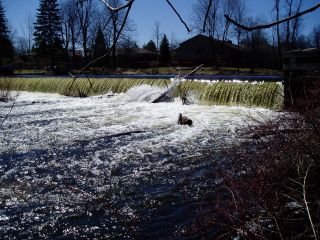
Tay River (main stem) Haggart Island dam in the Town of Perth (2007)
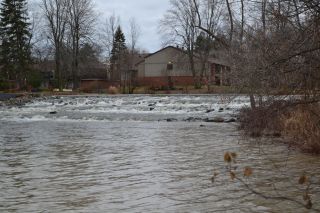
Tay River (main stem) rocky ramp installation in the Town of Perth (2017)
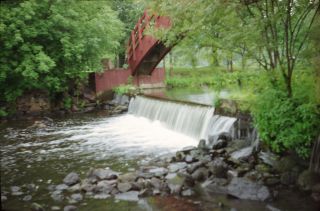
Tay River (Stewart Park side channel) Haggart Island dam in the Town of Perth (2007)
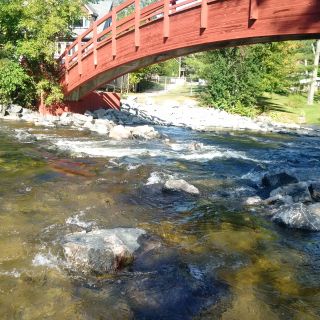
Tay River (Stewart Park side channel) rocky ramp installation in the Town of Perth (2015)
Funding for the two restoration projects was supplemented through a multi-party partnership between the Friends of the Tay Watershed Association, the RVCA and the Town of Perth. Friends of the Tay applied to the DFO Canada Recreational Fisheries Conservation Partnership Program and was the recipient of $90,000 in funding to assist with the installation of the Tay River rocky ramp structure.
5.5 Water Treatment
Drinking Water in the Town of Perth
The Town of Perth addressed the treatment of Process Water (organic and inorganic material returned to the Tay River) with the implementation of geotube bags. Process water is water that is laden with leaves, silt, clays, and other materials that are suspended in solution from the flocculation and filtering processes used in preparing drinking water. This material was traditionally returned to the Tay River downstream of the Water Treatment Plant intake.
Following a successful field trial and Environmental Assessment, the municipality advanced the implementation of the geotube back technology (Bishop Water Technologies- Eganville, ON) to remove solids from the discharged water. The processes involved the re-routing of process water into large porous geotextile bags that allow water to weep through the surface of the bag while retaining the solids inside the vessel. The three (3) large geotube bags are alternated daily to allow the solids enough time to dewater and consolidate throughout the seasons. One (1) of the bags is placed in a large greenhouse to allow filtering process to continue during freezing temperatures.
The municipality meets the guidelines of 15mg/l of Total Suspended Solids in the discharged water that returns to the Tay river. Since 2015 approximately 550 tonnes of solids are captured annually within the geotube system. This material is harvested from each of the geotube bags and transported to the Perth Landfill Site and used for daily cover of waste.
Sanitary in the Town of Perth
The Town of Perth completed the installation of the SAGR system (Submerged Attached Growth Reactor) at the Perth Wastewater Treatment Facility to address treatment capacity for the municipality. The SAGR (Nexom- Winnipeg, MB) is a biological process that involves aerated submerged beds that promote biological action that reduces E-coli, ammonia, and suspended solids from the wastewater discharged from the former lagoon system. Following a successful field trial in partnership with the Federation of Canadian Municipalities, the municipality constructed four (4) SAGR beds to increase treatment levels and develop capacity in Perth.
The SAGR system uses naturally-occurring biological processes that thrive in contained rock beds that are fed by air blowers to promote the breakdown of contaminates in sewage waste. The beds are fed liquid waste from the three (3) cell lagoon system and act to polish the waste before it is deposited into the Tay River. The system is designed to treat the wastewater generated from the equivalent population of 8200 people. As the population increases, the municipality can add one (1) further SAGR bed to a population of 10,500 people.
The SAGR has shown great successes with dramatic reductions of E-coli, ammonia, and suspended solids during operations in 2018 and 2019. The reductions in the system is equivalent or better than fully mechanized facilities without the use of chemicals, high energy costs, or mechanical systems.
Stormwater in the Town of Perth
The Town of Perth has been successful at securing a Small Communities Fund grant for the treatment of stormwater and the segregation of clean (rainwater, sump pump, and cooling water) from the sanitary sewer systems that have traditionally been routed into the sanitary sewer system. Though these water sources are being treated, the seasonal impacts on the sanitary sewer system has negatively impacted development capacity for Perth.
Perth has procured a Canadian product known as a CB Shield that inserts into catchbasins to reduce the velocity of stormwater and allow solids to be captured more effectively within the structure. Traditional large stormwater treatment systems require large acreage, designs, and approvals and the CB Shield is a drop-in unit that has the equivalent treatment capacity without the limitations of traditional treatment alternatives.
Perth will be installing approximately 120 treatment units at four (4) sub-watersheds directly depositing rainwater into the Tay River. The installation of these units will be installed in October/November prior to the frost/snow season to allow the treatment of stormwater early in 2020.
The additional challenge with Perth’s storm sewer system is the deposition of “clean” water from homes and businesses that direct sump pump water, roof drains, and cooling water into the sanitary sewer system. The placement of this type of water negatively affects the development capacity of Perth by increasing the annual volume of wastewater being treated at the Perth Wastewater Treatment facility. Perth was successful at implementing a new Sewer Use By-law and Sump Pump Disconnect program in 2019 to facilitate the reduction of water being placed in the sanitary sewer network. This program will financially assist homeowners by redirecting plumbing systems to the storm sewer, lawns, rain barrels, or infiltration beds to better address this volume of water in two (2) designated subdivisions in Perth.
5.5 Valley, Stream, Wetland and Hazard Lands
Perth Catchment Natural Hazards
The Perth catchment covers 21.4 square kilometres with 7.6 square kilometres (or 35.6 percent) of the drainage area being within the regulation limit of Ontario Regulation 174/06 (Figure 55), giving protection to wetland areas and river or stream valleys that are affected by flooding and erosion hazards.
Wetlands occupy seven square kilometres (or 32 percent) of the Perth catchment. Of these wetlands, four square kilometres (or 57 percent) are designated as provincially significant and included within the RVCA regulation limit. This leaves the remaining three square kilometres (or 47 percent) of wetlands in the catchment outside the regulated area limit.
Of the 35.1 kilometres of stream in the Perth catchment, regulation limit mapping has been plotted along 21.1 kilometers of streams (representing 60 percent of all streams in the catchment). Some of these regulated streams (10.2 km) flow through regulated wetlands; the remaining 10.9 kilometres of regulated streams are located outside of those wetlands. Plotting of the regulation limit on the remaining 14 kilometres (or 40 percent) of streams requires identification of flood and erosion hazards and valley systems.
Figure 55 Regulated natural features/hazards and Intake Protection Zones in the Perth catchment
Town of Perth Natural Hazards
The Town of Perth catchment covers 12.2 square kilometres with 5.4 square kilometres (or 44.3 percent) of the municipality being within the regulation limit of Ontario Regulation 174/06 (Figure 56), giving protection to wetland areas and river or stream valleys that are affected by flooding and erosion hazards.
Wetlands occupy 3.2 square kilometres (or 26 percent) of the Town of Perth. Of these wetlands, 2.8 square kilometres (or 86 percent) are designated as provincially significant and included within the RVCA regulation limit. This leaves the remaining 0.4 square kilometres (or 14 percent) of wetlands in the catchment outside the regulated area limit.
Of the 19.9 kilometres of stream (including the Tay River) in the Town of Perth, regulation limit mapping has been plotted along 18.1 kilometers of streams (representing 91 percent of all streams in the municipality). Some of these regulated streams (9.1 km) flow through regulated wetlands; the remaining 9.0 kilometres of regulated streams are located outside of those wetlands. Plotting of the regulation limit on the remaining 1.8 kilometres (or 9 percent) of streams requires identification of flood and erosion hazards and valley systems.
Figure 56 Regulated natural features/hazards and Intake Protection Zones in the Town of Perth
Within those areas of the Perth catchment (Figure 55) and the Town of Perth (Figure 56) subject to the regulation (limit), efforts (have been made and) continue through RVCA planning and regulations input and review to manage the impact of development (and other land management practices) in areas where “natural hazards” are associated with rivers, streams, valley lands and wetlands. Additionally, in areas of the Town of Perth where new development is planned (for the former golf course lands and annexed lands north of Dufferin St.), significant effort is made through land use planning and development control processes and carefully planned stormwater management systems, initially guided by master drainage planning and integrated subwatershed planning, to address the natural heritage, natural hazards and source/water quality policies presented in the Town of Perth Official Plan. Also, within areas beyond the regulation limit, protection of the catchment’s watercourses is provided through the “alteration to waterways” provision of the RVCA regulation.
5.6 Vulnerable Drinking Water Areas
The Town of Perth’s municipal drinking water Intake Protection Zone (IPZ), specifically IPZ-1 and 2 with vulnerability scores of 8, 9 and 10 are found within the Perth catchment (Figures 55, 56). As per the Mississippi-Rideau Source Protection Plan, policies may affect future development within these areas. Under Section 59 of the Clean Water Act, 2006, future applications under the Building Code and the Planning Act may be screened by the Mississippi-Rideau Risk Management Office. Depending on the proposed activity, additional requirements or restrictions may apply. For more information, please contact the Mississippi-Rideau Risk Management Office at (613) 692-3571.
In addition, the Mississippi-Rideau Source Protection Plan has mapped a small area of the Perth catchment as within a Significant Groundwater Recharge Area and identified all of the catchment as a Highly Vulnerable Aquifer. This means that the nature of the overburden (thin soils, fractured bedrock) does not provide a high level of protection for the underlying groundwater making the aquifer more vulnerable to contaminants released on the surface. Highly Vulnerable Aquifers characterise 89% of the Region and are considered moderate to low drinking water threats with certain policies that apply; mainly policies regarding waste disposal. All property owners are encouraged to use best management practices to protect sources of municipal drinking water. For more information on source protection best management practices, please visit Protecting Your Drinking Water.
6.0 Perth Catchment: Accomplishments
Achievements and activities noted by the Friends of the Tay Watershed Association (FoTW) are indicated by an asterisk.*
In-stream/Fish Habitat
4.6 kilometres of the Tay River in the catchment have been surveyed and seven headwaters sites are sampled once every six years by the RVCA using the Ontario Stream Assessment Protocol.
The report "Fish Habitat of the Tay River Watershed: Existing Conditions and Opportunities for Enhancement" was prepared in 2002 by MNR, RVCA, Parks Canada and DFO. A number of specific fish habitat enhancement projects are identified in the report to improve the fishery along the Tay River (see pp. 86-92). One such project identified along the reach of the Tay River in the Town of Perth includes the refurbishment of the two Haggart Island dams. Both of these structures have now been replaced with a rocky ramp on the Little Tay River (in 2015) and another one on the Tay River (in 2017)(see section 5.4 of this report).
Shoreline Planting
The Friends of the Tay Watershed and RVCA developed the Wendy Laut Ribbon of Life demonstration area in Last Duel Park alongside the Tay River. Recently, the Perth Horticultural Society has updated the area.*
4554 native trees and shrubs have been planted along 764 metres of shoreline at various locations along the Tay River in the Town of Perth with services provided by the RVCA Shoreline Naturalization Program.
Water Quality
Drinking Water
Following a successful field trial and Environmental Assessment, the Town of Perth advanced the implementation of the geotube back technology (Bishop Water Technologies-Eganville, ON) to remove solids from the discharged water. The processes involved the re-routing of process water into large porous geotextile bags that allow water to weep through the surface of the bag while retaining the solids inside the vessel. The three (3) large geotube bags are alternated daily to allow the solids enough time to dewater and consolidate throughout the seasons. One (1) of the bags is placed in a large greenhouse to allow filtering process to continue during freezing temperatures.
The Town of Perth meets the guidelines of 15mg/l of Total Suspended Solids in the discharged water that returns to the Tay River. Since 2015 approximately 550 tonnes of solids are captured annually within the geotube system. This material is harvested from each of the geotube bags and transported to the Perth Landfill Site and used for daily cover of waste. This process also prevented process water from being conveyed and treated at the Perth Wastewater Facility, which would inherently require capital costs in piping and pump stations as well as negatively affecting development capacity for the municipality.
Sanitary
The Town of Perth wastewater treatment facility is located on the south side of the Tay River, adjacent to the Tay Marsh. The outflow from the Perth sewage lagoons has impacted water downstream for decades. Outflow quality has, on the average, been within provincial limits, but inevitably has had an impact on the Tay Marsh and is one of (many) sources encouraging excessive vegetation growth in the wetland, which damages its fish and wildlife habitat. In response to concerns raised about the impact of the Town of Perth sewage lagoons on the Tay River and Tay Marsh, the Town has taken action over the years to reduce its effect on surface water quality in the system, which, from cursory observation has been beneficial, and more recently enhanced with an innovative phosphorus reduction system.*
Further to this observation, it is stated in the Infrastructure Master Plan for the Western Annex in the Town of Perth (Jp2g Consultants, Jan.2019) that, since 2007, the Town has undergone an intensive wet weather flow reduction program, including sealing and repair work of sewers, elimination of combined sewers and sealing and elevating manholes. These efforts have successfully reduced average inflows to the lagoon and the wet weather program is continuing with further improvements expected.
Perth completed the installation of the SAGR (Submerged Attached Growth Reactor) system in the fall of 2018. This $11 million project focused on providing tertiary treatment to the Town's existing wastewater lagoon system and has also increased the development capacity of the municipality to an equivalent of 8200 residents. Results throughout 2019 have shown dramatic decreases in E-coli, ammonia, total suspended solids, and ammonia levels using the new treatment system. The SAGR uses aeration and naturally-occurring biological processes to breakdown and polish sewage waste without chemicals or the need for mechanical processes.
Stormwater
In collaboration with the Town of Perth, the Friends of the Tay Watershed sampled stormwater during the first flush of a rain event on 29 September 2015. Thirty samples were taken during this single event from six access points along the lower five blocks of the Town of Perth’s Wilson Street Stormwater Drain, from Leslie Street to Herriott Street, adjacent to the outfall into the Little Tay River. Samples were analysed for E coli, Fecal Strep, Total Suspended Solids, Phosphates, Total Kjeldahl Nitrogen, and Sodium. Additionally, temperature at capture, pH, Colour, Alkalinity and Turbidity were measured and recorded by Town of Perth Water Treatment Plant staff. Further information has been gathered about the extent of contaminant levels in local storm water in the Wilson Street Stormwater Drain. The sources of contamination appear to be from the washing of large, more heavily trafficked paved surfaces, such as parking lots and major roads. No particular trends were displayed along the length of the Drain studied. Besides indicating the sources and extent of E. coli content in the system, this assessment raises additional concerns needing further study, including the consequences of river contamination by the nutrients and suspended solids discharged with urban storm water.*
Swimming
The Friends of the Tay Watershed sampled three sites along the Tay River in 2013, all popular swimming spots in Perth. All showed high levels of E. coli after rain but not before; likely due to untreated stormwater being channelled quickly into the Tay River. Before rain event E. coli levels were higher even though temperatures were a little lower, possibly due to more and heavier rains resulting in near-flooding conditions along the Tay River and strong water currents. In mid-September 2014, three more sites were sampled by FoTW along the Tay River in Perth. Ten samples were taken in close proximity to two storm sewer outflows. Five more samples were taken farther downstream in Perth, but not near any stormwater outflows. All were taken within an hour of the start of light rain and the arithmetically averaged geometric mean from the test samples was 993 units of E. coli per 100 ml of water. All of the previously elevated E. coli counts had returned to “normal” levels close to or within the safe-to-swim limit of 100 units of E. coli per 100 ml. of water, 24 hours after the rain had stopped, with an average geometric mean of 83 E. coli per 100 ml. of water. All samples taken near the outflows were much higher than those taken some distance from any outflow. These findings complete the FoTW testing picture that shows consistently low and swimmable levels of E. coli before rain events and also within 24 hours of a rain event, but that levels of E. coli are, however, consistently higher even after a light rain and dangerously high near storm sewer outflows.*
The 2011 Perth Catchment Report and water testing records for the Town of Perth have been a major help in monitoring and determining activity in this sector. As in any urban area, Perth has an impact on the water quality in its Tay River. The Town has generally taken this seriously and attempted to mitigate it, with innovative and environmentally sensitive approaches. Both RVCA and the Friends of the Tay Watershed Association have presumably been instrumental in pointing out need and have cooperated with the Town of Perth in determining and following up actions.*
Three stream monitoring sites on the Tay River in the Town of Perth are sampled yearly by the RVCA for 22 parameters at each location, six times a year, to assess surface chemistry water quality conditions.
Eighteen Rural Clean Water Program projects were completed by the RVCA Rural Clean Water Program.
Watershed Planning and Management
The Tay Watershed Management Plan (2002) brought together a diverse group of watershed stakeholders to exchange information and opinions on the challenges facing the watershed. This forum focused the community on the need for managing the Tay Watershed, requiring positive cooperation amongst a range of stakeholders and helped develop a foundation of data and information on the watershed and resources against which later developments and trends are being measured and decisions are being made.
The Plan also led to the formation of the Friends of the Tay Watershed Association, who have been instrumental in implementing 20 of 24 management plan recommendations. In the opinion of the Association, one of the most significant measures of success for the water protection activities carried out in the Tay watershed is that there has never been a serious environmental pollution incident that threatened the area’s drinking water or its recreational waterbodies. To this day, the Friends of the Tay Watershed remain committed to preserving and enhancing the health of the Tay River watershed through their work, including:
- Building an understanding of the Tay River and promoting the Tay Canal and need for its care. RVCA catchment reports have played a major role in this by documenting it and its needs.
- Increasing awareness of the Tay Wildlife Reserve, helping promote the Butterfly Garden at the Reserve (in the 2009 Anniversary celebration), researching the Canal’s history and documenting it in an interpretive panel at the Reserve, and working with RVCA in placing a canoe/boat dock at the Reserve. The launch of the Tay Canal tour boat, by private individuals, was done to provide a means of bringing residents to the Tay River and Canal, and educating them about it.
- Bursaries to high school students proceeding to an environment degree as well as continuing post-secondary students.
- Development of interpretive panels for Source Water Protection (eg. Glen Tay catchment area) and the Tay River viewpoint (along the Tay Trail).
- Environmental Awards.
- Outreach to children and schools as well as the public through initiatives such as the Perth Maple Fest, the Stewart Park Festival and the Association's annual Tay Watershed Discovery Day that increases awareness of the importance of the Tay River and area lakes to the health of the Tay Watershed.
- Submissions to government on regulatory reviews (eg. Climate change action; Conservation Authority Act) and the Rideau Canal Management Plan.
- Support to other environmental, watershed organisations (e.g., Lake Links, Lake Networking Group).
7.0 Perth Catchment: Challenges/Issues
Development
Annexed lands to the west (a.k.a Perth golf course and TayView properties) and north (a.k.a. Blueberry Creek lands) are being prepared for future development. These areas are substantial and will pose a significant challenge to the Town of Perth and landowners proposing to develop those lands in a manner that is consistent with the Official and Strategic Plans for the Town of Perth.
Many existing waterfront properties contain existing non-conforming dwellings with respect to minimum water frontage and lot area and are often located within 30 metres of the water that require minor variances for expansion and/or reconstruction of dwellings where standard development setbacks from water are difficult to achieve. In these cases, staff at Drummond/North Elmsley Township, the Town of Perth and the Conservation Authority often meet with resistance and push back when attempts are made to implement standards for development setbacks, vegetated shorelines and septic systems.
Monitoring implementation of conditions of planning and regulatory approvals is challenging due to a lack of resources.
Headwaters/In-stream Habitat/Shorelines
Watercourses (Tay River, headwater and tributary streams) in the Perth catchment have 68 percent of the total length of their shoreline composed of natural vegetation (see Section 4.4 of this report). This is below the 75 percent target that is recommended by experts for the catchment’s watercourses, 30 metres back from both sides of a stream, river or lake.
Headwater and tributary streams (excluding the Tay River) in the Perth catchment have 72 percent of the total length of their shoreline composed of natural vegetation (see Section 4.4 of this report). This is below the 75 percent target that is recommended by experts for the catchment’s watercourses, 30 metres back from both sides of a stream, river or lake.
The Tay River flowing through the Perth catchment has 51 percent of the total length of its shoreline composed of natural vegetation (see Section 4.4 of this report). This is below the 75 percent target that is recommended by experts for the catchment’s watercourses, 30 metres back from both sides of a stream, river or lake.
The Tay River flowing through the Town of Perth (within the municipal boundary) has 49 percent of the total length of their shoreline composed of natural vegetation (see Section 4.4 of this report). This is below the 75 percent target that is recommended by experts for the catchment’s watercourses, 30 metres back from both sides of a stream, river or lake. This condition is recognized by the Friends of the Tay Watershed who note that riparian naturalisation is inadequate in some areas of the Town, including residential areas on the right bank of the Tay River and municipal owned property along its left bank in Code and Stewart Parks.
An increase in the area of settlement (0.41 ha.) and crop and pastureland (0.81 ha.) along headwater and tributary streams of the Tay River has been observed between 2008 and 2014, due to a loss of woodland.
Three of seven sampled headwater sites have been modified (two are channelized, one is a roadside ditch; see Section 3.4.2 of this report).
Land Cover
Woodlands cover 14 percent of the Perth catchment and 13 percent of the Town of Perth. This is below the 30 percent of forest cover that is identified as the minimum threshold for sustaining forest birds and other woodland dependent species (see Section 4.2 of this report).
Land cover has changed across the Perth catchment (2008 to 2014) largely as a result of an increase in the area of settlement (nine ha.) and loss of crop and pastureland (6 ha.), woodland (2 ha.) and crop and pasture (1 ha.)(see Section 4.1 of this report).
Wetlands in the Perth catchment have declined by forty-four percent since European pre-settlement and now cover 32 percent (682 ha.) of the area (Figure 50). Thirty-seven percent (253 ha.) of these wetlands remain unevaluated/unregulated and are subject to the threat from development activity, drainage and land clearing activities in the absence of any regulatory and planning controls that would otherwise protect them for the many important hydrological, social, biological and ecological functions/services/values they provide to landowners and the surrounding community (see Section 4.3 of this report).
Wetlands in the Town of Perth have declined by fifty-seven percent since European pre-settlement and now cover 26 percent (322 ha.) of the area (Figure 51). Fourteen percent (46 ha.) of these wetlands remain unevaluated/unregulated and are subject to the threat from development activity, drainage and land clearing activities in the absence of any regulatory and planning controls that would otherwise protect them for the many important hydrological, social, biological and ecological functions/services/values they provide to landowners and the surrounding community (see Section 4.3 of this report).
Water Quality
Working with staff from the Town of Perth, members of the Friends of the Tay Watershed Association sampled stormwater from the rain event on 29 September 2015 from a number of locations along the Wilson Street Stormwater Drain. Additional information was gathered about the extent of contaminant levels in the Drain's stormwater. The sources of contamination appear to be from the washing of large, more heavily trafficked paved surfaces, such as parking lots and major roads. No particular trends were displayed along the length of the Drain studied. Besides indicating the sources and extent of E. coli content in the system, this assessment raises additional concerns needing further study, including the consequences of river contamination by the nutrients and suspended solids discharged with urban storm water.
Surface chemistry water quality rating along the Tay River through the Town of Perth ranges from Fair to Good at the Rogers Road, Gore Street East and Craig Street crossings.
Instream biological water quality conditions along the Tay River through the Town of Perth are unknown because no suitable benthic invertebrate locations exist to survey in the catchment.
8.0 Perth Catchment: Actions/Opportunities
The Town of Perth is the focal point of the Perth catchment drainage area. It is a local and regional centre that offers employment and many important services to residents of the Town and the Tay Watershed. In the past, the Town relied heavily on its land and water resources to provide a living for town folk. This reliance continues today, albeit in a similar but somewhat different form. Furthermore, it is recognised that these land and water resources contribute to the Town's identity as a multi-faceted community with a small town atmosphere, where people like it for its size, friendliness, quietness, safety, beauty and proximity to nature. All of these factors make it a much desired place to live, work and play.
Perth has an established interest and commitment to environmental stewardship. The basic premise for community sustainability is that environmental health is critical to human beings and to the wide diversity of plant and animal species with which we co-exist. The quality of its communities and standard of living depends on the air we breathe and the water that we drink, as well as the quality of the soil in the backyards where we play and in the fields and gardens from which our food is produced. In the coming years, human prosperity will depend on the health of the natural environment and the quality of human managed spaces.
The Official Plan of the Town of Perth contains many policies to address this vision and the aspirations of Council and the citizens of the Town of Perth, who recognise that protecting and nurturing a healthy environment through environmental stewardship is a community imperative for the benefit of current citizens and as a legacy to future generations. Accordingly, land use decisions (and subsequent land management practices) should strive to find ways and means to improve or enhance the quality and vitality of both the human dominated and natural environment and should not simply maintain the status quo. The Town of Perth Strategic Plan also contains a number of strategic initiatives to support this vision.
Many of these policies are aligned with RVCA's strategic interests (as described in its 2020 Strategic Plan) and complement its watershed resources management efforts across the Rideau Valley Watershed, including those described in the Tay River Subwatershed Report (2017) and Perth Catchment Report (2017).
The introduction to this section of the report along with the following list of actions/opportunities includes a number of passages/provisions taken from the Town's Official and Strategic Plans, which are presented as actions to help Perth achieve its vision for the long-term, sustainable environmental stewardship of its land and water resources.
8.1 Development
8.1.1 Town of Perth
Perth's vision for development embraces the concept of sustainable community development through land use and infrastructure development decisions and operational practices that integrate human needs with the natural and built environment. Land use approvals and infrastructure redevelopment decisions will include sustainable design measures for transportation, infrastructure, waste management, energy systems and will strive for the efficient use of natural resources and preservation of historic, cultural and natural heritage features. The vision intends to be adaptive to innovative design and human activities that support sustainability (O.P. 1.2.17).
Perth's comprehensive and sustainable approach to development requires that new Greenfield areas and larger development sites (including the new neighbourhoods planned for the Western Annexed Lands and north of Dufferin Street) are planned in an integrated and holistic manner, which recognises and accounts for natural hazards and natural heritage systems. This includes:
8.1.1.1 Council's consideration of development in the new residential areas planned for the Town, prior to the development of existing residential areas, when the proponent submits a comprehensive plan and supporting studies that address a number of land use matters, including the following provisions addressing the Town's vision for environmental stewardship (O.P. 5.2.F):
- integration of storm-water management facilities and drainage and grade controls;
- conservation of natural heritage features and areas and/or measures to mitigate the impact of development on these features;
- compliance with applicable Conservation Authority regulations and provincial requirements with respect to avoidance of flooding hazards; and avoidance of other natural hazards consistent with the Provincial Policy Statement.
8.1.1.2 Council's consideration of large scale development or the initial phase of development on lands with potential for additional development, whereby such applications shall submit a sustainable design report that demonstrates (O.P. 5.9.3.6.):
- how a proposed development will sustain sensitive natural heritage features or retain character defining natural features of a site such has hedgerows or stands of healthy, mature, indigenous trees;
- a sustainable building or project design that addresses or creates interconnectedness between natural features, the site topography, the surrounding landscape and the intended built form;
- a cohesive and sequential relationship of the development project to existing or planned development on adjacent properties, including the integration of infrastructure and utilities and will include energy conservation features.
8.1.1.3 Council's use of Low Impact Development (LID) measures, including (O.P. 5.9.3.5.):
- minimising excavation, compaction and grade/slope alterations;
- reducing hard surfaces and increasing porous surfaces;
- maximising site biomass through generous landscaping and/or retention/restoration of vegetation cover;
- using runoff water on site to reduce demand for outdoor watering or to reintroduce/support naturalized habitats;
- designing building envelopes to optimise the retention of natural features, retain soil and vegetation cover, reduce or minimise hard surfaces or replace with porous surfaces, retain and recycle storm-water;
- reducing the consumption of water resources through low-use water fixtures, reuse of grey water/wastewater, harvesting and recycling rainwater, use of swales, using low water demand and drought resistant plants for landscaping, etc.
8.1.2 Perth Catchment
Work with approval authorities (Town of Perth, Township of Drummond/North Elmsley, Lanark County, Leeds Grenville and Lanark District Health Unit and the Mississippi Rideau Septic System Office) and waterfront property owners to consistently implement current land use planning and development policies for in-stream aquatic habitat, shoreline protection and surface water quality adjacent to, and in the Tay River and its tributaries (i.e, a minimum 30 metre development setback from water).
Explore ways and means to more effectively enforce and implement conditions of land-use planning and development approval to achieve net environmental gains (particularly with respect to rehabilitating or protecting naturally vegetated shorelines and water quality).
Encourage the Committee of Adjustment/Land Division Committee to take advantage of technical and environmental information and recommendations forthcoming from planning and environmental professionals.
Use the Tay River Subwatershed Report 2017 and this Perth Catchment Report 2017 to help develop/revise official plan policies to protect surface water resources and the natural environment (including shorelines, wetlands, woodlands and in-stream habitat).
8.2 Shorelines
8.2.1 Town of Perth
The Tay River and its tributaries, the Blue Berry Creek and Grant’s Creek, are natural heritage resources that serve an important ecological function within the watershed as well as an aesthetic enhancement to residents and visitors to the Town of Perth. Urban land uses and urban activities have compromised the ecological function of the riparian zone of the Tay and to a lesser extent its tributaries. The Official Plan provides for the restoration and rehabilitation of the shoreline of the Tay River and protection of shoreline areas through an integrated management approach. Council intends to achieve this through the application of the following Shoreline Management measures (O.P. 8.6.4.g.):
- Along the shoreline of the Tay River/Canal natural vegetation will be maintained, enhanced or improved. Where alterations are proposed in shoreline areas they shall be carried out with professional advice and shall meet the requirements of the Conservation Authority and the Ministry of Natural Resources and Forestry;
- Support the recovery and restoration of the ecological function of the riparian zone of all shoreline areas in the Town through public education, cooperation with programs of the Rideau Valley Conservation Authority and through site plan approvals that support the reinstatement of aquatic and wildlife habitat and linkages;
- Shoreline areas in Stewart Park and the Last Duel Park should be naturalized to the greatest extent that is practical while retaining accessibility for the current level of passive and active recreational use and upholding the valued aesthetic appeal of Stewart Park. This will be achieved through a phased program of replanting using native riparian plant species; particularly when projects for restoring or rehabilitating eroded and degraded shoreline areas provide opportunity to replace artificial shoreline stabilisation measures with lower maintenance, self perpetuating, vegetation based solutions;
- Reduce or replace hard surfaces adjacent to the shoreline (in instances) which lead to uncontrolled runoff into the Tay River/Canal;
- Require increased setbacks from the shoreline for new buildings;
- Require proponents of construction projects to prepare, implement and monitor erosion and sediment control plans as a condition of development approval;
- Apply best storm-water management practices and require compliance with the storm-water management policies of this Plan;
- Work with neighbouring municipalities, stewardship organisations and the public to raise public awareness of the value of shoreline management, and to implement the recommendations of the Tay River Watershed Management Plan and subsequent and related documents (Fish Habitat of the Tay River Watershed: Existing Conditions and Opportunities for Enhancement 2002; Perth Catchment Report 2017; Tay River Subwatershed Report 2017).
Council's specific requirement is that development adjacent to a water-body will (O.P. 7.7.2-3.):
- Only be considered for new lots where the building and development site will be setback a minimum of 30 metres from the Shoreline Standard Elevation. Within the 30 metre setback, measures will be taken to ensure no disturbance of native soils or grades and to ensure removal of shoreline vegetation will be kept to a minimum;
- Comply with zoning requirements on existing lots of record to ensure a minimum 30 metre setback from the Standard Shoreline Elevation. Where the depth of an existing lot is such that this setback cannot be applied, development similar to or smaller than the scale of existing development on adjacent lots may be considered, but shall be placed as far from the water as possible. Reconstruction should be no closer to the shoreline and no more extensive than the existing building. Enlargement of the existing building foot print should be at the minimum 30 metre setback. A lesser setback may only be considered where the vegetated portion of the lot will exceed 35 percent, and most of the shoreline setback is either covered by existing native vegetation or will be covered by ensuring restoration of native vegetation.
Consider a partnership between the Town of Perth, Perth Horticultural Society, Friends of the Tay Watershed (FoTW) Association and RVCA to publicise and promote the shoreline naturalization methods used in the Wendy Laut Ribbon of Life demonstration area in Last Duel Park to address the degraded shoreline of the Tay River in Code and Stewart Parks and privately owned lands along the right bank of the Tay River (including dissemination of information about the value of natural shorelines and riparian program assistance)(FoTW per.comm.).
8.2.2 Perth Catchment
Take advantage of the RVCA Shoreline Naturalization Program to re-naturalize altered shoreline along the Tay River and its tributary streams identified in this report as “Unnatural Riparian Land Cover". Concentrate stewardship efforts along Tay River waterfront properties shown in orange on the Riparian Land Cover map (see Figures 52-53 in Section 4.4 of this report).
Promote the use of bioengineering methods (using native shrub/tree planting, fascines, live stakes) as a shoreline erosion mitigation measure as well as a cost effective alternative to shoreline hardening (with rip rap, armour stone, gabion baskets, walls).
8.3 Water Quality and Quantity
8.3.1 Town of Perth
Council's intent is that community sustainability in the Town of Perth is to be guided by the principle of conserving and, wherever feasible, enhancing and improving the quality of surface and groundwater sources and municipal drinking water supplies (O.P. 5.9.3.1.). Specific policies to address this provision include:
8.3.1.1 Council's intent to participate in the development of a watershed management plan (Tay River Watershed Study or other such works such as the Tay River Subwatershed Report (2017) and Perth Catchment Report (2017) as a means to identify the characteristics of water resources and to develop water quality goals and targets as the basis for the long term comprehensive management of these resources. It is recognised that this will impact on current storm water management practices in the Town and may lead to development controls or restrictions designed to maintain or improve water quality (e.g. detention ponds, pre and post flow controls, vegetation standards, infiltration techniques, treatment etc.). This may also lead to the development of a master drainage plan and a series of best management practices (O.P. 5.3.B.).
8.3.1.2 Council’s policy that stormwater management shall be required for all urban development as a preventative approach (rather than relying solely on end-of-pipe quality control) to protect surface water resources. Council's specific intent regarding this matter is to utilise the following principles in its approach to stormwater management (O.P. 5.3.C.). The RVCA strongly advocates for pre-consultation during the stormwater planning and design process:
- That natural hydrological characteristics are maintained, and where possible, enhanced as the means to protecting the base flow of watercourses;
- That the natural infiltration of water on lands which are developed is maximised;
- That proposed development will not result in increased downstream flooding or erosion or cause adverse effects on receiving waters by appropriate management of storm-water volumes and contaminant loading;
- That alterations to natural drainage systems are prohibited or at least minimised by maximising the retention of natural vegetation and by leaving stream channels in their natural form;
- That sanitary and storm water sewers are separated;
- That fish and wildlife habitat is protected, enhanced or restored including habitat linkages where affected by the discharge or outlet of drainage facilities;
- That a sustainable environmental approach is utilised in protecting water resources;
- That water quality will be monitored on an ongoing basis as the means to evaluating the effectiveness of storm water management practices;
- That the implications of new drainage and stormwater systems on Source Water Protection will be investigated, particularly with respect to discharges to Blueberry Creek and the Tay River along with any protection plans studies, policies or regulations established by the Province, the Town of Perth or other authorities.
8.3.1.3 Council's intent to incorporate stormwater management controls into the development review and approval process. Proponents of development will be required to plan for and undertake storm water management which complies with the above principles as well as any master drainage plan. This may require a subwatershed management plan for large tracts of land or a storm water site management plan. Proponents may utilise best management practices where they are consistent with and will achieve the Town's water quality and quantity targets (O.P. 5.3.D.).
8.3.1.4 In the interim (prior to the development of a master drainage plan), Council will expect proponents to assess the impact of the development on the receiving stream and to utilise a mix of site level, conveyance and end-of-pipe best management practices for the development (O.P. 5.3.E.).
8.3.1.5 Improvements to storm sewer mains (e.g. replacement or extensions) are anticipated as part of the regular program of maintenance by the Town and are deemed to comply with the Official Plan (O.P. 5.3.F.).
8.3.1.6 Council's cooperation with other levels of government and the private sector to upgrade drainage and storm water management systems to reduce contaminant and other discharges into the Tay River and its tributaries with priority given to discharge locations where water quality impacts are identified or the best water quality improvement outcomes can be achieved (O.P. 8.6.4.g.).
8.3.2 Perth Catchment
Consider further investigation of the Fair to Good surface chemistry water quality ratings on the Tay River at the Craig Street and Rogers Road monitoring sites, as part of a review of RVCA's Watershed Watch, Baseline and Benthic Invertebrate surface water quality monitoring.
Educate waterfront property owners living along the Tay River and its tributaries in the Perth catchment about septic system care by providing information about sewage system maintenance (i.e., when to pump out septic systems and holding talks) through initiatives such as the Septic Savvy Workshop.
Protect the water resources of the Tay River and Canal through implementation of the Town of Perth's, Township of Drummond/North Elmsley's and agency (Lanark County, Leeds Grenville and Lanark District Health Unit, Mississippi Rideau Septic System Office, MOE, MNR, RVCA) land use planning and development policies, practices and standards.
Promote efforts to reduce pollutant loadings to the Tay River and Canal through application of agricultural, shoreline, stormwater and wastewater best management practices; also consider using low impact development (LID) methods to improve the quality and reduce the amount of stormwater runoff reaching the Tay River ecosystem. This will be particularly beneficial in areas with extensive impervious surfaces (i.e., asphalt, concrete, buildings, and severely compacted soils) or on sensitive waterfront properties (with steep slopes/banks and/or shallow, impermeable soils).
Offer septic system project funding provided by the Rideau Valley Rural Clean Water Program to landowners in the Perth catchment with septic systems needing maintenance/remedial work or replacement.
8.4 Aquatic Habitat/Fisheries/Land Cover/Natural Heritage System
8.4.1 Town of Perth
The application of the Official Plan policies for natural heritage are designed to conserve the ecological values of existing significant natural heritage features and to enhance the biodiversity and integrity of natural heritage attributes such as wildlife corridors and connectivity through land use planning decisions. The intent of these policies is to strengthen the natural heritage system as an integral component of the Town’s land use pattern (O.P.8.6.1), while pursuing a program that integrates the principles of community sustainability with community development and redevelopment. The program will be guided by the following select set of initiatives and policies that the RVCA supports:
- Maintaining the integrity of existing ecosystems through the conservation and improvement of habitat for flora and fauna and wildlife linkages and corridors. Existing sensitive ecosystems and wildlife corridors will be respected and to the greatest extent feasible, the intent will be to improve the biodiversity (species composition and abundance) of plant and animal species in protected areas through conservation and compensation measures implemented or assured through planning and development approvals (O.P. 5.9.3.1.ii.);
- Reducing the municipality’s carbon footprint by programs to improve the health and the extent of urban forest; maximising the retention of vegetation cover, particularly tree cover and hedge rows in land and infrastructure development; also through improvements to river corridors, road allowances and parkland in the Town (O.P. 5.9.3.1.iv);
- Creating/practising a Tree Planting Program for all suitable municipal properties that complement the natural environment. Consider native trees, enabling the restoration of our natural biodiversity (Perth Strategic Plan 2.6.A);
- Emphasising designs that restore impaired habitats, rehabilitate brownfield sites, and conserve the continuity of existing ecosystems (O.P. 5.9.3.4.vii.);
- Designing to respect or allow natural movement corridors to permit movement or migration of animals, plants and natural processes such as seasonal fauna movements or preserving water channels under built features (O.P. 5.9.3.5.vii.);
- Maximising site biomass through generous landscaping and/or retention/restoration of vegetation cover (O.P. 5.9.3.5.ix.);
- Avoiding or minimising adverse effects on natural heritage features from development on adjacent lands (O.P. 8.6.3.a.);
- Identifying and protecting lands encompassing natural heritage features through the appropriate classification of such features and appropriate setbacks for development (O.P. 8.6.3.b.);
- Ensuring appropriate impact assessment is undertaken and mitigating measures are implemented (O.P. 8.6.3.c.);
- Encouraging restoration of previously disturbed lands and the establishment of adequate buffering of sensitive natural heritage features (O.P. 8.6.3.d.);
- Recognising and respecting Provincially Significant Wetlands as ecosystems which are important as habitat for a variety of plant and animal species, for water quality, flood control and water storage and recharge areas and for their passive recreational value. Development and site alteration shall not be permitted in the Perth Long Swamp, the Blueberry Creek Wetland, and the Grant’s Creek Wetland. Development and site alteration shall not be permitted on adjacent lands to these significant wetlands unless it has been demonstrated through the preparation of an Environmental Impact Study (EIS) that there will be no negative impacts on the natural features or on the ecological functions for which a specific wetland area is identified (O.P. 8.6.4 b.1-2.);
- Recognising that the main channel and tributaries of the Tay River/Canal, Grants Creek and Blueberry Creek watersheds within the Town contain fish habitat and shall be protected to retain their fish habitat values. Development and site alteration shall not be permitted in fish habitat except in accordance with provincial and federal requirements. Development and site alteration shall not be permitted on adjacent lands to fish habitat unless it has been demonstrated through the preparation of an Impact Assessment (EIS) that there will be no negative impacts on the natural features or on their ecological functions. In undertaking and approving development the Town will provide for a net gain of productive capacity wherever possible. More specifically, development and site alteration in and adjacent to fish habitat shall not result in: a) a net loss of fish habitat; b) the harmful alteration, disruption, degradation or destruction of fish habitat, and c) restriction of fish passage (O.P. 8.6.4 c.1-2.).
8.4.2 Perth Catchment
Educate waterfront property owners about fish habitat requirements, spawning timing and near-shore and in-water activities that can disturb or destroy fish habitat and spawning sites.
Work with various partners, including the Town of Perth, Drummond/North Elmsley Township, landowners and the Friends of the Tay Watershed Association on fish habitat enhancement projects in the Tay River watershed, building off of new knowledge and the recommendations as described in the report "Fish Habitat of the Tay River Watershed: Existing Conditions and Opportunities for Enhancement" (2002) prepared by MNR, RVCA, Parks Canada, and DFO.
Municipalities in the Perth catchment along with provincial agencies are encouraged to strengthen natural heritage and water resources official plan policies and zoning provisions (water setbacks, frontage and naturalized shorelines and wetland protection) where deemed appropriate.
8.5 Natural Hazards
8.5.1 Town of Perth
Natural and human-made hazards are conditions which may affect public health and safety. In the Town of Perth Planning Area, these include flood prone lands, areas susceptible to erosion, contaminated sites and noise and vibration. Some of these conditions exist in the natural environment, while others are human-made. The intent of the Plan is to ensure that where development occurs, it does not become a threat to public health and safety (O.P. 7.1).
Council's goal for natural and human-made hazards is to ensure that all development has a high regard for public health and safety through mitigating adverse effects (as defined in O.P. Section 10.2) or by prohibiting development in unsafe places (O.P. 7.2).
Council’s specific intent regarding flood plains is to protect the safety of residents and avoid undue damage of land through policies to control development in the flood plain, as follows (O.P. 7.3.2):
- The flood plain in Perth is recognised as representing the 1:100 regulatory flood level (One Zone Concept);
- Lands at or below the regulatory flood level are considered to be in the flood plain and are subject to flooding;
- No new buildings are permitted to be constructed within the flood plain except flood control structures, or low impact buildings or structures such as a gazebo, dock, garden or small storage shed or utility structures, if permitted by the applicable flood plain regulation. Other public and private activities including the construction of roads, or new structures necessary for conservation, public recreation (recreational trails, tow path), water supply, waste water management, will be permitted in the flood plain subject to the approval of Council, the Conservation Authority and where deemed necessary, shall meet a flood proofing and access standard.
- In areas (i.e. within the prescribed fill and construction lines shown on Schedule ‘A’, Land Use Plan) where ‘Fill, Construction and Alteration to Waterways’ regulations have been established under the Conservation Authorities Act, a permit shall be required for:
- the construction, reconstruction, erection or placing of a building or structure of any kind;
- any change of use to a building or structure that would have the effect of altering the use or potential use of the building or structure, increasing the size of the building or structure or increasing the number of dwelling units in the building or structure;
- site grading, or
- the temporary or permanent placing, dumping, or removal of any material, originating on the site elsewhere.
- A permit shall also be required for changing the channel of any water body or diverting a water course.The permit shall be obtained from and to the satisfaction of the Rideau Valley Conservation Authority in addition to any permits which may be required from the Town of Perth. In general, development of any kind which limits the flood capacity or the flood way, or obstructs the flood way within any prescribed fill and construction lines shall be discouraged or prohibited.
RVCA will continue to assist and support the Town of Perth with efforts to incorporate flood-risk safety considerations into the Town’s planning and decision making processes (as per the above O.P. policies) to reduce the exposure of existing and new development to flood hazard risks associated with development in and adjacent to natural hazard areas along the Tay River and elsewhere in the catchment. To be effective, this approach will require an update to the Town of Perth Comprehensive Zoning By-Law (Oct. 2000) to clearly show the floodplain constraint on the Zoning Map or Schedule A of the ZBL along with ongoing education regarding the regulatory floodplain and dialogue about its effect on development related activity.
8.5.2 Perth Catchment
Establish RVCA regulations limits around the 38 percent (253 ha.) of wetlands in the catchment that are unevaluated. Doing this will help protect landowners from natural hazards including mitigating surface water flow by storing water during periods of peak flow (such as spring snowmelt and heavy rainfall events) and releasing water during periods of low flow (this mitigation of water flow reduces flood damage), as well as contributing to the stabilisation of shorelines and to the reduction of soil erosion damage through water flow mitigation and plant soil binding/retention.
The Friends of the Tay Watershed Association has developed the Tay Net (Tay Waterway Communication Network) over the past two years to provide early notice of significant changes in water level along the Tay River. Tay Net is now developing it into a ‘Riverwatch’ program for the waterway.
